The precious metals complex has enjoyed a nice run in recent months.
GDX has gained 25% since the September lows while GDXJ has gained 22% since its November low. Gold has rallied over $100/oz since its October low and Silver has surged in recent weeks.
The Gold community is getting excited again. They think the equity market is doomed and Gold has started a real bull run. That may be true but in the interim there are questions on the sustainability of recent strength.
Below we plot GDX with its advance decline (A/D) line and its RSI indicator. We already know that the A/D line has been carrying a few negative divergences.
With respect to RSI, typically in a strong, trending move it will surpass 70 (sooner rather than later) and that indicates strong momentum which implies some sustainability.
As GDX tests its 400-day moving average, it is lacking strong breadth and strong momentum.
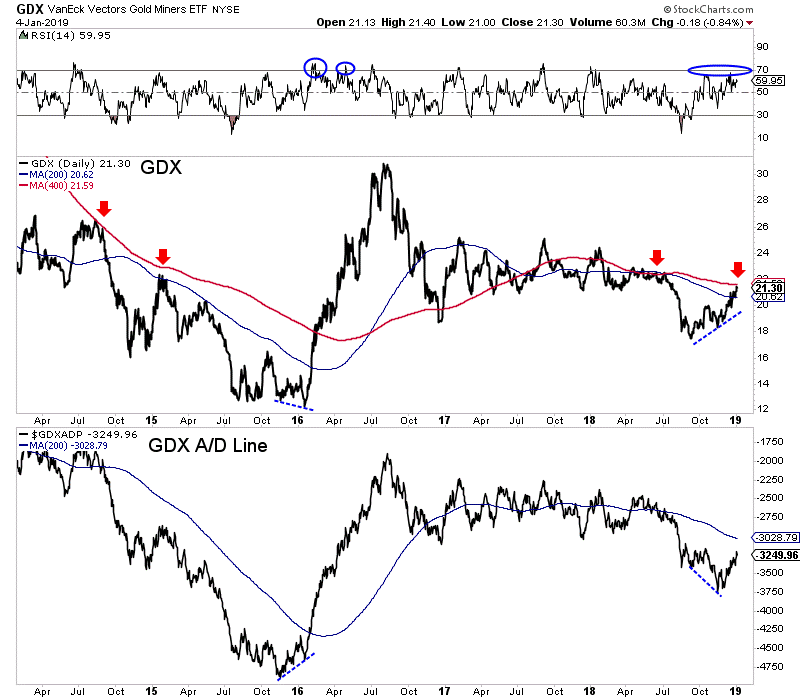
Meanwhile, Gold finally reached an RSI of +70 but after it occurred Gold formed a bearish reversal at strong resistance at $1300. That is why we want momentum to reach overbought conditions sooner rather than later.
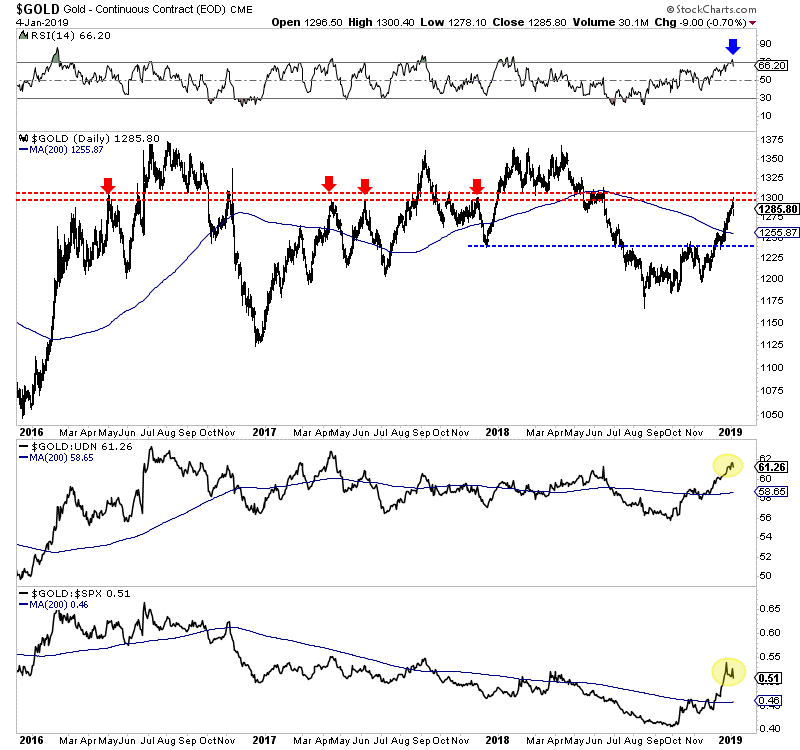
Silver (not shown) formed a similar bearish reversal as it approached resistance at $16.00.
Precious metals have tested resistance but with a lack of strong momentum and strong breadth. This implies that recent strength is probably not immediately sustainable.
Can precious metals digest and maintain recent gains or will they give most of them back as has been the case for years and years?
Assuming precious metals correct and consolidate, then there are multiple things we want to watch including breadth and relative strength against stocks and foreign currencies. In addition, we also should watch how the miners perform relative to Gold.
If Gold pushes past $1300 and the gold stocks surge past their 400-day moving averages it would signal a change in character for the market. At that juncture it would difficult to argue against a bull market.
In any case, it is not wise to chase strength until we get more evidence that a bull market has started. There will be plenty of time to get into cheap juniors that can triple and quadruple once things really get going. Note that many juniors began huge moves months after lows in January 2016, October 2008, May 2005 and November 2000. To prepare yourself for some epic buying opportunities in junior gold and silver stocks in 2019, consider learning more about our premium service.
The gold stocks’ young upleg is really growing, on a trajectory to become major. This contrarian sector is breaking out to the upside on multiple fronts technically, which is really improving sentiment. Traders’ extreme bearishness of late summer has mostly abated, with bullish shoots taking root. Fundamentals certainly justify the mounting gold-stock buying, with earnings set to surge on higher gold prices in coming quarters.
This baby new year should prove far happier for gold stocks than 2018. This sector’s performance is measured by the share price of the flagship gold-stock investment vehicle, which is the GDX VanEck Vectors Gold Miners ETF. This week it held shares worth $10.5b in 46 major and mid-tier gold and silver miners from around the world. GDX is now 60.1x larger than the next-biggest 1x-long major-gold-miners ETF!
2018 was rough for the gold miners, with GDX slumping 9.3%. Weaker gold prices were to blame, as gold is the dominant driver of gold-mining earnings. While the yellow metal recovered to a mere 1.6% loss last year, it slumped much lower in late summer. By mid-August extreme record gold-futures short selling had pummeled it down 9.9% year-to-date. That eviscerated gold-stock psychology, scaring traders out.
The major gold miners’ stocks suffered a brutal forced capitulation in that gold low’s wake as stop losses were triggered leading to cascading selling. So by mid-September, GDX had cratered 24.4% YTD. This bloodbath really turned traders off from this small contrarian sector. But as I warned just days later back in mid-September near the lows, that extreme selling heralded the birth of a major new gold-stock upleg.
GDX has indeed powered higher on balance ever since, rallying 20.0% in 3.4 months by Christmas Eve. That was fueled by the roughly-parallel young gold upleg that climbed 9.3% by the middle of this week. Things are really looking up for the gold stocks. Investors and speculators alike are starting to remember the big upside this small sector enjoys in major uplegs. Key breakouts are confirming one is underway.
Several weeks ago I wrote an essay analyzing the imminent upside triple breakout in GDX. Closing at $20.12 that day, GDX was on the verge of surging back over $21. That is an exceedingly-important level for the major gold miners technically. This updated chart shows why, and reveals the gold stocks are now enjoying their longest and best-foundationed upleg in years. And it is going to grow a lot larger as gold rallies.
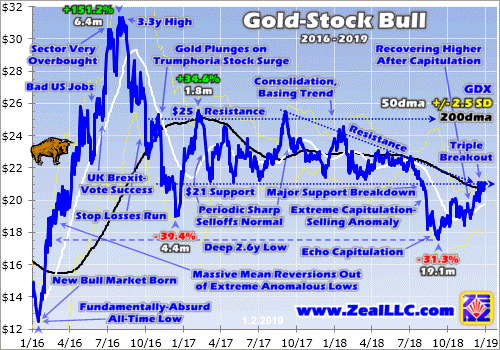
Three major upper resistance zones have converged at GDX $21. This was strong lower support for the gold miners’ stocks in a major consolidation basing trend that lasted for 21.5 months. It only failed in early August when gold was pounded by that extreme record futures short selling. Once they break, old support levels often become new resistance zones. Traders are wary to buy aggressively before they are overcome.
GDX $21 is also where the downward-sloping upper resistance line from gold stocks’ descending-triangle technical pattern has ended up. That connected the lower GDX highs that have vexed this sector since September 2017. The final and most-important resistance zone near GDX $21 is its key 200-day moving average. This essential line is usually the most-widely-watched by all the technically-oriented traders.
Market history has long shown 200dmas often prove the key dividing line between bull and bear markets. When prices surge back above their 200dmas after long periods underneath them, traders usually flood back in driving exploding upside momentum. 200dma upside breakouts often herald new bull markets or powerful uplegs within existing bulls. So GDX powering back over its 200dma is a major gold-stock buy signal.
While GDX has been meandering around $21 since Christmas Eve, that 200dma breakout has already happened! Since this leading gold-stock ETF’s 200dma is falling, the last time it was actually at $21 was in mid-November. This week the black 200dma line above has slumped to $20.72. A decisive breakout is 1% over that level. GDX achieved this milestone on December 18th, and has mostly maintained it since.
But with that 200dma still rounding to GDX $21, that is still the triple-resistance zone traders need to see left decisively behind. That critical upside breakout is happening before our very eyes! With GDX closing near $21.50, investors and speculators alike are going to consider the gold stocks off to the races. They will rush to buy and chase the upward momentum, accelerating it. This fuels major gold-stock uplegs.
The more capital traders deploy in gold stocks, the faster their share prices rise. The bigger their gains, the more traders want to buy. This virtuous circle of capital inflows has propelled past gold-stock uplegs to monstrous proportions. The last example of gold stocks powering higher out of major secular lows happened in largely the first half of 2016. The setup for that huge gold-stock upleg was very similar to today’s.
After being pummeled to a major secular low in mid-January 2016, selling was exhausted and buyers started to return. GDX began powering higher, spurred on by a parallel young gold upleg. GDX blasted up through its 200dma and capital flooded in. By the time that major buying ran its course, GDX soared an amazing 151.2% higher in just 6.4 months! Those kinds of returns are what give gold stocks their allure.
The necessary psychology to maintain that gold-stock momentum resulted from a relatively-minor 29.9% gold upleg in roughly the same span. The major gold miners of GDX leveraged and amplified gold’s gains by 5.1x! That was far better than the usual 2x to 3x because the gold stocks were so beaten down, trading at fundamentally-absurd levels when that upleg was born. Yet those huge gains still weren’t too exceptional.
Despite GDX’s mounting popularity as the leading gold-stock benchmark, this ETF is relatively new with a May 2006 birth. The previous secular gold-stock bull ran for 10.8 years, extending from November 2000 to September 2011. During that long span the classic HUI NYSE Arca Gold BUGS Index skyrocketed an astounding 1664.4% higher! The world’s most-hated sector today multiplied investors’ wealth by nearly 18x.
That was driven by a parallel 638.2% secular gold bull, which the major gold stocks of the HUI leveraged by 2.6x. The individual upleg cycles within that mammoth gold-stock bull show uplegs in this sector tend to be very large. Excluding the epic mean-reversion rebound out of late 2008’s first-in-a-century stock-market panic, the HUI enjoyed 11 normal uplegs. Their average gain was a staggering 80.7% over 7.9 months!
That last secular gold-stock bull offered traders 11 separate opportunities over 11 years to almost double their capital! So while GDX’s monster 151% upleg in H1’16 was definitely on the huge side, the last bull’s 81% average uplegs weren’t tremendously behind. When investment capital returns to gold stocks in a material way, their upside is massive. Today’s young GDX upleg could easily grow to 80%+ later this year.
Even a full-on doubling is fairly conservative considering how low gold stocks were hammered in early September’s cascading forced capitulation. GDX bottomed at $17.57 on September 11th, which was a deep 2.6-year low. A 100% gain from there would merely carry it to $35.14. That would be a new high for this gold-stock bull, as GDX last peaked at $31.32 in early August 2016. But GDX $35 is still relatively low.
Back in September 2011 as that last secular gold-stock bull crested, GDX peaked at $66.63 on close. It averaged $52.61 in the three full calendar years of 2010, 2011, and 2012. Gold-stock levels have been much higher on balance in the past. So seeing GDX double from its recent lows in this young upleg isn’t a stretch at all. And major gold-stock uplegs aren’t just a technical-buying-fueling-bullish-sentiment thing.
They are also supported by fundamentals. Gold-mining costs are essentially fixed during mine-planning stages. That’s when geologists and engineers decide which gold ore to mine, how to dig to it, and how to process that ore to extract the gold. Once hundreds of millions of dollars are spent to build the mines and mills, the mining costs generally don’t fluctuate much. Real-world data abundantly confirms this truth.
Every quarter I wade through the latest financial and operational reports of the top 34 GDX gold miners. They finished reporting their latest Q3’18 results in mid-November, which I painstakingly analyzed in an essay as usual. The top 34 GDX gold miners accounted for nearly 94% of this ETF’s total weighting. And their average all-in sustaining costs for producing each ounce of gold ran $877. That was right in line.
The previous four quarters’ top 34 GDX gold miners’ average AISCs came in at $868, $858, $884, and $856 averaging $867. So the major gold miners’ costs for producing gold don’t change much regardless of what the gold price is doing. Thus higher gold prices feed directly through to bottom lines in amplified fashion. Gold stocks’ earnings surge during gold uplegs, fundamentally justifying monster gold-stock gains.
In Q3’18 plenty of major gold miners actually reported that they expected AISCs to retreat in Q4’18 as production recovered out of various temporary setbacks. So I expect to see lower average AISCs among the top 34 GDX gold miners in their upcoming Q4 results. But let’s conservatively assume that Q3’18’s $877 average AISCs hold into Q4. Higher prevailing gold prices in Q4 portend bigger gold-mining profits.
The average gold price climbed 1.4% quarter-on-quarter in Q4 near $1228. That implies the major gold miners of GDX were earning $351 per ounce at $877 average AISCs. In Q3 the lower average $1211 gold price drove profits of $334 per ounce. So gold-mining earnings are likely to climb by at least 5.1% QoQ in Q4’18 results. That is 3.6x upside leverage to gold, so outsized gold-stock gains are righteous.
No one knows what gold will average in Q1’19, but I bet it’s going to be much higher than Q4’s $1228. Gold thrives during stock-market selloffs as investors remember diversifying their stock-heavy portfolios with alternative investments. And with burning stock markets rolling over into a young bear driven by full-speed Fed quantitative tightening, gold investment demand is likely to push gold higher for a long time to come.
But let’s assume gold does nothing on balance in Q1, and merely averages $1280 when the dust settles. That is still 4.3% higher sequentially from Q4. At $1280 gold prices and $877 AISCs, gold-mining profits in Q1 would run $403 per ounce. That is another 14.8% higher than Q4’s projected level, implying 3.4x earnings leverage to gold. As long as gold gradually climbs on balance, the gold stocks deserve to soar.
Because their profits surge much faster than gold, so do gold-stock prices. Gold stocks again tend to outperform gold by 2x to 3x during major uplegs. So if gold rallies 30%, GDX will usually power up 60% to 90%. The major gold miners’ stocks remain wildly undervalued relative to prevailing gold prices. Back in mid-October when GDX was just clawing back out of the $18s, I made that fundamental case in depth.
But while GDX is a fine sector investment vehicle with a lot to like, it’s not without its problems. In Q3’18 for example, the top 34 GDX gold miners saw their overall gold production retreat 2.9% year-over-year. The world’s 4 largest gold miners Newmont, Barrick, AngloGold, and Kinross suffered annual production drops of 2.0%, 7.6%, 14.6%, and 10.4% in Q3. Goldcorp’s plunged an anomalously-extreme 20.5% YoY!
These 5 major gold miners alone accounted for over 30% of GDX’s total weighting. Other gold miners among its top components are also struggling with production. While GDX has to own the biggest and best gold miners no matter how they are faring, their underperformance really drags down GDX’s upside. The biggest and fastest gold-stock price gains accrue in smaller mid-tier gold miners growing their production.
So instead of buying GDX, far better gains are highly probable from handpicking fundamentally-superior GDX-component stocks to own. These include mid-tier gold miners lower in GDX’s rankings that are still growing their production organically, or through new mine builds that recently came online or will soon be live. With plenty of great gold miners in this sector, investors and speculators have no need to hold laggards.
With GDX now enjoying a major upside breakout, massive new investment buying is coming. And the best gains by far will be won in smaller mid-tier and junior gold miners with superior fundamentals. While GDX itself will power dramatically higher despite the deadweight in its holdings, the better gold miners will generate much-greater wealth creation. Finding and owning these better gold-mining stocks is essential.
That’s one of my important missions at Zeal, relentlessly studying the gold-stock world to uncover the stocks with the greatest upside potential. The trading books in both our weekly and monthly newsletters are currently full of these better gold and silver miners. Most of these trades are relatively new, added in recent months as gold stocks recovered from deep lows. So it’s not too late to get deployed ahead of big gains!
To multiply your wealth in stocks you have to do some homework and stay abreast, which our popular newsletters really help. They explain what’s going on in the markets, why, and how to trade them with specific stocks. Walking the contrarian walk is very profitable. As of Q3, we’ve recommended and realized 1045 newsletter stock trades since 2001. Their average annualized realized gain including all losers is +17.7%! That’s double the long-term stock-market average. Subscribe today for just $12 per issue!
The bottom line is this young gold-stock upleg is growing. It is now surging in a major upside breakout that should unleash a flood of new buying. With gold climbing on balance too, everything is in place to fuel a major gold-stock upleg. That could easily portend a doubling in the major gold miners’ stocks from their recent deep lows. This sector’s technicals, sentiment, and fundamentals all support massive gains from here.
The higher gold stocks are driven, the more traders want to buy them to chase their outperformance. The more gold stocks rally, the more bullish sentiment becomes leading to mounting capital inflows. Higher gold prices justify all that fundamentally, as gold-mining profits leverage and amplify gold’s gains. This is the best gold-stock setup seen since early 2016, which led to GDX soaring 151% in just over a half-year.
Adam Hamilton, CPA
January 7, 2019
Copyright 2000 – 2019 Zeal LLC (www.ZealLLC.com)
- As the new year begins, gold continues to gain respect as the ultimate investment asset. Unfortunately, the same cannot be said for the U.S. dollar.
- Most investors tend to view the dollar as a “safe haven”, but the big bank FOREX traders that really move the currency market view the dollar as a risk-on asset class.
- They view gold and the Japanese yen as the main risk-off assets. So, when the dollar falls against the yen and gold as the U.S. stock market rises, all may not be quite as well as investors think it is!
- Please click here now: http://www.graceland-updates.com/images/stories/19jan/2019jan1usd1.png Double-click to enlarge. After building an immense sloping H&S top pattern, the dollar has collapsed against the yen and is now almost in “free fall”.
- That top pattern is technically a “head and shoulders (top) bear consolidation pattern”, and its implications are ominous.
- At my guswinger.com swing trade service (where I personally take all the trades myself), I’m short the dollar versus the yen (and short the dollar versus the yuan) in the FOREX market. Traders are making solid profits on these anti-dollar trades.
- We’re also long NUGT and Barrick. With John Thornton and Mark Bristow at Barrick’s helm, I now have a $200 long-term price target for Barrick. The NYSE stock symbol is set to change from ABX to GOLD tomorrow, and that’s positive news.
- Please click here now: http://www.graceland-updates.com/images/stories/19jan/2018jan1gold1.png Double-click to enlarge. As 2019 begins, investors need to think hard about whether it’s more important to predict a late cycle rally for the US stock market… or a much better idea to focus on the spectacularly bullish price action taking place on the long-term gold chart.
- India’s government is launching a new pro-gold policy within a few weeks. That will see gold become endorsed as a respected investment asset class by the government. A significant chop in the import duty will likely follow, and discussions are already underway with Russian entities about duty-free imports.
- In America, the current collapse in the dollar comes late in the business cycle. The big bank FOREX departments are almost universally negative on the dollar, and rightly so.
- Please click here now: http://www.graceland-updates.com/images/stories/19jan/2019jan1dow1.png Double-click to enlarge. The dollar melt-down against the yen is happening as the US stock market trades lower on ramped-up quantitative tightening that Fed chair Powell now says is on “auto pilot”. Investors who ignore quantitative tightening in the late stage of the US business cycle are making as big a mistake as ignoring quantitative easing at the 2009 trough of the cycle.
- Also, a Dow Theory sell signal could take place in 2019 if both the Transports and the Industrials cannot make new daily closing highs… and then break the current lows.
- I’m long the Dow now via UDOW but that’s just a technical swing trade, albeit a winner already. In the big picture, investors need to think about only one thing in 2019 and that is…
- While the job market is officially very tight, a lot of that tightness can be explained by the large number of part-time jobs. The labour department counts one worker working two part-time jobs as two people working. That’s arguably fraudulent accounting. Regardless, the huge number of part-time jobs is the main cause of the slow growth in wage inflation.
- Having said that, as the full-time jobs market tightens significantly in 2019, much more wage inflation will appear… and it will do so as corporate earnings fade towards the single digits growth range.
- In a nutshell: Welcome America, to the rebirth of… Stagflation!
- I’ve predicted that investors are making a mistake if they sit around and wait for Trump to “make things great” while the U.S. government debt rises ever-higher in the late stage of the business cycle. It’s an understandable mistake that comes from frustration with the hideous socialist and war-mongering policies of past U.S. administrations. The murderous war-mongering has been financed with gargantuan debt, making it even more vile.
- Regardless, the much wiser plan of action is to use Trump’s incredible work ethic and business acumen as personal inspiration to take professional action in the gold and silver market.
- On that note, please click here now: http://www.graceland-updates.com/images/stories/19jan/2019jan1si1.png Double-click to enlarge this awesome silver chart. I wanted to see a three-day close over $15.20, a Friday close over that same price, and I also hoped to see that “cake” iced with a 2018 year-end close above $15.20.
- All three technical events occurred! While the short-term target is the decent price area at $16, I am projecting much higher prices over the 2019-2022 time frame. It’s important that all precious metals investors understand that while gold soared above its 1980 high in 2010-2011, silver barely made it back to its 1980 high of about $50. That’s because the world has been in a general deflationary (lower rates) cycle since about 1980.
- Now, stagflation and higher rates over the long-term (like occurred in America in 1966 -1980) is beginning. When silver barely made it back to its 1980 high after 30 years, the price action was not “parabolic” like it was in the late 1970s. It was more of a modest blip related to gold dragging silver modestly higher in an overall risk-off play. What’s coming for silver now is much different than what happened in 2011. It will be parabolic (as stagflation reaches a crescendo, years from now), but it’s only barely beginning.
- Please click here now: http://www.graceland-updates.com/images/stories/19jan/2018jan1gdx1.png Double-click to enlarge. I’ve boldly referred to GDX as “Prince of Assets GDX” and called the entire $23 – $18 price zone the most important investor accumulation zone in the history of markets.
- With maverick money managers like Ray Dalio calling for a U.S. inflationary depression while amateur investors try to gamble on the late stage of the stock market cycle, I predict there’s a 90% chance that I’m proven correct.
- On this GDX chart, I’d like investors to note the bullish action, the enormous volume, and also take a close look at the $21.67 resistance area that GDX has already closed above repeatedly since arriving there. All the price action is positive, and it’s poised to become much more positive as January trading gets underway. Perhaps I should let “Queen Gold” and “King Silver” have the final word as 2019 begins, which is: Happy New Year to the entire world gold community!
Special Offer For Website Readers: Please send me an Email to freereports4@gracelandupdates.com and I’ll send you my free “Silver Stocks Rock!” report. I highlight the SIL and SILJ ETF component stocks that are poised to enter January like silver bullets shot out of a golden gun! I include key tactics to keep investors on the winning side of the action in both the short and long term!
Stewart Thomson
Graceland Updates
Stewart Thomson is a retired Merrill Lynch broker. Stewart writes the Graceland Updates daily between 4am-7am. They are sent out around 8am-9am. The newsletter is attractively priced and the format is a unique numbered point form. Giving clarity of each point and saving valuable reading time.
Risks, Disclaimers, Legal
Stewart Thomson is no longer an investment advisor. The information provided by Stewart and Graceland Updates is for general information purposes only. Before taking any action on any investment, it is imperative that you consult with multiple properly licensed, experienced and qualified investment advisors and get numerous opinions before taking any action. Your minimum risk on any investment in the world is: 100% loss of all your money. You may be taking or preparing to take leveraged positions in investments and not know it, exposing yourself to unlimited risks. This is highly concerning if you are an investor in any derivatives products. There is an approx $700 trillion OTC Derivatives Iceberg with a tiny portion written off officially. The bottom line:
Are You Prepared?
by Robert Kientz
Summary
- I discuss the recent streaming deal with Northern Vertex CEO Ken Berry.
- We also go over the $8 million private placement.
- During the interview, we cover extensively the accomplishments for 2018 as well as the options the company has to expand production and acquire new assets.
- I analyze the optionality for both companies, Maverix and Northern Vertex.
- I discuss why this deal, along with the Sprott relationship, says a lot about confidence in Northern Vertex to deliver the goods on their project.
Author’s note: I have covered Northern Vertex (NHVCF) previously in 2018 in these articles here, here, and here.
The purpose of this article is to update you on the recent streaming deal with Maverix Metals (OTCPK:MACIF) as well as the $8 million funds earned through a private stock placement. Both deals were aimed at cleaning up the debt on the balance sheet as well as providing cash for operations and some further exploration of the Moss mine area.
I interviewed Kenneth Berry who is President, CEO, and a Director with the company. CFO Christopher Park and Communications Manager Chris Curran were also in attendance.
Video Interview:
Here are some key takeaways from the interview.
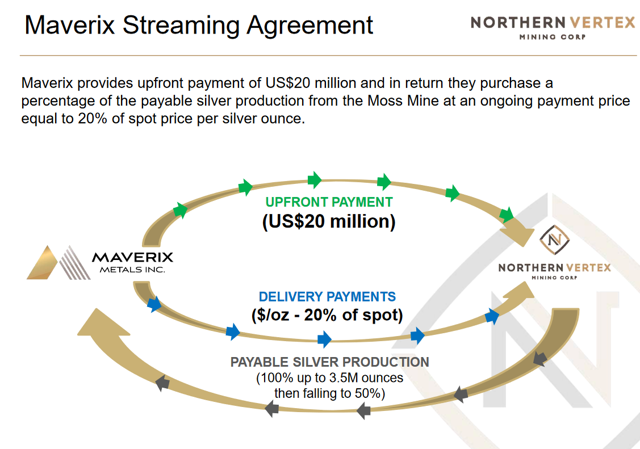
Source: Northern Vertex
- Northern Vertex has retired the debt they had with Sprott.
- Maverix gives $20 million up front for the opportunity to purchase up to 3.5 million ounces of silver at 20% of the spot price.
- After those ounces are purchased, Maverix maintains the ability to purchase up to 50% of future silver production using the same terms.
- Both companies profit from the deal and it offers optionality on a potentially rising silver price for both parties.
- The $8 million private placement provides the company money to fund operations and should solidify the balance sheet for 2019 while the company works on optimizing the gold and silver recovery from their mine.
In addition to those points, Northern Vertex has options to increase exploration of the Moss mine area in the Oatman district with award winning exploration team Perry Durning and Bud Hillemeyer.
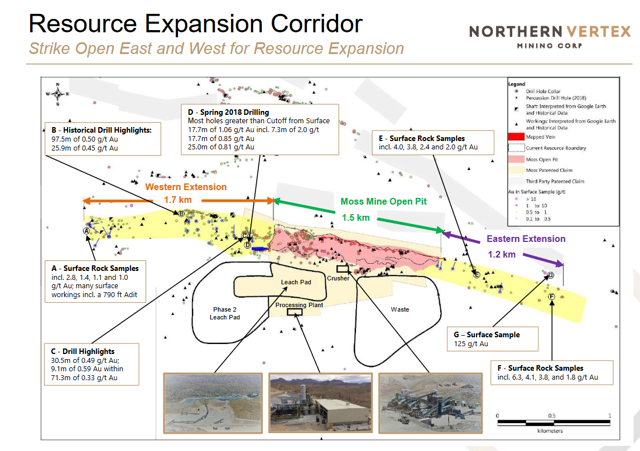
Source: Northern Vertex
In addition to the exploration upside, now that Northern Vertex has solidified their financial standing, the company is positioned to take advantage of possible expansion. Some research provided to the company shows the power of increasing both production rates and reserves in terms of market liquidity, higher market capitalization, and more analyst coverage.
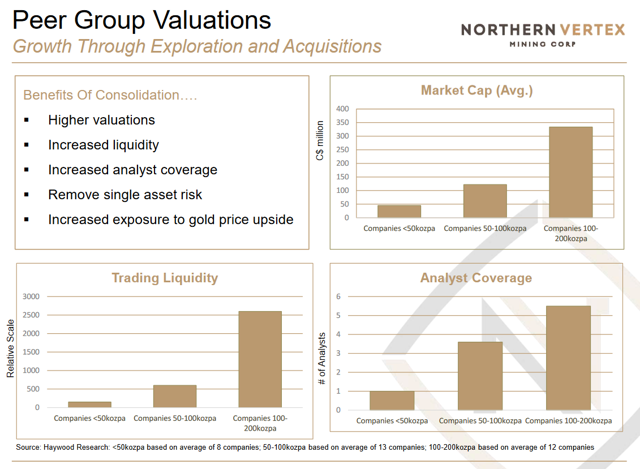
Source: Northern Vertex, Haywood Research
Optionality Analysis for Maverix and Northern Vertex
Here is my optionality analysis for both companies given different possible silver prices, including spot price as of time of writing the article.
| Northern Vertex Project Feasibility, Moss Mine | |
| Project Silver Ounces (M&I) | 4,610,000 |
| Silver Recovery Rate | 65.00% |
| Recoverable Ounces, Initial | 2,996,500 |
| Gold Ounces (M&I) | 377,000 |
| Maverix Agreement | |
| Tranche 1 Stream Ounces | 3,500,000 |
| Difference to be found through expanded exploration | 503,500 |
| Maverix spot-based payments ($14.81 silver spot as of 12-24-2018) | $8,875,633.00 |
| Initial Payment to Northern Vertex | $20,000,000.00 |
| Total Payments to Northern Vertex | $28,875,633.00 |
| Maverix Total Cost of Silver per ounce | $9.64 |
| Maverix Optionality Analysis | |
| Silver @ $17.50/ounce, total project silver value | $52,438,750.00 |
| Maverix 20% spot payment | $10,487,750.00 |
| Maverix Total Cost of Silver per ounce | $10.17 |
| Northern Vertex – per gold ounce byproduct credit from silver stream | $80.87 |
| Silver Rises to $20/ounce (2016 high) | $59,930,000.00 |
| Maverix 20% spot payment | $11,986,000.00 |
| Maverix Total Cost of Silver | $10.67 |
| Northern Vertex – per gold ounce byproduct credit from silver stream | $84.84 |
| Silver Rises to $25/ounce | $74,912,500.00 |
| Maverix 20% spot payment | $14,982,500.00 |
| Maverix Total Cost of Silver | $11.67 |
| Northern Vertex – per gold ounce byproduct credit from silver stream | $92.79 |
Source: Author Calculations
Maverix is making out pretty well on this deal, staying under the current floor for the silver price. If silver price does rise substantially, Maverix’s total cost of silver as a percent of the spot price falls precipitously.
Northern Vertex gets immediate partial monetization of their silver and higher byproduct credits, per project gold ounce, as the price of silver rises. The original project feasibility study had the AISC (all in sustaining cost) of gold at $603 given the silver byproduct credits. Since this deal was put into place, we can expect the AISC to rise somewhat due to sharing the silver profits with Maverix.
However, the project is still low cost with respect to the average gold mining costs found in the industry. And Northern Vertex just eliminated a lot of risk from their balance sheet by eliminating the Sprott debt and adding to their cash reserves. This move should provide plenty of runway to optimize their mine and get to their expected production rates without having to take on additional debt.
What the Deal Says About Confidence in the Project
The new financing shows that streaming companies such as Maverix Metals have confidence in the company to deliver on production targets.
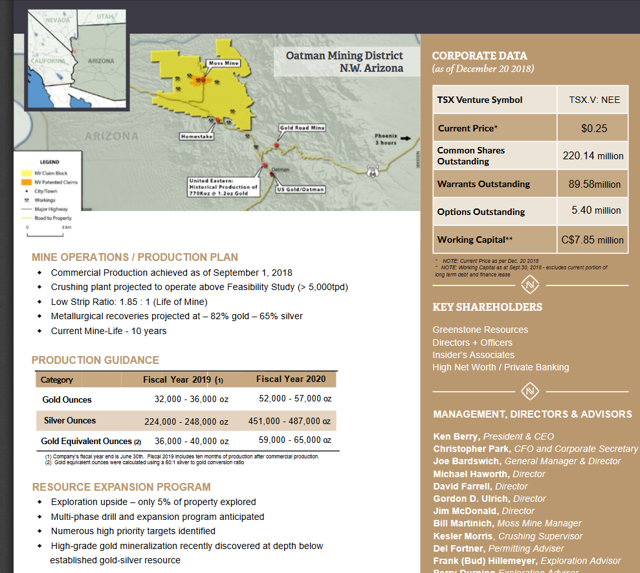
Source: Northern Vertex
Maverix Metals has an established streaming agreement with Pan American Silver at La Colorada in Mexico and Endeavour Mining in Burkina Faso, so it is no stranger to making deals with strong, established precious metals mining companies.
But Maverix’s strategy also seems to be financing smaller development projects with solid price upside. In the case of this deal with Northern Vertex, they saw an opportunity to finance a new operator and obtain undervalued silver assets that give them a very cash flow positive optionality play on the upside price for silver.
The best time to make this deal was right after Northern Vertex began production, had some debts to pay for developing the mine, and had not delivered the bulk of the metals in the project yet.
Further, the Maverix option includes total mine output well beyond the initial 2.99 million recoverable silver ounces. The agreement agrees to purchase 100% of silver ounces up to 3.5 million. Also, the deal gives Maverix the ability to purchase 50% of silver beyond the 3.5 million ounces, suggesting Maverix thinks there is more gold and silver to be found on the property, perhaps in the Western and Eastern extensions as shown in the graphic above.
Maverix is not the only company that has shown confidence in Northern Vertex to produce on the project. Sprott had provided a $100 million line of credit initially which Nortern Vertex had drawn $20 million against. I am told by management that the possibility of further financing with Sprott, should the company want to expand, is still an option as they have maintained their positive relationship. Paying off the debt early and strengthening the balance sheet certainly helps the case if they needed to use that option.
What are the Risks?
The main risk that I took away from the conversation with Ken Berry was that Northern Vertex is not ready to estimate their current AISC. To be fair, they have not had enough production time to calculate actual production costs plus additional expenditures to expand operations. It will take more time for data to be made available to come up with a tangible, reliable AISC number.
Further, he stated that the initial production costs of gold are above the feasibility number, which was $603 per gold ounce. I am not overly worried about that right now for two reasons:
- a) they are early in production, and it is not abnormal to have higher costs while operations are fine tuned and
- b) the AISC is so low that it could rise substantially and still be way below current gold spot price of $1271.70 at time of this writing.
However, there is still a risk that the costs are substantially higher than the feasibility study would indicate, which would drive the overall project value down. Northern Vertex’s current market cap is currently valued well below their project NPV.
The research provided in the graphic above from Haywood Research shows that overall sector market caps are priced within ranges and not tied directly to project NPVs, but more on sentiment indicators like analyst coverage and overall project size. Investors have not appeared to spent enough time in precious metals sector to appropriately value projects and make their bets.
As the general stock market volatility continues into 2019, I believe investors will spend time analyzing their options and find that the precious metals markets are sorely undervalued.
I believe this to be an arbitrage opportunity right now for smart value investors looking at cheaply priced assets, and perhaps licking their wounds from falling stock values in the wildly popular technology sector which has been punished since October.
I think the market scenario has played into Northern Vertex’s hands as it has allowed them to develop the mine largely unnoticed, while still showing the ability to finance their operations with two established industry partners who know how precious metals mining works.
When the broad market takes notice of the sector, Northern Vertex will likely be one of the companies that catches some of that new investor money coming in due to their relatively low level risk factors.
Stay Tuned
We are much closer to the Renaissance in precious metals markets than we have been since the last major market crash. The macro story is playing into the hands of precious metals, and will reward the miners and investors with key positions.
Therefore, for 2019 I will be adding coverage for more companies in the precious metals sector that I also believe are undervalued. And lastly, I will continue to provide coverage for Northern Vertex throughout 2019 as production continues to ramp up and major news events happen.
Robert Kientz, January 3, 2019
Stock markets are forever cyclical, an endless series of alternating bulls and bears. And after one of the greatest bulls in U.S. history, odds are a young bear is now gathering steam. It is being fueled by record Fed tightening, bubble valuations, trade wars, and mounting political turmoil. Bears are dangerous events driving catastrophic losses for buy-and-hold investors. Different strategies are necessary to thrive in them.
This major inflection shift from exceptional secular bull to likely young bear is new. By late September, the flagship US S&P 500 broad-market stock index (SPX) had soared 333.2% higher over 9.54 years in a mighty bull. That ranked as the 2nd-largest and 1st-longest in U.S. stock-market history! At those recent all-time record highs, investors were ecstatic. They euphorically assumed that bull run would persist for years.
We humans naturally extrapolate present conditions lasting way out into the indefinite future. But long centuries of stock-market history have painfully proven that no bull lasts forever. Eventually they all lead to inherently-unsustainable fundamental, technical, and sentimental excesses. These can only be bled away and ultimately normalized by bear markets. So bull markets have always been followed by bears.
Bulls and bears are easily defined technically, 20%+ SPX moves uninterrupted by opposing 20%+ moves. The greatest stock bull in US history was the SPX’s 417.0% run over 9.46 years between October 1990 to March 2000. That climaxed in the tech-stock bubble, when wild optimism about stock-market fortunes reigned. Yet that soon gave way to tears as the subsequent bear mauled the SPX 49.1% lower in 2.6 years!
Stock investors suffering their wealth getting cut in half is typical in major bears. But the losses extend well beyond capital into far-more-scarce time. After that turn-of-the-century secular-bull peak, the SPX wouldn’t power decisively above those levels again until 12.9 years later in early 2013! That’s nearly a third of the 40 years average investors have between the ages of 25 to 65 to generate wealth to finance retirement.
If you can’t afford to lose half your stock-market wealth, and you don’t have time to wait for well over a decade for stock prices to fully recover, you better take this quarter’s market developments very seriously. Something snapped in the U.S. stock markets in early Q4’18, and the price action and volatility since reeks of a young new bear. While that diagnosis can’t be certain until the SPX falls 20%+, the signs are ominous.
As Q4’18 dawned, the U.S. Federal Reserve ramped its quantitative-tightening campaign to full speed. QT is necessary to start unwinding 6.7 years of quantitative easing ending in October 2014, during which the Fed conjured $3625b out of thin air to monetize bonds! QE was considered necessary to stimulate the economy after the Fed forced interest rates to zero in December 2008 during the first stock panic in a century.
Those trillions of dollars of QE capital injected by the Fed directly levitated the stock markets, artificially inflating an already-mature bull market to monstrous proportions. All those bonds accumulated on the Fed’s balance sheet, which skyrocketed 427% higher over that relatively-short QE span! The Fed can’t maintain $3.6t of bonds on its books forever, so it finally started letting them gradually roll off at maturity in Q4’17.
That unprecedented QT capital destruction started small, but was ratcheted up each quarter until Q4’18 when it reached its terminal velocity of $50b per month. The SPX achieved its latest all-time record high in late September, and then October was the first month ever of full-speed QT. The QE-levitated stock markets wilted under this QT onslaught, which was inevitable sooner or later. I warned about all this in advance.
Just a week after the SPX peaked in late September, I published one of my most-important essays ever. I unambiguously titled it “Fed QT is Bull’s Death Knell”, and it explained the stock-market impact of Fed QE in depth and why full-speed QT was certain to slay this bull. With the SPX just 0.6% under its recent record high on that final day of Q3’18, that warning fell on deaf ears. Maybe investors will pay attention now.
Fed QT is no flash in the pan, it is a long-term persistent threat to these lofty stock markets. In order to merely unwind half of that unfathomable $3.6t of Fed QE, full-speed QT at $50b per month will have to run for 30 months starting in Q4’18. Heading into 2019 the stock markets face another 27 months of this! And the Fed is loath to slow or stop its QT now underway on autopilot, as that could unleash panic-grade selling.
The Fed has long asserted the reason it is undertaking QT and has hiked rates 9 times since December 2015 is the US economy is strong. It wants to rebuild easing-ammunition stores to use in the inevitable coming recession. If the Fed caves on QT before its balance sheet shrinks much lower, traders will assume the Fed fears the US economy is in serious trouble. So they would flee stocks pummeling them far lower.
The die is cast on Fed QT, guaranteeing the long-overdue next stock bear. And the losses seen so far are just a small vanguard of what’s to come. This first chart superimposes the mighty SPX bull of the past decade on its so-called fear gauge, the VIX S&P 500 implied-volatility index. The recent Q4 trading action in both is unlike anything yet seen in this entire bull. It is looking far-more bear-market-like in character.
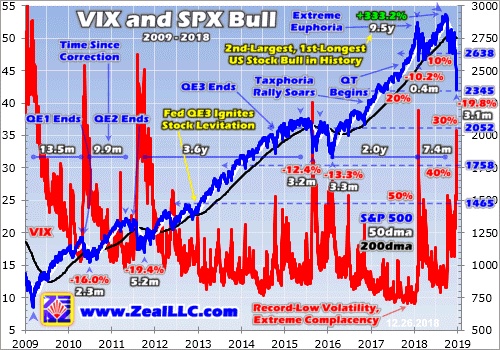
Major stock-market selloffs are defined based on size. Anything under 4% isn’t worth classifying, it is just normal market noise. Then from 4% to 10%, selloffs become pullbacks. In the 10%-to-20% range they grow into corrections. And of course beyond that at 20%+ they are in formal bear-market territory. This selloff snowballed darned close to beardom on Christmas Eve, the SPX plunging to a 19.8% loss over 3.1 months!
Just 4 trading days earlier before the latest FOMC decision, it was only down 13.1%. While that latest Fed rate hike was expected, the future-rate-hike outlook among top Fed officials wasn’t dovish enough for stock traders. Despite all the market carnage since the previous dot plot, their effective forecast for future rate hikes was merely lowered from 4 more to 3. So the SPX plunged 7.7% over the next 4 trading days!
Even before that this selloff hasn’t behaved like a normal bull-market correction. Their purpose is to vent excessively-bullish sentiment, rapidly bleeding off greed. Sharp selloffs are necessary to do that. Traders don’t get worried until stocks fall fast enough and far enough to shatter their complacency. So normal bull-market corrections are usually front-loaded with sharp selloffs that trigger soaring levels of fear.
Prevailing fear levels are inferred by the VIX, which technically measures the implied volatility in 1-month SPX options. Before last peaking in late September, the SPX suffered 5 bull-market corrections within its epic secular bull. Heading into July 2010 the SPX fell 16.0% in 2.3 months. That spawned some real fear, as evident in the VIX soaring to a 45.8 peak. The effective fear ceiling outside of panics and crashes is a 50 VIX.
The next SPX correction cascaded 19.4% lower over 5.2 months ending in October 2011. Despite its long span, the VIX skyrocketed as high as 47.5 in its midst. That was real fear, the kind necessary to slay exuberant greed and rebalance sentiment to keep an ongoing stock bull healthy. After that the SPX went a near-record 3.6 years without a single correction-grade selloff in an extraordinary levitation driven by the Fed.
That’s when its unique open-ended third quantitative-easing campaign was in full swing. QE3’s peak year was 2013 which saw the Fed monetize a staggering $1020b of bonds! The SPX soared 29.6% higher that year on such vast liquidity injections. But 2014 saw QE bond buying collapse to $450b as the Fed tapered QE3. The SPX only rallied 11.4% that year, its gains shrinking 62% in proportion with QE3’s 56% decline.
The QE3-goosed stock markets wouldn’t correct again until well after QE3 ended, the SPX sliding 12.4% over 3.2 months into August 2015. Again the VIX surged to 40.1, which is up in the very-high fear zone. The next debatable correction followed right after. The SPX didn’t achieve new highs after the previous one, so it was technically one compound correction instead of two separate ones. Analysts render it both ways.
That second correction or second part of the longer one saw the SPX fall 13.3% over 3.3 months into February 2016. That was the only bull-market exception that didn’t see a high VIX, it merely climbed to 28.1 at best. But since the VIX had just recently surged over 40 in a fear climax, another one apparently wasn’t necessary. That rolling-over SPX action into early 2016 actually looked more bear-like than bull-like.
Provocatively it took fully 13.7 months after that May 2015 topping for the SPX to finally hit new highs confirming its bull was alive. The thing that short-circuited what felt like a young bear was hopes for more European Central Bank easing after the UK’s surprise Brexit vote in late June 2016. Then the SPX again exploded higher in November 2016 after Trump’s surprise presidential victory with Republicans controlling Congress.
Optimism and greed exploded on hopes for big tax cuts soon, fueling a powerful stock-market surge into early 2018. The SPX then corrected sharply into early February with a 10.2% plunge in just 0.4 months. The VIX shot up to 38.8 on that, showing real fear. All bull-market corrections with the lone exception of the second part of that compound one exhibited telltale fear spikes averaging VIX peaks way up at 43.1.
But the recent SPX selloff of Q4’18 coinciding with the first-ever full-speed Fed QT looks way different. It has been mostly an orderly, gradual selloff generating modest fear. The highest VIX close between late September and pre-FOMC in mid-December was merely 25.8! Even on Christmas Eve it only hit 35.8. These are too low for normal sharp bull-market corrections, this fear profile is looking more like a bear downleg.
While bull-market corrections are supposed to shock and scare, bear-market downlegs start more subtlety. Instead of plunging fast then stabilizing, bear selloffs start slow then gather steam later. Bears begin in stealth mode, only gradually rolling over to prevent fear from spiking. Without big fear to wake them up and scare them out, investors complacently stay deployed as their losses slowly and inexorably mount.
Like the proverbial frog slowly being boiled alive, investors don’t realize the peril their capital is in during bear markets until way too late. The lack of normal bull-market-correction fear spike during this latest correction-grade selloff disturbingly suggests a new bear has awoken. And coming after such a massive and largely-artificial QE-inflated stock bull, the fearsome bear QT has to spawn should be proportionally large.
On Christmas Eve the SPX was forced close to a 20% bear-cub loss at 2345. That level was first seen in February 2017, and represents nearly 3/4ths of the post-Trump-election taxphoria rally being wiped out. 30% would drag the SPX back down to 2052, which were November 2014 levels right after the QE3 bond monetizations ended. 40% would crush the SPX to 1758, back to October 2013 levels killing 4.9 years of gains.
But after one of the biggest and longest stock bulls in U.S. history, it would be shocking if the subsequent bear didn’t lop off at least 50%. Especially given this bull’s artificial QE-inflated nature in an era where QE-conjured capital is being destroyed by QT. A 50% SPX loss from late-September’s peak would leave it at 1465. Those levels were first seen in this bull all the way back in September 2012, 6.0 years earlier.
While a 50%+ bear warning may sound sensational or overly dramatic, it’s actually fairly conservative. The SPX already suffered two bear markets since the tech-stock bubble peaked in March 2000. The first one ending in October 2002 mauled the SPX 49.1% lower over 2.6 years. The second one climaxing in the first stock panic in a century drove a far-worse 56.8% SPX decline in just 1.4 years ending in March 2009.
50% bears are totally normal after large bulls, even when they don’t have the amplifying dynamics of the first-ever colossal-scale Fed QE and QT. This overdue next bear has a great chance of growing bigger than normal after such a monstrously-grotesque bull. Most investors won’t figure this out until too late. Unlike bull-market corrections, high-fear VIX spikes soaring into the 40-to-50 range don’t ignite until later in bears.
While the extreme Fed tightening under this unprecedented full-speed QT campaign could easily drive a major stock bear alone, so could excessive valuations. When the SPX peaked in late September, its 500 elite stocks were collectively trading at literal bubble valuations! Extreme valuations are what usually cause stock bears, which exist to force stock prices back into line with corporations’ underlying earnings.
The classic honest way to measure valuations is through trailing-twelve-month price-to-earnings ratios. These take companies’ last four quarters of actual hard GAAP earnings, add them up, and divide them by companies’ prevailing stock prices. Unlike fictional forward earnings, real past results aren’t mere guesses about the future. Over the past century and a quarter or so, the U.S. stock markets averaged a 14x TTM P/E.
That’s long-term historical fair value, which is logical and reasonable. The reciprocal yield of 14x is 7.1%, an interest rate that is mutually beneficial to both pay and be paid for investment capital. Twice that at 28x earnings is the formal bubble threshold. As of the end of September just after the SPX peaked, its elite companies averaged a TTM P/E well into bubble territory at 31.4x earnings. They were dangerously overvalued.
This next chart looks at average SPX valuations in TTM P/E terms over the past couple decades or so. The 500 SPX components’ simple-average P/E is rendered in light blue. The dark-blue line shows it instead weighted by companies’ market capitalizations. The SPX is superimposed over the top in red, while a hypothetical fair-value SPX at 14x earnings is shown in white. This valuation picture is ominously damning.
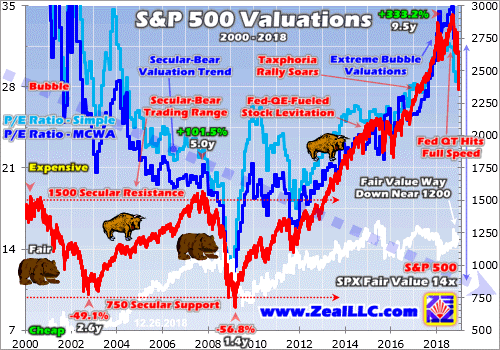
The bubble valuations around the SPX’s late-September peak were nothing new. They had been above that 28x threshold continuously for 14 months since July 2017. Stocks were already expensive before Republicans swept the November 2016 elections kindling those exuberant big-tax-cuts-soon hopes. But they got a lot more expensive after that as stock prices soared way faster than corporate earnings since.
Again excessive valuations are what normally spawn stock bears. Stock prices get bid up too fast during bull markets for underlying earnings to justify. So bears follow bulls to drag stocks lower or just sideways for long enough for corporate profits to catch up with prevailing stock prices. These mean reversions after large bulls usually see valuations overshoot towards the opposite extreme before bears give up their ghosts.
So odds are this young stock bear won’t head back into hibernation until the stock markets’ average TTM P/E ratio per the elite SPX components actually falls under 14x. Major bears usually bottom with the SPX P/E in the 7x-to-10x earnings range, the former being half fair value when stocks are very cheap and screaming buys. Late in the last stock bear climaxing in March 2009, the SPX’s TTM P/E slumped to 12.6x.
But let’s be conservative and just assume this next bear, even with Fed QT, merely mauls stocks long enough to force a fair-value 14x P/E with no overshoot. Assuming corporate earnings don’t grow much which is a real possibility during a serious stock bear, that implies 51% downside from the SPX’s late-November levels. That was the latest month-end valuation data available when this essay was published.
Historical fair value sans earnings growth implies a bear-market bottom near SPX 1356, or 53.7% under late September’s peak! That’s right in line with historical major bear markets, nothing unusual. As bears generally last a couple years or so, modest underlying corporate-profits growth could lift that valuation-based bottoming target maybe 10% or so. That still implies a 49.1% total bear which isn’t to be trifled with.
The combination of wildly-unprecedented full-speed Fed QT slamming QE-inflated stock markets trading at bubble valuations is incredibly menacing. Seeing bear-market-like rolling-over selling behavior without big fear spikes in recent months strongly argues the overdue bear has awoken. But since all that selling has been concentrated fully within a single quarter, odds are most investors don’t realize how bad things are.
The biggest group of investors with the most capital are casual retirement investors who don’t closely follow the markets. They avoid much work and stress by paying other people to manage their money. These investors get statements showing their portfolios’ fortunes after every calendar quarter. At the end of Q3’18, everything still looked awesome with the SPX just 0.6% under its all-time high of a week earlier.
So the Q4’18 statements due out in January could prove shocking, spawning fear and galvanizing bearish psychology. The most-widely-held stocks in investment funds are the biggest and best ones led by the market-darling mega techs. While they were radically overvalued at the end of Q3, no one cared at that point. Everyone owned the largest US stocks including Apple, Amazon, Microsoft, Alphabet, and Facebook.
Add in the last FANG Netflix, and these 6 stocks alone commanded over 1/6th of the entire market cap of the SPX just before the Q4 selling started! Their average TTM P/E was a scary 80.2x earnings, 2.6x the entire SPX’s. Yet these beloved companies were believed to have such amazing businesses that they should be immune to economic slowdowns or stock-market selloffs. That myth was obliterated in Q4.
This SPX selloff first hit 10%+ correction territory on Black Friday with a 10.2% loss from its peak. On that same day, mighty Apple, Amazon, Microsoft, Alphabet, Facebook, and Netflix had collapsed 25.8%, 26.4%, 10.8%, 19.9%, 39.4%, and 38.2% from their recent all-time highs! They averaged 26.8% losses, or 2.6x the SPX’s. Many if not most investors’ Q4’18 portfolio results are going to look even worse than the SPX.
Will they start fleeing and adding to the selling pressure when these gaping holes in their precious capital are revealed? And while record Fed tightening and a mean reversion lower out of bubble valuations are the primary bear-market risks, they aren’t the only ones. The trade wars between the US and China and other countries are intensifying, and U.S. political turmoil will soar next year with Democrats controlling the House.
The epic corporate stock buybacks that helped levitate the stock markets in recent years will wane as the Fed forces interest rates higher. Trillions of dollars of these buybacks were debt-financed over the past decade. And as stock markets fall, Americans will feel poorer and spend less. This negative wealth effect will really weigh on record corporate profits, potentially driving them lower forcing valuations even higher.
The Fed’s QT isn’t the only howling central-bank headwind stock markets face. The European Central Bank is also halting its own massive QE bond monetizations starting in January! That will suck even more capital out of the system. Many of these bearish factors for stocks feed on each other too, with all combined wreaking more havoc on sentiment and stock prices than individual ones ever could in isolation.
Investors really need to lighten up on their stock-heavy portfolios, or put stop losses in place, to protect themselves from this young bear market. It’s only just beginning, with sub-20% SPX losses at worst a far cry from 50%+. Cash is king in bear markets, since its buying power grows. Investors who hold cash during a 50% bear market can double their stock holdings at the bottom by buying back their stocks at half-price.
Put options on the leading SPY S&P 500 ETF which perfectly mirrors the SPX can also be used to hedge downside risks. But options trading is risky, with 100% losses possible if the timing doesn’t work out. And cash doesn’t appreciate in value. So the best bear-market investment is gold, which tends to rally on surging investment demand as stock markets weaken. Gold investment grows wealth during stock bears.
Gold surged 30% higher in essentially the first half of 2016 in a new bull initially sparked by those late-2015 and early-2016 SPX corrections. Investors fled burning stocks and flocked to gold. And the gold miners’ stocks really leveraged those gains, rocketing 151% higher in that same timeframe. The gold stocks are not only wildly undervalued, but just breaking out technically which should accelerate their upside.
Absolutely essential in bear markets is cultivating excellent contrarian intelligence sources. That’s our specialty at Zeal. After decades studying the markets and trading, we really walk the contrarian walk. We buy low when few others will, so we can later sell high when few others can. While Wall Street will deny the growing stock-market bear all the way down, we will help you both understand it and prosper during it.
We’ve long published weekly and monthly newsletters for speculators and investors. They draw on my vast experience, knowledge, wisdom, and ongoing research to explain what’s going on in the markets, why, and how to trade them with specific stocks. As of Q3, we’ve recommended and realized 1045 newsletter stock trades since 2001. Their average annualized realized gain is +17.7%! That’s double the long-term stock-market average. For just $12 per issue, you can learn to think, trade, and thrive like contrarians. Subscribe today!
The bottom line is a young stock bear sure looks to be awakening. Q4’s rolling-over stock-market selling without big fear spikes is ominously classic bear-market behavior. And after such a monster bull, the next bear is long overdue. Unprecedented full-speed Fed QT colliding with bubble-valued U.S. stock markets artificially inflated by long years and trillions of dollars of Fed QE can’t end well. The reckoning is upon us.
Major bear markets follow major bull markets, often cutting stock prices in half over a couple years or so. And these inexorable bull-bear cycles are very unforgiving, as it can take over a decade for stock markets to regain bull highs once a bear starts ravaging. Gold is the refuge of choice, seeing investment demand surge as stock markets swoon. Prudent investors deploying in gold can grow their wealth during stock bears.
Adam Hamilton, CPA
December 31, 2018
Copyright 2000 – 2018 Zeal LLC (www.ZealLLC.com)
Weary investors who endured the September and October stock market “crash season” felt they should be richly rewarded for their incredible patience… with a wondrous Santa Claus rally
Please click here now. The traditional Santa Claus rally has morphed into a hideous Santa Claws mauling of millions of US stock market price chasers. It’s a gruesome sight. The good news, clearly, is that my prediction has come true and both gold and senior miners have leaped into the limelight.
They are happily basking in their new role as safe haven beacons of safety for smart money investors. Please click here now. Double-click to enlarge this “Queen of Assets” gold chart.
While the stock market incinerates, gold is in a mighty uptrend. Note the fabulous flat line event taking place now on my 14,7,7 Stochastics oscillator at the bottom of the chart. This type of technical action is extremely positive. The world’s mightiest metal is poised to surge above the uptrend channel supply line and roar straight to my $1300 target price zone!
Please click here now. Double-click to enlarge. Silver has held its own against the dollar and higher price enthusiasts will likely get the rally they deserve in 2019. Because silver is used extensively in industrial applications, it tends to lag gold as the business cycle peaks. Demoralized stock market investors don’t see signs of aggressive growth in inflation yet, so they leave silver alone.
Once inflation begins to pick up more aggressively and US GDP growth contracts more substantially, silver will start to rally as aggressively as gold and the senior miners are rallying now.
I see that happening by the second half of 2019, but a three-day close over $15.20 would be a strong indication that commercial traders anticipate stagflation and are getting invested in this superb metal ahead of time.
As 2018 got underway, I urged investors to focus on President Trump’s success in the private sector and use his fabulous work ethic, organization, and planning skills as an inspiration to act professionally in the major markets.
Unfortunately, many investors believed that Trump’s power as president gave them a free pass to act unprofessionally in the major markets.
They believed the incredible success that America achieved in the 1880s “Golden Age” and the 1950s could be re-created by Trump… even though America’s demographics are now essentially the opposite of what they were in those two glorious time frames.
These investors essentially devolved into maniacal US stock market price chasers, and they ignored the clear “safehavenization” of senior gold stocks that was taking place.
The bottom line: Investors will always pay a price for sloppy actions in the market and they will always reap incredible rewards for high-level professionalism.
Please click here now. Double-click to enlarge. I developed the STL (Stewart’s Traffic Lights) system to provide clear green and amber light signals for an array of assets over both the short and long term.
Horrifically, the Dow Jones Industrial Average is now flashing a weekly chart amber STL. Amateur investors like to “wait for a rally” to sell. I like to obey traffic lights.
If the light turns amber, I don’t race my stock market car through the intersection, especially when a quantitative tightening freight train on central bank “auto pilot” is barrelling through that intersection. I don’t predict when the STL will turn green. I wait for it to turn green, and then I buy.
At my guswinger.com swing trade service, I have the “party people” short USD versus the yen, long GDX via triple-leveraged NUGT, and short the stock market via SDOW. It’s certainly a very Merry Christmas today for all the GU Swinger partygoers!
This year, America awakes on Christmas day with the socialist “demorats” back in control of the House, the stock market on a major sell signal… and with gold and the senior miners acting like the brightest Christmas lights in town!
Please click here now. Double-click this superb GDX “chart of champions”. As the Dow tumbled 600 points, GDX surged above the $21 resistance zone on a closing basis!
Note the enormous rise in volume. There’s also a flat line event taking place with the Stochastics oscillator. From a technical perspective, this chart is a bullish masterpiece that looks like Michelangelo created it.
Santa Claws came to U.S. stock market town, but Santa Claus came down every gold bug’s chimney with wondrous higher priced gold and senior miner tidings! Enjoy! Enjoy, because the current market themes in play are poised to dramatically accelerate in 2019. Best wishes to the entire global community!
Stewart Thomson
Graceland Updates
Email:
stewart@gracelandupdates.com
stewart@gracelandjuniors.com
stewart@guswinger.com
Stewart Thomson is a retired Merrill Lynch broker. Stewart writes the Graceland Updates daily between 4am-7am. They are sent out around 8am-9am. The newsletter is attractively priced and the format is a unique numbered point form. Giving clarity of each point and saving valuable reading time.
Risks, Disclaimers, Legal
Stewart Thomson is no longer an investment advisor. The information provided by Stewart and Graceland Updates is for general information purposes only. Before taking any action on any investment, it is imperative that you consult with multiple properly licensed, experienced and qualified investment advisors and get numerous opinions before taking any action. Your minimum risk on any investment in the world is: 100% loss of all your money. You may be taking or preparing to take leveraged positions in investments and not know it, exposing yourself to unlimited risks. This is highly concerning if you are an investor in any derivatives products. There is an approx $700 trillion OTC Derivatives Iceberg with a tiny portion written off officially. The bottom line:
Are You Prepared?
As we’ve been saying, the stock market will have great influence on Gold. It has been easy to see in recent months.
The S&P 500 has cracked, losing both its 200-day and 400-day moving averages. Gold and gold stocks have benefitted and gained in recent months even with a stable to rising U.S. Dollar.
The past 65 years of history shows us that in almost any context (but not all) the time between the Fed’s last rate hike and first rate cut is exactly when you want to buy gold stocks.
We don’t know if December is the last rate hike. No one does.
What we do know is the stock market is approaching an extreme oversold condition and is likely to begin a counter trend rally very soon.
In the chart below we plot five indicators that can help define an extreme oversold condition. These include the Vix, the put-call ratio and several breadth indicators. All but the Vix are in extreme oversold territory.
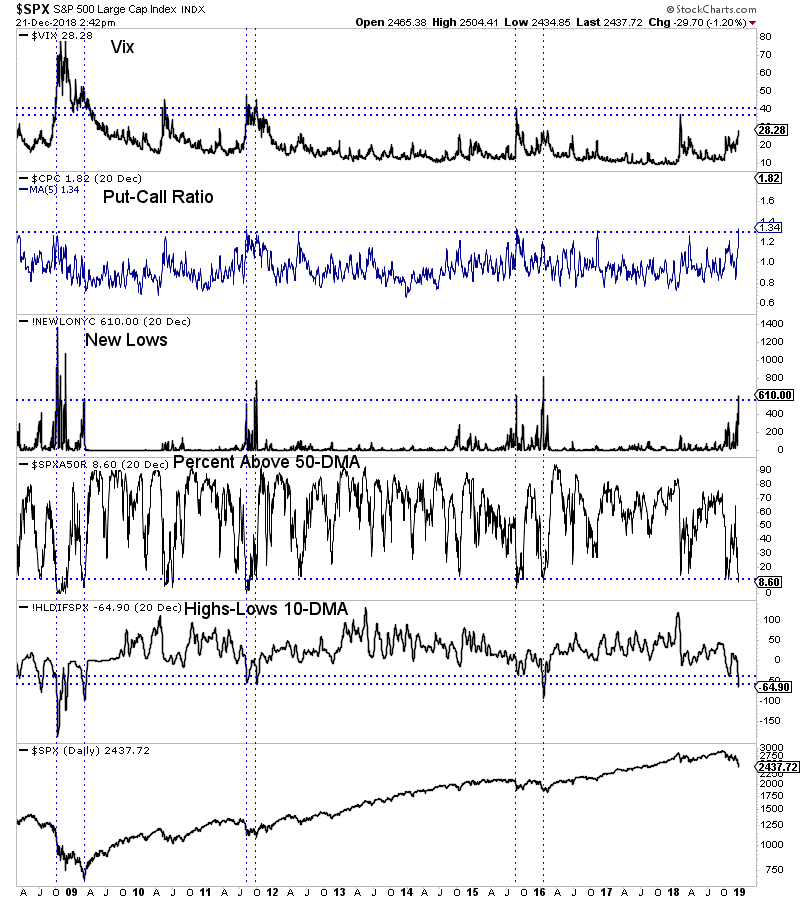
As we pen this article, the S&P 500 is trading at 2436.
The 40-month moving average, which has provided key support and resistance over the past 20 years (including the 2016 and 2011 lows) is at 2395 while the 50% retracement of the 2016 to 2018 advance is at 2380.
The setup for a bullish reversal is in place.
Meanwhile, despite the recent carnage in stocks, precious metals have been unable to surpass resistance.
Gold is set to close the week right below a confluence of resistance at $1260-$1270. Perhaps it will close right on its 200-day moving average at $1258.
The gold stocks (GDX, GDXJ) have been strong since Thanksgiving but appear to have been turned back at their 200-day moving averages.
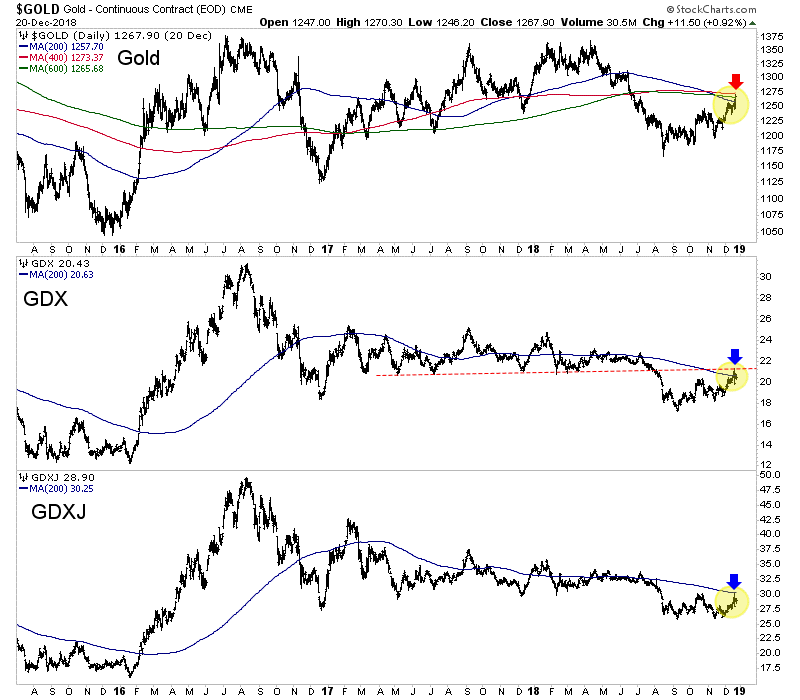
So in recent days the selloff in the S&P 500 accelerated but precious metals (at least to this point) failed to capitalize in a bullish fashion.
If the S&P 500 is within one or two days of a rally then we should not expect much more upside in Gold and GDX in particular. Those were the markets that benefited most from weakness in the S&P 500.
As we noted last week, the weakness in the stock market (and the economy) has not done enough to change Fed policy yet.
Over the past 65 years, the start of bull markets and big rallies in gold stocks coincided with the start of rate cuts. When the market sniffs the first rate cut, we will know precious metals are beginning a sustained advance and not another false start.
Until Gold proves its in a bull market (and the market begins pricing in a rate cut) it would not be wise to chase strength. There will be plenty of time to get into cheap juniors that can triple and quadruple once things really get going. To prepare yourself for an epic buying opportunity in junior gold and silver stocks in 2019, consider learning more about our premium service.
The dovish Federal Reserve lit a fire under gold and its miners’ stocks this week. As universally expected the FOMC hiked rates for the 9th time in this cycle. But it also lowered its 2019 rate-hike outlook bowing to the stock-market selloff. Traders dumped gold initially thinking that wasn’t dovish enough. But market reactions to the FOMC formed over a couple days, and gold surged overnight. Its post-Fed rally has great potential.
Gold-futures speculators dominate gold’s short-term trading action. They punch way above their weight in capital terms thanks to the extreme leverage inherent in gold futures. This week, the minimum margin for trading each 100-ounce contract controlling $125,000 worth of gold at $1250 was just $3400! These traders can run crazy maximum leverage as high as 36.8x, compared to the stock markets’ legal limit of 2x.
At 10x, 20x, or 30x leverage, every dollar of capital deployed in gold futures has 10x, 20x, or 30x more price impact on gold than a dollar invested outright. Further compounding speculators’ hegemony over gold prices, gold’s world reference price derives directly from US gold-futures trading. Naturally extreme leverage means extreme risk. At 37x a mere 2.7% gold move against positions wipes out 100% of capital risked!
In order to survive, gold-futures traders are forced to have an ultra-short-term focus. Their time horizons are measured in hours, days, and maybe weeks instead of months and years. And there is nothing that motivates them to trade aggressively like meetings of the Fed’s Federal Open Market Committee. Gold volatility often surges in their wakes, as speculators watch the U.S. dollar’s reaction and do the opposite in gold.
Gold-futures speculators are convinced Fed rate hikes are bearish for gold because they are bullish for the US dollar. They logically reason that the higher prevailing US interest rates, the more attractive the US dollar becomes relative to other currencies. And a stronger dollar usually means weaker gold since they are competing currencies. That all sounds rational, but the big problem is history doesn’t bear this out.
The FOMC started today’s rate-hike cycle way back in mid-December 2015, raising the federal-funds rate for the first time in 9.5 years. Gold-futures speculators fled leading into that, ultimately crushing gold to a deep 6.1-year secular low of $1051 the day after. But that oversold extreme marked the birth of a new bull market that would catapult gold 29.9% higher over the next 6.7 months! That same bull persists today.
In the 3.0 years since which includes this week’s 9th Fed rate hike of this cycle, gold is still up 18.1% and the US Dollar Index is down 2.1%. That’s no anomaly either. This is actually the Fed’s 12th rate-hike cycle since the early 1970s. During the exact spans of the prior 11, gold averaged strong gains of 26.9%! That was an order of magnitude higher than the stock markets’ 2.8% average gains per the flagship S&P 500.
Gold-futures speculators either don’t know market history or their extreme leverage forces them to run as a herd no matter how irrational that stampede is. They can’t afford to be wrong for long or risk suffering catastrophic losses. This week they apparently expected the FOMC to prove even more dovish on future rate hikes than it was. That led to volatile gold action surrounding this latest critical Fed decision on rates.
The FOMC meets 8 times per year, about every 6 weeks. But up until now, only every other meeting was accompanied by a Summary of Economic Projections and followed by the Fed chairman holding a press conference. That meant the Fed was only “live”, likely to hike rates, once a quarter at that every-other meeting. Incidentally Jerome Powell will start holding press conferences after every meeting starting in January.
That decision was made in mid-June, it had nothing to do with the recent stock-market volatility. Since the Fed doesn’t want to spook traders and ignite selloffs, rate hikes are well-telegraphed in advance. 3 weeks after each FOMC meeting, its full minutes are released. They are long and detailed, offering all kinds of clues about whether top Fed officials are thinking about hiking rates at the next FOMC meeting.
Market-implied Fed-rate-hike odds are always available through federal-funds futures trading. The big wildcard at each live FOMC meeting is a part of the SEP known as the “dot plot”. It collates where each individual top Fed official personally expects the federal funds rate to be in each of the next several years and beyond. It’s literally a bunch of dots plotted on a table, hence the name. It can really move gold futures.
Though Powell and other FOMC members stress the dot plot is not an official rate-hike forecast or outlook by the Fed, traders universally use it as such. A hawkish dot plot implies more future rate hikes than the previous one, and dovish less. Gold, currency, and stock-index futures speculators trade aggressively based on the quarterly changes in the dot plot. FOMC statements and press conferences also play roles.
At the FOMC’s previous meeting accompanied by a dot plot in late September, those forecasts implied top Fed officials expected this week’s rate hike, another 3 in 2019, and 1 final one in 2020. But market conditions were way different then. That decision came just 4 trading days after all-time record highs in the lofty euphoria-drenched U.S. stock markets. Top Fed officials are boldly hawkish when stocks look awesome.
In early October Powell doubled down on this hawkishness, saying in an evening speech that the federal-funds rate was “a long way from neutral at this point, probably” and that “We may go past neutral.” The very next day the stock markets started sliding and haven’t looked back since. By this Monday that selloff had gradually mushroomed into a moderate 13.1% correction in the S&P 500. Many blame it on Fed hawkishness.
Facing withering criticism led by president Trump himself, Powell tried to walk back his own many-more-rate-hikes-to-come outlook in late November after the S&P 500 had passed the 10% correction threshold. Powell said “Interest rates are still low by historical standards, and they remain just below the broad range of estimates of the level that would be neutral for the economy…” Stock selling was softening the Fed.
While traders fully expected the rate hike of this cycle Wednesday, they were sure the dot-plot outlook of future rate hikes would be far more dovish than late September’s 5 including this week’s. Gold rallied nicely in anticipation, climbing from $1214 before Powell’s second speech to $1249 the day before this latest FOMC meeting. In the hours before this new dot plot’s release, gold was bid to a new upleg high of $1261.
Market expectations were for just 1 rate hike in 2019 compared to the previous 3 implied, followed by an actual rate cut in 2020! That seemed excessive, so I figured top Fed officials would kill one of the hikes next year leaving 2 in 2019 and remove 2020’s lone hike as well. While this latest dot plot was indeed dovish as expected, it wasn’t dovish enough. 2019’s outlook shrunk to 2 more hikes, and 2020’s kept that final one.
So instead of going from 4 future hikes down to 1 or 2 as hoped, the dot plot only retreated from 4 to 3. Both dollar-futures and gold-futures speculators expected more dovishness, leading to moderate gold selling after the dot plot. Gold fell from $1251 just before its release to $1242 a couple hours later, and closed 0.6% lower on the day. Stock markets fared worse, the S&P 500 falling 1.5% to a new correction low!
But the impact of FOMC decisions usually takes a day or two to settle out. They are released at 2pm New York time when Asian and European markets are closed. So until foreign traders get their chances to react to the Fed, the market outcome isn’t known. Even American traders have to get past their initial kneejerk reactions, so the next trading day following the FOMC is crucial as actual implications sink in.
Gold was slowly bid heading into Thursday in Asian markets, heading back up near $1248 by the time Europe was opening. And then gold quickly surged to $1256, a new closing upleg high. In U.S. afternoon trading the day after this FOMC decision, gold surged as high as $1266! Top Fed officials’ future rate-hike outlook falling from 4 to 3 might not have been dovish enough, but it was still certainly dovish absolutely.
Seeing the Fed waver on future rate hikes in response to the mounting stock-market selloff this quarter is super-bullish for gold and its miners’ stocks going forward. Both gold-futures speculators and normal investors remain way under-deployed in gold, with vast room to buy. Odds are this week’s dovish FOMC will accelerate major gold and gold-stock uplegs. That’s happened after past Fed rate hikes in this cycle too.
This first chart superimposes gold prices over the total gold-futures long and short contracts speculators hold, which are rendered in green and red respectively. All 9 Fed rate hikes of this cycle are highlighted in blue. Gold has often surged strongly on gold-futures buying in recent years following FOMC rate-hiking decisions, or more precisely dot-plot changes in the future rate-hike outlook. Gold is set up to surge again.
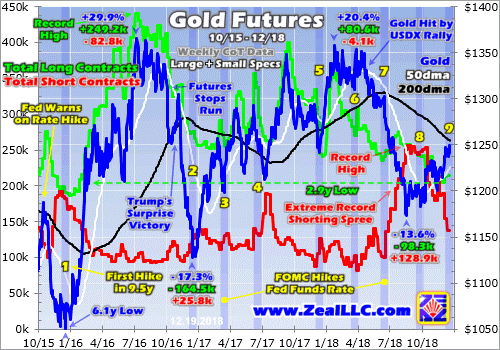
Again, this entire gold bull was born the day after the Fed’s first rate hike of this cycle, resulting in that big initial 29.9% gold upleg over 6.7 months in essentially H1’16. That left gold overbought so it started to correct like normal. But that was greatly exacerbated by Trump’s surprise election victory which ignited a monster stock-market rally on hopes for big tax cuts soon. Investors aggressively fled gold to chase stocks.
But gold bottomed in mid-December 2016 the day after this cycle’s second rate hike, and soon started surging sharply higher. Yet gold-futures speculators didn’t learn their lesson, and continued to dump gold heading into FOMC decisions with expected rate hikes. Gold rallied strongly immediately out of the 3rd, 5th, and 6th hikes of this cycle, and soon after the 4th and 8th. Rate hikes have definitely proven bullish for gold!
The 7th rate hike in mid-June 2018 was a major exception. Gold fell sharply in subsequent days as gold-futures speculators lapsed into a stunning extreme record orgy of short selling. Initially sparked by a U.S. dollar rally, that epic gold-futures shorting soon took on a life of its own driving total short contracts to their highest levels ever by far! That ultimately blasted gold to a deep and unsustainable 19.3-month low in mid-August.
Most of that shorting spree has been covered since, fueling most of gold’s young upleg since. But the long-side gold-futures speculators who control much more capital than short-side guys have barely started to buy. Short covering is legally mandated to repay the debts incurred by borrowing to short sell. But long buying is totally voluntary, speculators have to believe gold is heading higher to make leveraged bets on it.
At the end of November the day before Powell’s about-face on how far rates were from neutral, the total gold-futures longs held by speculators had crumbled to just 204.9k contracts. That was a serious 2.9-year low, levels last seen in late January 2016 just as this gold bull was starting to march higher. So gold-futures speculators are nearly as under-deployed in gold as they were near the end of its last secular bear!
That leaves vast room for them to buy to reestablish normal positions. Back in essentially the first half of 2016, speculators added 249.2k longs while covering 82.8k shorts to help catapult gold 30% higher. It’s amazing to see similar long-buying potential today, with speculators’ total longs running just 7% up into their past year’s trading range. We’re nearing the tipping point where short covering ignites far-bigger long buying.
Gold bull uplegs have 3 distinct stages that trigger and unfold in telescoping fashion. They all start out of major lows with that mandatory gold-futures short covering, the first stage. That eventually pushes gold high enough for long enough to entice long-side gold-futures speculators to return, the second stage. I suspect this week’s dovish FOMC meeting could prove the catalyst that ignites big stage-two gold buying.
This latest dot plot may not have been dovish enough for traders, but Fed dovishness will snowball with stock-market weakness. The lower the stock markets slide, whether or not Fed hawkishness is really to blame, the more pressure on the FOMC to slow or even stop its future-rate-hike tempo. Gold-futures speculators will crowd into gold to chase its upside momentum with their feared rate-hike boogeyman fading.
But all the stage-one and stage-two gold-futures buying that fuels young gold uplegs is just the prelude to far-larger stage-three investment buying. After gold’s upleg grows large enough and lasts long enough to spawn investor interest, their capital inflows soon dwarf anything the gold-futures speculators could ever manage. There’s also precedent in this cycle for Fed rate hikes soon leading to surging gold investment demand.
A great high-resolution proxy for gold investment-demand trends is the amount of physical gold bullion held in trust by the dominant GLD SPDR Gold Shares gold ETF. It effectively acts as a conduit for the vast pools of American stock-market capital to slosh into and out of gold. Just a couple weeks ago I wrote an essay on how GLD works and why it is critically important to gold prices, especially during stock selloffs.
This next chart looks at GLD’s holdings superimposed over the gold price, with all 9 Fed rate hikes of this cycle highlighted. While gold-futures trading usually dominates gold prices, it is still easily overpowered by material flows of American stock-market capital into or out of gold via GLD. Investors have started to return to gold again on the stock-market selloff, and this prudent reallocation should accelerate on Fed dovishness.
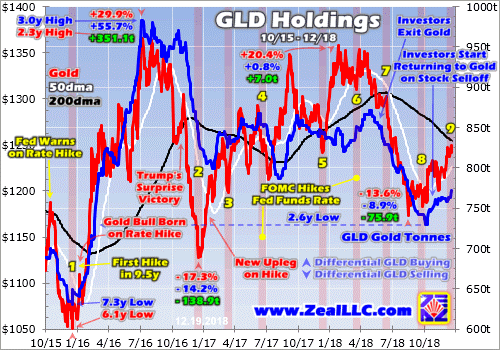
The last time American stock investors were worried enough about stock-market selloffs to redeploy into gold for refuge was that first half of 2016. Since gold is a rare counter-moving asset that tends to rally as stock markets weaken, investment demand soars when the S&P 500 slides long enough to ignite serious concerns. We’re certainly getting to that point again, as worries are mounting about this latest major selloff.
Gold went from being left for dead in mid-December 2015 to surging 29.9% higher in just 6.7 months solely on American stock investors returning! This is no generalization, the hard numbers prove it without a doubt. The world’s best gold fundamental supply-and-demand data comes from the venerable World Gold Council. It releases fantastic quarterly reports detailing the global buying and selling happening in gold.
Gold blasted higher on stock weakness in Q1’16 and Q2’16. According to the latest data from the WGC, total world gold demand climbed 188.1 and 123.5 metric tons year-over-year in those key quarters. That was up 17.1% and 13.2% YoY respectively! But the real stunner is exactly where those major demand boosts came from. It wasn’t from jewelry buying, central-bank buying, or even physical bar-and-coin investment.
In Q1’16 and Q2’16, GLD’s holdings alone soared 176.9t and 130.8t higher on American stock investors redeploying into gold after back-to-back S&P 500 corrections. Incredibly this one leading gold ETF accounted for a staggering 94% of overall global gold demand growth in Q1’16 and 106% in Q2’16! So there’s no doubt without American stock investors fleeing into gold via GLD this gold bull never would’ve been born.
Gold was holding those sharp gains throughout 2016 until Trump’s surprise presidential victory unleashed a monster stock-market run on hopes for big tax cuts soon. Gold was pummeled in Q4’16 as American stock investors pulled capital back out to chase the newly-soaring S&P 500. That quarter total global gold demand per the WGC fell 103.4t YoY or 9.0%. GLD’s 125.8t Q4’16 holdings draw accounted for 122% of that!
Fast-forward to summer 2018, and investors again started shifting out of gold to chase euphoric U.S. stock markets nearing new record highs. That forced GLD’s holdings to a deep 2.6-year low, investors hadn’t been so underinvested in gold since early in this bull market when they started flooding back in helping to catapult gold sharply higher. That gives them massive room to buy back in since their allocations are so low.
This mass exodus of American stock-market capital out of gold via GLD ended in mid-October the exact day the S&P 500 started plunging in what’s grown into this newest correction-grade selloff! Ever since GLD’s holdings have continued recovering on more capital inflows, helping to drive gold higher. This trend should only accelerate as stage-two gold-futures long buying on Fed dovishness further lifts gold prices.
Investors are often as momentum-driven as futures speculators, but over much-longer time horizons. So as this young gold upleg grows, gold is going to look much more attractive to them. Their desire to chase its upside performance is really intensified by material stock-market weakness. That makes gold stand out as not just a safe-haven capital-preservation hedge, but a way to grow wealth while everything else burns.
And as goes gold, so go the stocks of its miners. Last week I wrote a whole essay detailing the imminent major upside triple breakout in gold stocks likely to be triggered by a dovish FOMC. That indeed started to happen this week before the Fed, as this updated GDX chart shows! The GDX VanEck Vectors Gold Miners ETF is the leading gold-stock investment vehicle and benchmark, and remains poised for massive gains.
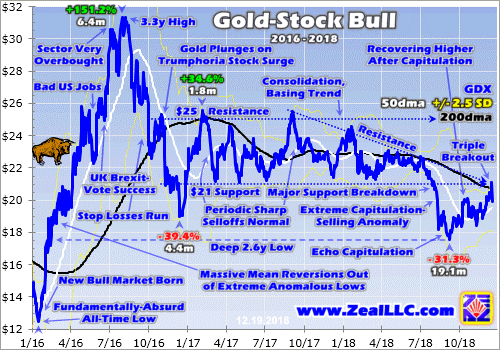
Three major resistance zones have converged at GDX $21. They include its 200-day moving average, past-year descending-triangle overhead resistance, and the old consolidation basing trend’s support. In anticipation of a gold rally on a dovish Fed, GDX closed above $21 on Tuesday. And in the hours before that FOMC decision Wednesday, it hit $21.47 intraday which was very-bullish decisive-breakout territory.
But when futures speculators bid the U.S. dollar higher and pushed gold lower on this latest dot-plot rate-hike outlook not being dovish enough, the gold stocks reversed hard. GDX plummeted a staggering 7.3% intraday across that FOMC decision! It closed 5.4% lower, making for absurd 9.0x downside leverage to gold’s small 0.6% Fed Day loss. That was a wildly-irrational downside anomaly that never should’ve happened.
In trying to figure out why after Wednesday’s close, I waded through dozens of gold stocks to see if there was some adverse news besides a not-dovish-enough FOMC. There was nothing. But provocatively in after-hours trading soon after the U.S. stock-market close, many if not most of the gold stocks had already regained 2/3rds to 3/4ths of that day’s crazy losses! So traders realized that kneejerk selloff wasn’t righteous.
Indeed right out of the gates Thursday GDX surged 4.1% higher erasing over 7/10ths of the extreme Fed Day losses. Remember market reactions to FOMC decisions usually aren’t fully apparent until the entire next trading day, after the implications have sunk in and overseas traders have reacted. Gold stocks’ major-upside-breakout thesis portending a powerful new upleg remains intact, the Fed likely accelerated it.
The beaten-down gold miners’ stocks remain the last cheap sector in the entire stock markets, a coiled spring ready to soar as gold returns to favor. The more shorts covered and longs bought by gold-futures speculators, and the more capital investors allocate back into gold, the greater the upside the gold miners’ stocks have as gold powers higher. Their potential gains are enormous, dwarfing anything else in 2019.
Again the last time major stock-market weakness rekindled gold investment demand was essentially the first half of 2016, when gold powered 29.9% higher. That drove a parallel monster 151.2% gold-stock upleg per GDX, making for huge 5.1x upside leverage. The gains in major gold stocks generally amplify gold upside by 2x to 3x, and smaller mid-tier miners with superior fundamentals tend to do much better than that.
The key to riding any gold-stock bull to multiplying your fortune is staying informed, both about broader markets and individual stocks. That’s long been our specialty at Zeal. My decades of experience both intensely studying the markets and actively trading them as a contrarian is priceless and impossible to replicate. I share my vast experience, knowledge, wisdom, and ongoing research through our popular newsletters.
Published weekly and monthly, they explain what’s going on in the markets, why, and how to trade them with specific stocks. They are a great way to stay abreast, easy to read and affordable. Walking the contrarian walk is very profitable. As of Q3, we’ve recommended and realized 1045 newsletter stock trades since 2001. Their average annualized realized gains including all losers is +17.7%! That’s double the long-term stock-market average. Subscribe today and take advantage of our 20%-off holidays sale!
The bottom line is this week’s FOMC decision is very bullish for gold and its miners’ stocks going forward. While only seeing 1 of 3 projected 2019 rate hikes axed wasn’t considered dovish enough, it still showed the Fed’s hawkish resolve is cracking. That dovishness will mount the longer stock markets remain weak, further shortening and shrinking this rate-hike cycle. That green lights capital returning to gold in a big way.
There is massive room to buy back in, with both speculators’ gold-futures longs and stock investors’ gold held via GLD just modestly above major multi-year lows. Dovish Fedspeak, weaker stock markets, and higher gold prices will really motivate them to reestablish normal gold positions and portfolio allocations. The gold miners’ stocks will be the major beneficiaries of higher gold prices, nicely leveraging gold’s gains.
Adam Hamilton, CPA
December 21, 2018
Copyright 2000 – 2018 Zeal LLC (www.ZealLLC.com)
- The U.S. stock market continues to implode. At the same time, precious metals, bitcoin, and the Indian stock market are acting as superb safe havens.
- Please click here now. Double-click to enlarge this great short term gold chart.
- Note the positive bounce from buy-side support at $1237, and the inverse H&S bottom pattern. A fresh rate hike from the Fed tomorrow could crush the stock market again, but if there’s no rate hike, that could also crash the stock market.
- That’s because money managers would believe the Fed thinks the supposed “world growth leader” economy is too weak to handle even a 2.5% Fed funds rate!
- This Fed meeting could be an important catalyst that makes institutional money managers start to get serious about viewing gold as a respected asset class… that is here to stay.
- On that note, please click here now. While an overdue import duty cut remains elusive, the citizens of India (and China) are the clear leaders in the quest to make gold the world’s most respected asset class.
- On the government side, the Chinese government has been a leader in building gold market infrastructure to move price discovery from the dingy trading rooms of the Western fear trade to the more positive love trade environment of the East.
- The Indian government is beginning to play “catch-up”, and that’s very good news for gold investors around the world.
- Please click here now. There are currently about 400 million Indians who have internet access, and that is expected to double to 800 million quite quickly.
- The World Gold Council (WGC) estimates that 3 million Indians buy gold online, and they predict that number will soon quintuple to 15 million!
- In 2014 I predicted a “gold bull era” was being born and it would be founded on a gargantuan ramp-up in Chindian online gold demand.
- Indians can already get physical delivery from most of the online platforms when total purchases reach just one gram of online-purchased gold.
- Warren Buffett is buying into one of the platforms (Paytm). This man is an elephant hunter!
- Please click here now. Double-click to enlarge this magnificent big picture gold chart.
- An almost surreal array of positive love trade and inflation trade price drivers are converging at the same time.
- This is happening as gold bullion begins a majestic ascent from the right shoulder low of a gargantuan inverse head and shoulders bull continuation pattern.
- Sadly, to view something much less than majestic, please click here now. Double-click to enlarge. My proprietary “Graceland Traffic Light” on the weekly Dow chart has just turned amber.
- This is a rare and ominous event. U.S. stock market investors who ignore these major traffic light signals risk tremendous portfolio damage.
- If the signal stays amber as of Friday’s close, I’ll consider it a full U.S. stock market sell signal, and any positions bought above the Dow 10,000 level should be sold.
- In global stock market downturns like the current one, Canadian money managers will throw the junior mining stocks baby out with the stock market bathwater.
- Most of the smaller junior miners trade on the Canadian CDNX exchange, so it’s very important for all gold market investors to be properly diversified in what is obviously the world’s greatest asset class. Junior mining stock investors should own some of the bigger miners to get that diversification.
- Please click here now. Double-click to enlarge this spectacular GDX chart. GDX put in another day of strong upside action yesterday, and it did so as the Dow fell almost 500 points!
- On Saturday I urged my gublockchain.com subscribers to buy bitcoin (and some “alts”)… right before the latest upside blast that I predicted would be “explosive”. It was explosive, and I have the excited investors in profit booking mode now.
- I’ll boldly predict that a few more daily closes above $20.50 are going to produce an equally explosive price surge for GDX and a huge array of individual gold stocks!
Special Offer For Website Readers: Please send me an Email to freereports4@gracelandupdates.com and I’ll send you my free “Juniors With The Juice!” report. While most junior miners have a lot of hurdles to overcome, I highlight six that are likely poised for five bagger gains in 2019! I include daily chart buy and sell points for each stock.
Stewart Thomson
Graceland Updates
Stewart Thomson is a retired Merrill Lynch broker. Stewart writes the Graceland Updates daily between 4am-7am. They are sent out around 8am-9am. The newsletter is attractively priced and the format is a unique numbered point form. Giving clarity of each point and saving valuable reading time.
Risks, Disclaimers, Legal
Stewart Thomson is no longer an investment advisor. The information provided by Stewart and Graceland Updates is for general information purposes only. Before taking any action on any investment, it is imperative that you consult with multiple properly licensed, experienced and qualified investment advisors and get numerous opinions before taking any action. Your minimum risk on any investment in the world is: 100% loss of all your money. You may be taking or preparing to take leveraged positions in investments and not know it, exposing yourself to unlimited risks. This is highly concerning if you are an investor in any derivatives products. There is an approx $700 trillion OTC Derivatives Iceberg with a tiny portion written off officially. The bottom line:
Are You Prepared?
If we want to know where Gold is going we should follow Gold. Right?
How about following gold stocks? At times, they lead Gold.
What about the U.S. Dollar? Wrong!
In 2019, one market more than any other will impact Gold.
That is the stock market.
History argues (within the current context) that when the Federal Reserve ends its rate hikes, Gold’s downtrend will be over and when the Fed cuts rates, the bull market shall begin.
Fed policy is dictated by economic data and financial conditions which of course can be reflected by the stock market, which is also a reflection of corporate profits.
Extended weakness in the stock market should bring the Fed that much closer to rate cuts. However, if the stock market is able to mount a decent counter trend rally in 2019, it could raise the possibility of another hike. Right now, the market expects no hikes in 2019 and even half of a quarter point cut in 2020.
Other than the cyclical bull market of 1985 through 1987, Gold has never enjoyed a real bull market without outperforming the stock market.
Below we plot Gold and Gold against the broad stock market (NYSE). Gold is still trading below a confluence of resistance ($1260-$1270) and the Gold to stock market ratio, while trading above its 200-day moving average has not broken out of its downtrend yet.
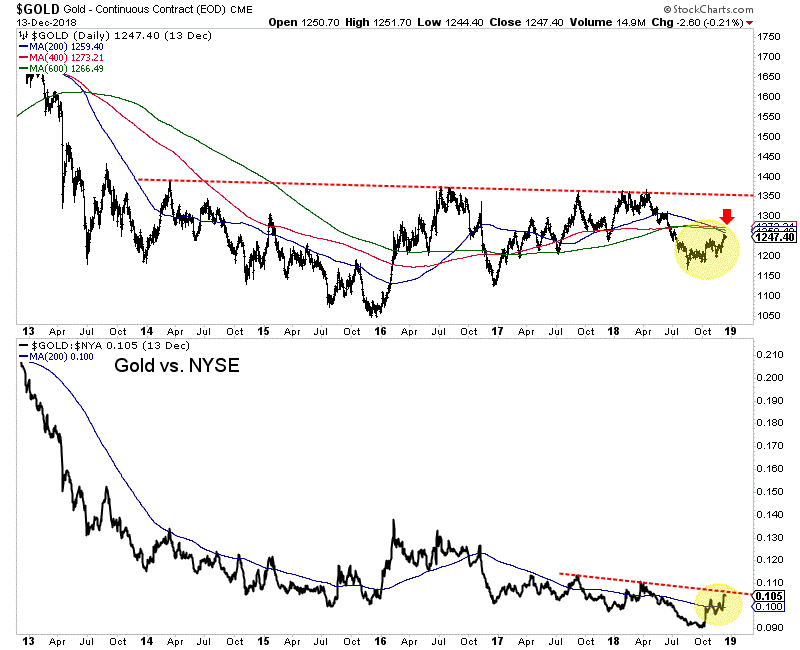
As we pen this, the stock market is breaking lower but Gold is also down and remains below a confluence of resistance at $1260-$1270/oz.
Is our thesis wrong?
The current weakness in equities has not completely changed Fed policy yet. Sure, the weakness in the equity market definitely could cause the Fed to pause its rate hikes and the market has already discounted that for 2019.
However, for the bull market in Gold to be ignited the Fed needs to move from a pause to the start of rate cuts. The current talk is about a pause, not rate cuts.
Hence, Gold is catching a bid and starting to perform better in real terms but has not reached bull market status yet.
Until Gold proves its in a bull market (and the market begins pricing in a rate cut) it would not be wise to chase strength. There will be plenty of time to get into cheap juniors that can triple and quadruple once things really get going. To prepare yourself for an epic buying opportunity in junior gold and silver stocks in 2019, consider learning more about our premium service.
The beleaguered gold stocks are recovering from their late-summer capitulation, enjoying a solid young upleg as investors gradually return. Their buying has pushed the leading gold-stock ETF near a major triple breakout technically. That event should really boost capital inflows into this sector, accelerating the rally. A major gold and gold-stock buying catalyst is likely imminent too, a more-dovish Fed this week.
The gold miners’ stocks have always been a small contrarian sector, a little-watched corner of the stock markets. But they’ve been even more unpopular than usual in recent months. That pessimistic sentiment is driven by price action, which has mostly proven poor in 2018. That’s really evident in the performance of the flagship gold-stock investment vehicle, the GDX VanEck Vectors Gold Miners ETF which is struggling.
As of the middle of this week, GDX was down 12.0% year-to-date. That leveraged gold’s YTD decline of 4.4% by 2.7x, which is perfectly normal. Because gold-stock earnings are heavily dependent on prevailing gold levels, gold-stock prices tend to amplify gold’s moves by 2x to 3x. That’s a double-edged sword, really profitable when gold rallies but cutting deeply when it retreats. The drawdowns are challenging to weather.
But gold stocks’ inherent leverage to gold is starting to work again on the upside, portending big gains ahead. This first chart looks at the major gold stocks’ technicals through the lens of GDX over the past several years. This sector soared in a new bull market, plunged with gold after Trump’s surprise election win goosed the stock markets, consolidated sideways to base, and then suffered an extreme capitulation selloff.
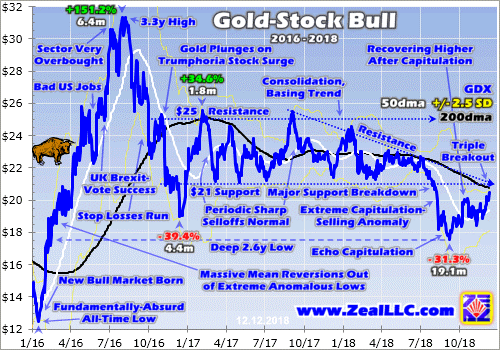
Investors and speculators often forget how explosive gold-stock upside is when gold is powering higher in an upleg. In largely the first half of 2016, GDX skyrocketed 151.2% higher in just 6.4 months! Capital just flooded back into the gold miners driven by a new gold bull’s parallel 29.9% upleg. That catapulted GDX to very-overbought levels and a 3.3-year high in mid-2016. So a normal correction got underway soon after.
GDX found support at its critical 200-day moving average, which is often the strongest support zone seen in ongoing bull markets. But that failed in November 2016 after an anomalous surprise. Trump defied the polling and odds to win the presidency while Republicans controlled both chambers of Congress. So the stock markets soared in that election’s wake on euphoric hopes for big tax cuts soon. Gold wilted on that rally.
So the gold stocks naturally followed it lower, again mirroring and amplifying its price action. After it had enjoyed stellar 5.1x upside leverage to gold in its powerful H1’16 upleg, GDX dropped 39.4% over the next 4.4 months. That leveraged gold’s own correction by 2.3x, relatively low in that usual 2x-to-3x range. GDX soon bounced sharply with gold and established a new consolidation trading range between $21 to $25.
The major gold stocks mostly meandered within that GDX range for 21.5 months. While it was vexing at times to see upside-breakout attempts fail, basing consolidations are very bullish. They provide time for bullish newer investors to acquire shares from bearish exiting ones, establishing new price norms well above previous bear-market lows. And the $23 midpoint of that GDX trading range proved relatively high.
This gold-stock bull was born out of fundamentally-absurd lows of GDX $12.47 in mid-January 2016. It peaked at $31.32 in early August that year. Oscillating around $23 on balance, GDX was basing 4/7ths up into its young bull’s entire range. The major gold stocks GDX holds were biding their time waiting for another major gold upleg to catapult them higher. They nearly broke out above $25 in early-September 2017.
But that attempt’s failure damaged psychology so traders gradually sold, this small contrarian sector left for dead. The subsequent lower highs over the next 10.4 months into mid-July 2018 formed a downward-sloping resistance line. Gold-stock prices were being compressed into a bearish descending triangle, as lower highs slumped ever closer to that major $21 support. This sector really needed a major gold rally.
Unfortunately the opposite happened this past summer, gold got hammered crushing the weakened gold stocks. The US stock markets were powering higher trying to regain record highs in July and August 2018, heavily retarding gold investment demand. On top of that the U.S. Dollar Index was surging too, both on expectations for more Fed rate hikes and an emerging-markets currency crisis led by the Turkish lira.
So gold-futures speculators started short selling gold at extreme record levels, blasting their aggregate downside bets far up into anomalous territory never before witnessed. Gold fell sharply on that record gold-futures shorting spree, dragging the struggling gold stocks down with it. So in early August GDX plunged and knifed through its longstanding $21 support. That major breakdown spawned self-feeding selling.
Gold stocks are an exceptionally-volatile sector not for the faint of heart. So it is essential to run loose trailing stop losses on gold-stock positions. While these protect investors from excessive losses, they greatly exacerbate selloffs. The lower gold stocks fell this past summer, the more stop losses were hit. These mechanical automatic sell orders then add to the downside pressure, pushing gold stocks lower still.
That vicious circle of selling begetting selling snowballed into an extreme capitulation in gold stocks, as GDX plummeted in August and early September. In just 5 weeks GDX collapsed 17.0%, far worse than gold stocks should’ve performed with gold merely slipping 1.4% lower in that span. That devastated already-shaky sentiment, leaving most investors and speculators to throw up their hands in disgust and flee.
But with GDX being pummeled to a deep 2.6-year low, the major gold stocks were wildly oversold. I explained all this in depth in an essay on gold stocks’ forced capitulation in mid-September. They were due to mean revert dramatically higher after that extreme selling anomaly. And that process has indeed been underway ever since. The gold stocks have been recovering, clawing their way out of those deep lows.
As usual gold stocks’ dominant primary driver has been gold, which has been grinding higher in its own young upleg as speculators cover their record gold-futures shorts. Investors started returning too when the lofty US stock markets began rolling over hard in mid-October. As of the middle of this week, GDX just hit a new upleg high of $20.45 on close. That extended gains since the capitulation low to 16.4% in 3.0 months.
Although considerable, the gold stocks’ rally still hasn’t grown large enough to return to the radars of contrarian investors. That could be about to change though as a rare triple breakout looks imminent! GDX, the leading gold-stock investment vehicle, is on the verge of simultaneous upside breakouts from its 3 major upper-resistance zones. That will likely unleash big gold-stock buying from technically-oriented traders.
These major resistance levels have all converged near $21. The first and most important is GDX’s key 200-day moving average, which was $20.78 this week. 200dmas are seen as the dividing line between bull and bear markets. When prices surge back above 200dmas after long periods underneath them, the upside momentum often explodes. Traders love chasing gains and 200dma breakouts portend big ones.
The past few years have several examples of gold stocks surging dramatically after 200dma breakouts. The main one was in early February 2016, when GDX rocketing back over its 200dma after deep lows confirmed a new bull market was underway. The great majority of its initial massive 151.2% upleg came after that 200dma upside breakout. Another upleg surged after a 200dma breakout in mid-August 2017.
The latest one came in late December 2017, although that was truncated early by gold stalling out. Realize that no technical line is more important to traders than 200dmas. When they see major gold stocks power decisively back over their 200dma as measured by GDX, they are likely to rush to buy in to ride the momentum. Like selling, buying begets buying. The more gold stocks rally, the more traders want them.
That imminent 200dma breakout will be all the more potent as a new-upleg signal because 2 other major resistance lines have converged there. That downward-sloping resistance line of the descending triangle has also extended right on $21. So once GDX powers decisively above it, this past year’s vexing trend of lower highs will end. Traders will see that as evidence the major gold-stock trend is reversing to higher.
The final resistance line of that triple breakout is the major $21 support of GDX’s consolidating basing range that held rock solid for over a year-and-a-half. When prices fall, old support zones often become new overhead resistance. Traders tend to want to sell again when those old support levels near. So when GDX decisively breaks back out above $21, technical fears of that former support level will vanish.
Once back over $21, GDX will return to its multi-year consolidation basing trend between $21 to $25. So the triple breakout above that old support line, downward-sloping resistance line, and 200dma would set the stage for a sharp surge back towards the top of that old trading range. While GDX $25 isn’t very high in absolute terms, it’s still another 22.2% above this week’s levels. Such a rally would spark some excitement.
Because historical gold-stock uplegs have been so enormous, generating life-changing wealth, there is always latent gold-stock interest lurking. Contrarian investors and speculators alike sour on gold stocks when they are weak, but quickly return when they show technical signs of life. A GDX triple breakout sure qualifies as that! And much-higher gold-stock prices are certainly justified fundamentally, long overdue.
Gold miners’ earnings and thus ultimately stock prices are largely a function of gold levels. Mining costs are essentially fixed during mine-planning stages. So higher gold prices flow directly through to bottom lines in amplified fashion. This is easy to understand with an example. A month ago I waded through the Q3’18 results of GDX’s major gold miners. Their average all-in sustaining costs weighed in at $877 per ounce.
That is what it costs them to produce and replenish gold, and $877 was right in line with their previous 4 quarters’ average of $867. Those collective costs will remain stable even as gold’s upleg accelerates. At gold’s own extreme-futures-short-selling-driven bottom of $1174 in mid-August, the major gold miners of GDX were still earning about $297 per ounce. Such solid levels prove that capitulation wasn’t righteous.
Last Friday gold hit a new upleg high of $1248, up 6.3% from its anomalous late-summer lows. Imagine this young upleg grows to 30% like the H1’16 one, which is quite small by historical standards. That would leave gold near $1525. At those $877 average GDX AISCs, the major gold miners’ profits would rocket to $648 per ounce. That’s 118% higher on a 30% gold upleg! Big gold-stock upside is fundamentally justified.
The ratio between the closing prices of GDX and the dominant GLD SPDR Gold Shares gold ETF is an easy approximation of the critical fundamental relationship between gold-stock prices and gold levels. This last chart is updated from a mid-October essay where I explained why gold stocks are the last cheap sector in all the stock markets. The GDX/GLD Ratio shows gold stocks have vast room to mean revert higher.
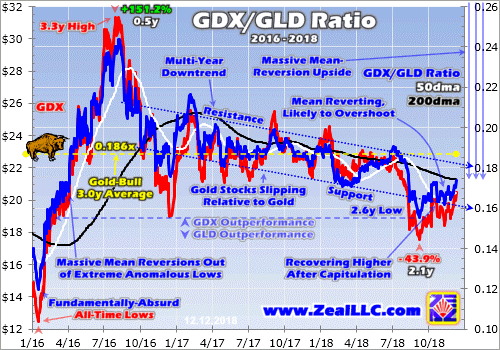
This GGR construct has averaged 0.186x during the 3.0 years of this current gold bull so far. This week the GGR clawed back to 0.174x, hitting its own 200dma. But at the gold stocks’ deep capitulation low in mid-September, the GGR plunged all the way down to 0.155x. That’s 0.031x below normal for this bull. After GGR extremes in either direction, this key ratio tends to mean revert the other way and overshoot proportionally.
That argues GDX is easily likely to surge far enough leveraging gold’s gains to regain a 0.217x GGR. That’s certainly not a high level even in the modest context of this gold bull. At this week’s $1245 gold levels which translated near $118 in GLD terms, GDX would have to surge to $25.56 to accomplish that normal mean-reversion overshoot. That’s another 25.0% higher, which would make for a solid upleg well worth riding.
And that GGR target is still incredibly low in longer secular context. In the 2 years before 2008’s first stock panic in a century, the GGR averaged 0.591x. Though gold stocks plummeted in the extreme fear that panic spawned, the GGR rebounded to average 0.422x in the 2 years after that epic anomaly. Over a longer 4-year post-panic span, it averaged 0.381x. So seeing it regain 0.217x is nothing, it should go far higher.
The bigger gold’s own upleg, the more the gold stocks will outperform by the usual 2x to 3x and force the GGR higher. At $1525 gold after a relatively-small 30% upleg, that 2009-to-2012 post-panic-average GGR of 0.381x would yield a GDX upside target around $55 per share. That’s 169% higher from this week’s levels, even without an overshoot! Gold-stock profits growth from higher gold prices justifies huge gains.
And rather conveniently on the verge of that GDX triple breakout, a major gold-buying catalyst is likely this week. On Wednesday December 19th, the Fed’s FOMC meets to decide on whether or not to hike rates for the 9th time in this cycle. That rate hike has been universally expected for months now, it is fully baked in. But the thing gold-futures and dollar-futures traders are really watching is the rate-hike forecast.
While the FOMC meets 8 times per year, at every other meeting it releases something called the dot plot. That summarizes where top Fed officials making the decisions think the federal-funds rate should be in coming years. The last dot plot was published on September 26th when the S&P 500 remained just 0.8% under its all-time record high from a week earlier. Fed officials are boldly hawkish when stocks are high.
But the stock markets soon fell apart in Q4’18, the first in history seeing full-speed quantitative-tightening monetary destruction by the Fed! Various Fed officials including the chairman have waxed more dovish since stocks started sliding. Fearing a negative wealth effect adversely impacting the US economy, their resolve to hike rates withers. So there’s a good chance this week’s dot plot will be more dovish than the last one.
Late September’s had effectively forecast 5 more Fed rate hikes including at next week’s meeting. So if this new dot plot shows less than 4 total rate hikes forecast in 2019 and 2020, dollar-futures speculators will likely sell motivating gold-futures speculators to buy aggressively. Fewer expected rate hikes are very bullish for gold, as proven in past dot plots. A great example was the 5th hike of this cycle in December 2017.
A year ago this week the FOMC hiked, but its dot-plot rate-hike forecast was dovish. Instead of upping it to 4 rate hikes in 2018 as traders expected, Fed officials left it at 3. So over the next 6 weeks, gold shot up 9.2% to $1358 on heavy gold-futures buying by speculators. A similar rally after next week’s meeting if the dot plot forecasts fewer rate hikes than the last one would drive gold right back up near $1360 again.
That’s on the verge of a major bull-market breakout which would likely unleash massive new investment buying. And any material gold rally will light a big fire under the gold stocks, rapidly driving them higher. That would put GDX’s triple breakout in the bag with haste. Nothing drives big capital inflows into the gold stocks faster than seeing them decisively rally. They are perfectly set up for major gains in coming months!
A big mean-reversion rebound higher is inevitable and likely imminent. While traders can play it in GDX, that’s mostly a bet on the largest gold miners with slowing production. The best gains by far will be won in smaller mid-tier and junior gold miners with superior fundamentals. A carefully-handpicked portfolio of elite gold and silver miners will generate much-greater wealth creation than ETFs dominated by underperformers.
The key to riding any gold-stock bull to multiplying your fortune is staying informed, both about broader markets and individual stocks. That’s long been our specialty at Zeal. My decades of experience both intensely studying the markets and actively trading them as a contrarian is priceless and impossible to replicate. I share my vast experience, knowledge, wisdom, and ongoing research through our popular newsletters.
Published weekly and monthly, they explain what’s going on in the markets, why, and how to trade them with specific stocks. They are a great way to stay abreast, easy to read and affordable. Walking the contrarian walk is very profitable. As of Q3, we’ve recommended and realized 1045 newsletter stock trades since 2001. Their average annualized realized gains including all losers is +17.7%! That’s double the long-term stock-market average. Subscribe today and take advantage of our 20%-off holidays sale!
The bottom line is the gold stocks are nearing a rare triple breakout. Three major GDX resistance zones have converged just above current levels. Once the gold stocks surge decisively over, the technically-oriented traders will take notice. They will likely start chasing the momentum accelerating the gains, with buying begetting buying. And gold stocks are so undervalued big gains are totally justified fundamentally.
This bullish outlook should be really bolstered by this week’s FOMC meeting. Worried about the recent stock-market selloff and surging volatility, top Fed officials are likely to dial back their rate-hike forecasts for next year. That will almost certainly hit the US dollar and goose gold. If gold surges again on a dovish dot plot like it has after other rate hikes in this cycle, the gold stocks will blast higher achieving that triple breakout.
Adam Hamilton, CPA
December 17, 2018
Copyright 2000 – 2018 Zeal LLC (www.ZealLLC.com)
- Where are the populist government leaders who are cutting their outrageous government debts?
- The answer, unfortunately, is that they do not exist.
- Citizens riot in France over insane fuel taxes, central bankers resign in India, markets crash in America, and England’s citizens watch their Brexit turn into an overpriced wet noodle.
- None of this fazes the world’s populist leaders. They believe they alone can fix what debt broke… with more debt!
- Please click here now. Double-click to enlarge. In the middle of all the mayhem and madness, the uncrowned queen of the world, gold bullion, sits cooler than a cucumber. Gold is showcasing a nice steady uptrend on this medium-term price chart.
- Please click here now. Heavyweight analysts at JP Morgan, Goldman, Wells Fargo, and other big banks are bullish on gold now, but many amateur analysts and investors are worried (with some sounding outright terrified) that gold is going lower.
- This is a classic wall of worry rally, and I expect the upside price action to accelerate in January and February.
- There’s also a real possibility that Trump piles on more destructive tariffs by March. If that happens, it would occur just as Chinese New Year gold buying really accelerates.
- In that scenario, gold could surge towards the key $1400 area and the US stock market would likely crash like it did in 1929.
- Please click here now. Double-click to enlarge. Investors must keep their eye on the big picture, which is all about the growth of the Chindian love trade and the rise of inflation, especially in the West.
- A new pillar of gold bullion demand could also emerge now that India’s populist leader (Modi) has essentially taken control of the nation’s central bank. A fresh survey shows that 90% of Indian households see substantially higher inflation coming in 2019. That survey was done before the nation’s top central banker resigned yesterday!
- The world’s populist leaders want interest rates to stop rising so their governments can borrow even more money and waste it on silly “people helper” programs.
- Some of the populist leaders want to buy more bombs, some want more welfare programs, but what they all have in common is they want to spend more, and more, and more! This is highly inflationary.
- Please click here now. While many amateur gold analysts have talked about their fear of lower prices, I’ve urged investors to focus on the epic upside breakout taking place on the world’s most important gold mining company. That company is: Barrick.
- Junior gold and silver stock enthusiasts can expect to see their stocks begin to follow the Barrick leader. It’s already happening with many of the CDNX-listed stocks, and this morning’s pre-market “super surge” in Barrick’s price is going to start the next major wave higher for most of the junior miners.
- What seals the deal? Answer: A weekly close above $14 for Barrick. I expect it to happen this week and investors who waste time reading the fears of the gold bears risk missing out on years of upside price action. The bottom line:
- This is not the start of a gold bull market. It’s the start of a bull era that will last a hundred years.
- I’ve predicted three U.S. rate hikes for 2019. Goldman was predicting four, but yesterday their chief economist Jay Hatzius reduced his forecast to three.
- We’re on the same page now, with both of us predicting three hikes, a surprising rise in U.S. inflation, and GDP growth that fades under the 2% marker by the second half of 2019.
- Ray Dalio is head of the world’s largest hedge fund (Bridgewater). Ray predicts an “inflationary depression” will envelop America within about two years. I think it takes three to four years, but given the danger, does the time frame really matter? The timing of a hurricane doesn’t change the fact that people need to get out of its way.
- On that note, please click here now. Just as most big bank analysts are positive about gold now, they have increasingly negative forecasts for the U.S. dollar.
- The policies of the world’s “spendaholic” populist leaders are extremely inflationary. The bank analysts know that’s bad news for dollar bugs and great news for gold stock investors.
- Please click here now. Double-click to enlarge this magnificent GDX price chart. My short term guswinger.com swing trading service has caught all the key swings in the GDX base formation, reducing boredom while making investors richer! I focus on NUGT and DUST for the short term moves and unleveraged GDX for the home run plays!
- We booked solid profits yesterday as GDX edged towards the important $20.50 price zone. After a brief pitstop at this minor resistance zone, the GDX bull is poised to drive its golden horns into the bears… and begin a magnificent charge up to $23.50!
Special Offer For Website Readers: Please send me an Email to freereports4@gracelandupdates.com and I’ll send you my free “Golden Outperformers” report. I highlight six GDXJ component stocks that are poised to immediately follow Barrick with major upside breakouts of their own! I highlight key technical signals and provide tactics to help investors book great profits.
Stewart Thomson
Graceland Updates
Written between 4am-7am. 5-6 issues per week. Emailed at aprox 9am daily.
Email:
Stewart Thomson is a retired Merrill Lynch broker. Stewart writes the Graceland Updates daily between 4am-7am. They are sent out around 8am-9am. The newsletter is attractively priced and the format is a unique numbered point form. Giving clarity of each point and saving valuable reading time.
Risks, Disclaimers, Legal
Stewart Thomson is no longer an investment advisor. The information provided by Stewart and Graceland Updates is for general information purposes only. Before taking any action on any investment, it is imperative that you consult with multiple properly licensed, experienced and qualified investment advisors and get numerous opinions before taking any action. Your minimum risk on any investment in the world is: 100% loss of all your money. You may be taking or preparing to take leveraged positions in investments and not know it, exposing yourself to unlimited risks. This is highly concerning if you are an investor in any derivatives products. There is an approx $700 trillion OTC Derivatives Iceberg with a tiny portion written off officially. The bottom line:
Are You Prepared?
In recent days we’ve seen the beginnings of an inversion in the yield curve.
The 2-year yield and the 5-year yield have inverted but not yet the the 2-year yield and the 10-year yield, the curve that is watched most. However, “2s and 10s” as bond traders would say appear headed for an inversion very soon.
We know that an inversion of the yield curve precedes a recession and bear market. That is good for Gold. But timing is important and the key word is precedes.
In order to analyze the consequences for Gold we should consult history.
First let’s take a look at the 1950-1980 period.
In the chart below we plot the Barron’s Gold Mining Index (BGMI), Gold, the Fed funds rate (FFR) and the difference between the 10-year yield and the FFR (as a proxy for the yield curve).
The six vertical lines highlight peaks in the FFR and troughs in the yield curve (YC), which begins to steepen when the market discounts the start of rate cuts. A steepening YC is and has been bullish for Gold except when it’s preceded by inflation or a big run in Gold.
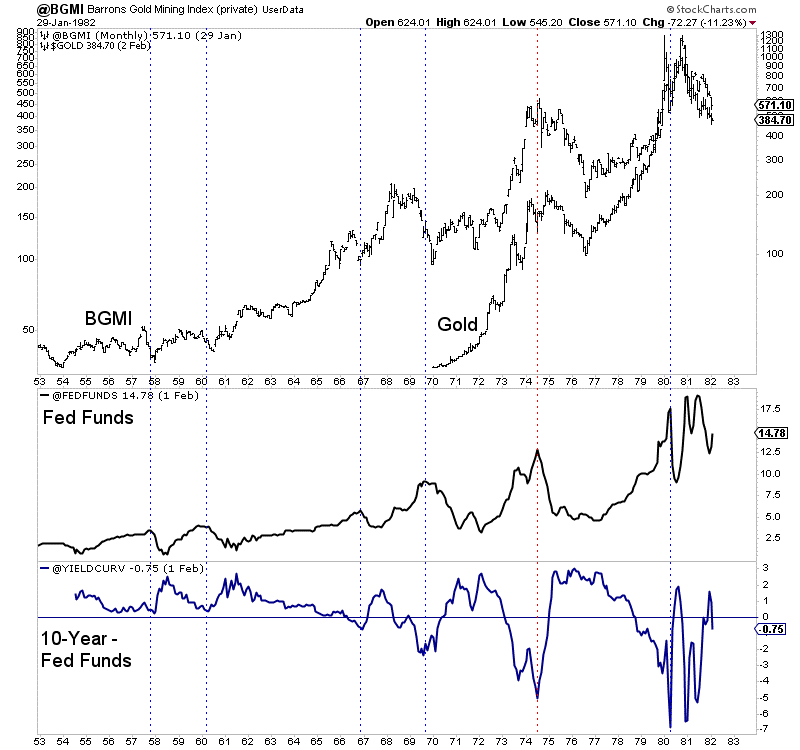
Note that five of the six lines also mark a recession except in 1966-1967.
At present, the yield curve is on the cusp of inverting for only the third time since 1990.
The previous two inversions in 2000 and 2007 were soon followed by a steepening curve as the market sensed a shift in Fed policy.
The initial rate cut in 2000 marked an epic low in the gold stocks and the start of Gold strongly outperforming the stock market. In summer of 2007 the rate cuts began and precious metals embarked on another impulsive advance.
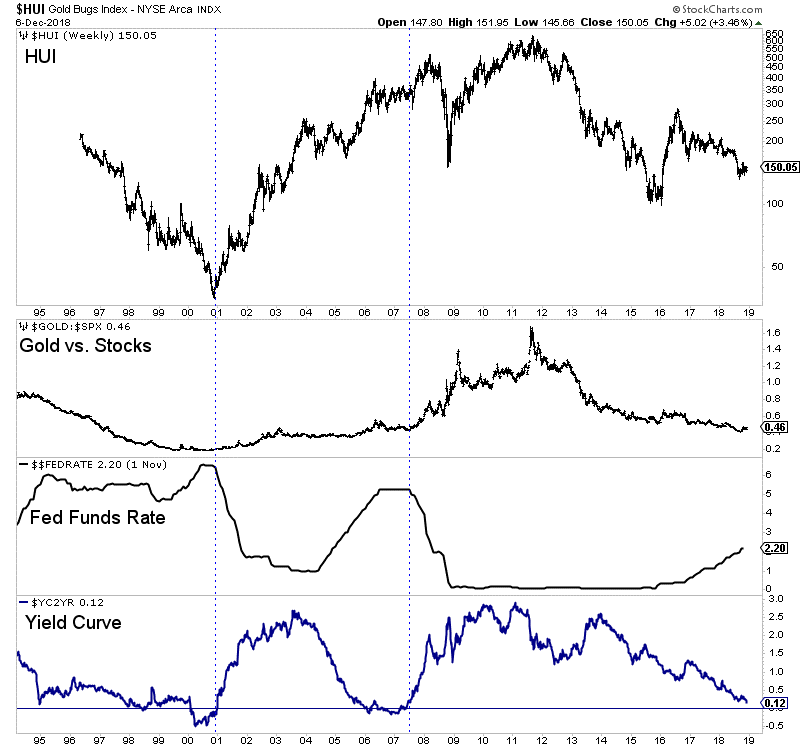
The historical inversions carry a different context but the takeaways are not so different.
Aside from the mid 1970s to the early 1980s, we find that a steepening of the curve (which accelerates from the start of Fed rate cuts) is bullish for precious metals. (This also includes a steepening in late 1984 that preceded the bull market in the mid 1980s).
With that said, the inversion itself is not bullish for precious metals because there can be a lag from then to the first rate cut and steepening of the curve.
I took a careful look at four of the previous inversions and counted the time from that point to the next significant low in gold stocks. The average and median time of those four is 10 months.
That appears to be inline with my thinking that the Federal Reserve’s final rate hike will be sometime in 2019.
In the meantime, precious metals are rallying but the inversion of the yield curve and Fed policy argue it would not be wise to chase this strength. There will be plenty of time to get into cheap juniors that can triple and quadruple once things really get going. To prepare yourself for an epic buying opportunity in junior gold and silver stocks in 2019, consider learning more about our premium service.
The recent stock-market selloff is persisting, fueling mounting worries among investors. The intensifying volatility and lack of a quick rebound higher is strangling euphoric sentiment, spawning self-reinforcing selling pressure. Scoffed at a few months ago, the notions that a young bear market is underway and a recession looms are gaining traction. The great beneficiary of this ominous stock-market downturn will be gold.
Gold has always been an essential asset class for prudently diversifying investment portfolios. Uniquely it tends to rally when stock markets weaken, offsetting some of the losses in typical stock-heavy portfolios. Gold acts like portfolio insurance, usually soaring when stock markets plunge on unforeseen news. All throughout history, wise investors have recommended everyone have 5% to 10% of their portfolios in gold.
But like insurance in general, the important role gold plays in portfolios is gradually forgotten when it isn’t needed. Just a few months ago, the U.S. stock markets seemed invincible. The flagship S&P 500 broad-market stock index (SPX) had powered 333.2% higher over 9.5 years by late September. That made for the 2nd-largest and 1st-longest stock bull in U.S. history! Investors were convinced that would last indefinitely.
The SPX had surged 9.6% year-to-date by that latest peak, while gold had slumped 7.3%. Thus investors felt no need to allocate virtually any capital to gold, they were and are radically underinvested in it. This is especially true of American stock investors, who were wildly optimistic after long years of big stock-market gains. Their effective portfolio exposure to gold was vanishingly small back in late September.
The 500 elite stocks of the SPX had an extreme collective market capitalization way up at $26,141.4b as that topping month waned. It is interesting contrasting that with the physical gold bullion holdings of the world’s dominant gold exchange-traded fund, the American GLD SPDR Gold Shares. GLD has long been the go-to destination for American stock investors looking to allocate capital for gold exposure in their portfolios.
At the end of September as stock euphoria peaked, GLD’s total holdings were merely worth $28.4b. That implies American stock investors were running trivial gold allocations around 0.11%! That’s on the order of only 1/50th the minimum 5% that’s been universally advised for centuries if not millennia. So it’s not much of a stretch to argue American stock investors had zero gold exposure, they were effectively all-out.
The sharp stock-market selloff in the few months since those halcyon all-time record highs has surprised most, but it shouldn’t have. As Q4’18 dawned, something ominous happened that was unprecedented in stock-market history. The US Federal Reserve upped its quantitative-tightening campaign necessary to start unwinding its $3625b of quantitative-easing money creation over 6.7 years to its terminal velocity.
October 2018 would be the first month ever to see the Fed’s monetary destruction ramp to a staggering $50b-per-month pace. And even to unwind just half of the Fed’s radical QE, QT would have to keep on destroying $50b per month of QE-conjured money for 30 months! At the end of September when the SPX was just 0.6% off its all-time record high, I explained all this in depth warning it was this bull’s death knell.
And indeed within a week of Fed QT going full-throttle, the SPX started to slide. There was no way QE-levitated stock markets could ignore QT obliterating that QE money. Every daily selloff since had its own unique story and specific drivers, which I discussed and analyzed in our subscription newsletters. These all added up to enough selling to spawn an ongoing stock-market correction, an SPX selloff exceeding 10%.
Blame it on Fed QT, stock-market bubble valuations, mounting US-China trade-war threats, Republicans losing the House, or whatever you want, but by Black Friday the SPX had fallen 10.2% over 2.1 months since that euphoric record peak. The stock markets staged some sharp rallies within that span, but they quickly fizzled proving to be dead-cat bounces. This recent action is ominously looking very bear-market like.
We can’t know for sure whether the long-overdue new bear market driven by epic record Fed tightening is indeed upon us until the SPX falls 20%+ on a closing basis. This recent correction would still have to double to hit that bear-market threshold. But gold has certainly been the main beneficiary of the recent stock-market weakness. Investors are starting to remember the ages-old wisdom of diversifying into gold.
This week’s chart looks at the US-dollar gold price superimposed over the SPX during the past 4 years or so. Despite gold being forgotten in recent years as the stock markets surged ever higher, it remains in a young bull market. And that was spawned by the last set of back-to-back corrections in the SPX, which catapulted gold sharply higher. We’re likely on the verge of another stock-selloff-driven major gold upleg!
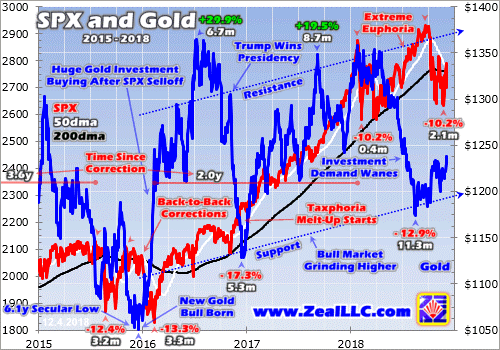
GLD’s physical-gold-bullion holdings held in trust for its shareholders reveal how American stock investors feel about gold. This past spring they started slumping as gold was sold to move even more capital into the lofty US stock markets. For 5 months in a row ending in September, GLD’s holdings retreated as investors dumped GLD shares faster than gold was falling. By early October GLD’s holdings hit a 2.6-year low.
I penned a whole essay on this stock-euphoria-driven gold exodus in late September, explaining why it was happening and why it was likely to soon reverse. And that shift in gold-investment sentiment began the very day the SPX started plunging in mid-October! Up until October 9th the stock markets looked totally normal, the SPX had only drifted a trivial 1.7% lower from its peak. Everyone remained wildly bullish.
But something snapped on October 10th, that fateful day the SPX plunged 3.3% out of the blue on no catalyst at all. Heavy technically-motivated selling accelerated led by the market-darling mega tech stocks. For years investors had believed them bulletproof, their businesses so good they could weather any stock selloff or economic slowdown. Fears surged on the worst SPX down day since back in early February.
That very day American stock investors started returning to gold. They poured capital into GLD shares so aggressively they forced a major 1.2% holdings build. GLD’s mission is to track the gold price, but it has its own supply-and-demand profile independent from gold’s. So when GLD shares are being purchased faster than gold is bought, GLD’s share price threatens to decouple to the upside on that excess demand.
So GLD’s managers must vent that differential buying pressure directly into the physical gold market in order to equalize it and maintain tracking. They do this by issuing enough new GLD shares to satisfy all the excess demand, and then plow the cash proceeds into gold bullion. Thus rising GLD holdings show American stock-market capital is flowing into gold. That proved to be GLD’s biggest build in 6.7 months.
That fateful day proved a major inflection point for both near-record US stock markets and the extremely-unpopular gold. As the SPX continued to weaken over the next couple months, GLD continued to enjoy modest builds on investment gold buying. By late November GLD’s holdings had climbed a considerable 4.5% over 6 weeks. That has helped push gold 5.5% higher since its mid-August lows, a solid young upleg.
Odds are that gold buying via GLD by American stock investors is only beginning. The longer this stock-market weakness persists, the deeper their worries will grow. And the more their stock-heavy portfolios bleed, the quicker they will remember they should’ve allocated 5% to 10% to gold. Once gold investment demand is kindled by falling stock markets, it tends to balloon dramatically and take on a life of its own.
Gold’s young bull market today that was forgotten this summer began as 2016 dawned. Much like this year, in the first half of 2015 the US stock markets were powering to dazzling new record highs. Since it seemed like stocks could do nothing but rally indefinitely, gold was forgotten and shunned. It slumped to a brutal 6.1-year secular low by mid-December 2015, with investors really wanting nothing to do with it.
But their ironclad euphoria started to crack soon after the stock markets corrected. In mid-2015 the SPX finally suffered its first correction in an incredibly-extreme 3.6 years after being levitated by relentless Fed money creation from its third quantitative-easing campaign. Gold caught a bid on that 12.4% SPX selloff over 3.2 months, but then faded again into the expected first Fed rate hike in 9.5 years in mid-December.
Then the SPX fell into another 13.3% correction over 3.3 months into early 2016. Seeing menacing back-to-back corrections after long years without one really deflated gold-suppressing stock-market euphoria. So in early 2016 American stock investors began prudently rediversifying their stock-dominated portfolios into gold. That birthed today’s gold bull, and the gold-buying momentum fed on itself to drive a powerful upleg.
Gold went from being left for dead in mid-December 2015 to surging 29.9% higher in just 6.7 months solely on American stock investors returning! This is no generalization, the hard numbers prove it without a doubt. The world’s best gold fundamental supply-and-demand data comes from the venerable World Gold Council. It releases fantastic quarterly reports detailing the global buying and selling happening in gold.
Gold blasted higher on SPX weakness in Q1’16 and Q2’16. According to the latest data from the WGC, total world gold demand climbed 188.1 and 123.5 metric tons year-over-year in those key quarters. That was up 17.1% and 13.2% YoY respectively! But the real stunner is exactly where those major demand boosts came from. It wasn’t from jewelry buying, central-bank buying, or even physical bar-and-coin investment.
In Q1’16 and Q2’16, GLD’s holdings alone soared 176.9t and 130.8t higher on American stock investors redeploying into gold after back-to-back SPX corrections. Incredibly this one leading gold ETF accounted for a staggering 94% of overall global gold demand growth in Q1’16 and 106% in Q2’16! So there’s no doubt without American stock investors fleeing into gold via GLD this gold bull never would’ve been born.
Gold was holding those sharp gains throughout 2016 until Trump’s surprise presidential victory unleashed a monster stock-market run on hopes for big tax cuts soon. Gold was pummeled in Q4’16 as American stock investors pulled capital back out to chase the newly-soaring SPX. That quarter total global gold demand per the WGC fell 103.4t YoY or 9.0%. GLD’s 125.8t Q4’16 holdings draw accounted for 122% of that!
Gold’s fortunes are being driven by American stock investors’ collective buying and selling of GLD shares. And nothing motivates them to redeploy capital into gold to diversify their stock-heavy portfolios like major SPX selloffs. Recent months’ one has already proven serious enough to rekindle differential GLD-share buying. And as H1’16 proved, once investors start driving gold higher its rallies tend to become self-feeding.
The more physical gold bullion American stock investors buy via GLD shares, the more gold climbs. The higher gold rallies, the more investors want to buy it to ride the momentum and chase its gains. So buying begets buying, driving gold higher fairly rapidly. And when stock markets are sliding, gold is often the only asset class rallying. That makes it even more attractive to investors getting pounded by sliding stocks.
This latest SPX correction is even more damaging to sentiment because it is 2018’s second one. Back in early February the SPX plunged 10.2% in 0.4 months, which started to crack sentiment. Back when this gold bull was born it was the second of back-to-back SPX corrections that proved the coup de grâce in hurting stock-market sentiment enough to unleash a reallocation into gold. This scenario is playing out again.
Provocatively seeing the three major US stock indexes suffer two 10%+ corrections within any single calendar year is itself a super-bearish omen. 2018 joined 1973, 1974, 1987, 2000, 2001, 2002, and 2008 as the SPX’s only other dual-correction years. Those coincided with a 48.2% SPX bear, a 20.5% single-day SPX crash, another 49.1% SPX bear, and a third 56.8% SPX bear! All three bears triggered recessions.
This stock-market weakness isn’t only likely to persist, but the odds really favor it snowballing into another major SPX bear market. Gold investment demand will naturally surge as stocks burn, fueling a strong bull market. Gold’s 29.9% gain over 6.7 months at best so far in this bull is nothing. Gold’s last secular bull from April 2001 to August 2011 saw it soar 638.2% higher! Gold’s gains as the SPX rolls over should be massive.
With a trivial 0.1% portfolio allocation to gold, what happens to gold prices if American stock investors just return to a still-immaterial 1.0%? That’s still way under the 5% to 10% recommended in normal times, and plenty of great investors believe 20% gold allocations are necessary during stock bears. Gold’s upside from here with virtually-zero US-stock-market capital allocated to it is vast. And it could accelerate rather fast.
The timing of this current SPX correction is likely to magnify bearish psychology. It has occurred entirely within Q4’18. The SPX exited Q3’18 just 0.6% off its record peak from a week earlier. So I suspect a lot of American retirement investors have no idea just how much carnage their precious capital has suffered. When they get their quarterly statements from their money managers in January, they could really freak out.
Even worse, far too much of this retirement capital was allocated to the market-darling mega techs which were the biggest holdings across most funds. Their losses have far outpaced the SPX’s. As of that latest correction low on Black Friday when the SPX was down 10.2%, Apple, Amazon, Microsoft, Alphabet, Facebook, and Netflix had collapsed 25.8%, 26.4%, 10.8%, 19.9%, 39.4%, and 38.2% from their all-time highs!
The mega techs that nearly single-handedly pushed the SPX higher for years averaged 26.8% losses, or 2.6x the SPX’s! When investors who don’t closely follow the stock markets figure that out next month, the investment demand for rallying gold ought to explode. The first half of 2019 has a setup much like H1’16, where gold essentially powered 30% higher. A similar upleg from mid-August’s lows isn’t a stretch at all.
Another 30% run from $1174 would leave gold at $1525. And once gold climbs decisively back over its bull-to-date high of $1365 from early-July 2016, investment interest and demand will soar. Just like the mega tech stocks, the higher gold prices the more investors want to buy it. A mere 16% gold upleg off August’s lows, or another 10% higher from this week’s levels, would near that psychologically-huge bull breakout!
All investors should always have 5% to 10% of their investable capital allocated to gold. But almost none do today as a long-overdue bear market fueled by epic record Fed QT looms. If you don’t have that core gold allocation, you need to get it in place before stocks fall much farther and gold surges much higher. The gold miners’ stocks will greatly leverage gold’s gains too, their leading index soared 182.2% largely in H1’16!
Absolutely essential in bear markets is cultivating excellent contrarian intelligence sources. That’s our specialty at Zeal. After decades studying the markets and trading, we really walk the contrarian walk. We buy low when few others will, so we can later sell high when few others can. While Wall Street will deny the coming stock-market bear all the way down, we will help you both understand it and prosper during it.
We’ve long published acclaimed weekly and monthly newsletters for speculators and investors. They draw on my vast experience, knowledge, wisdom, and ongoing research to explain what’s going on in the markets, why, and how to trade them with specific stocks. As of Q3, we’ve recommended and realized 1045 newsletter stock trades since 2001. Their average annualized realized gain is +17.7%! That’s double the long-term stock-market average. Subscribe today and take advantage of our 20%-off holidays sale!
The bottom line is this stock selloff is boosting gold. Flagging gold investment demand turned on a dime when the stock markets started plunging in mid-October. Gold has rallied on balance since as American stock investors start redeploying capital. Their buying alone via GLD shares was fully responsible for gold’s sharp 30% upleg in 2016’s first half. That followed the last back-to-back corrections in US stock markets.
And between record Fed tightening running full-throttle, continuing dangerous bubble valuations, and the mounting trade wars, this recent stock selling is likely to persist on balance. So gold investment will look far more attractive. Coming from virtually-zero gold portfolio allocations, investors have massive buying to do. The higher they push gold, the more other investors will chase it. Especially as US stock markets weaken.
Adam Hamilton, CPA
Copyright 2000 – 2018 Zeal LLC (www.ZealLLC.com)
December 4, 2018
- The double bottom is the world’s most stressful chart pattern. It forms after a significant price decline. The first low in the pattern creates substantial panic and fear in most investors.
- The second low in the pattern is “softer”, but no less dangerous to emotionally vulnerable investors. The volume is generally weak and the price action makes investors feel like they are in some kind of financial gulag.
- Then the sun bursts out from behind those financial clouds, and glorious upside action begins! On that fabulous note, please click here now. Double-click to enlarge the spectacular price action on this daily gold chart.
- The long term fundamentals and liquidity flows for gold should never be confused with the medium or short term. In the long term, the biggest driver of gold price appreciation is the Chindian “wealth effect”.
- It’s all about Chinese and Indian citizens growing their standard of living and buying ever-more gold to celebrate the good times.
- In the West, inflation is the most potent driver of the gold price and America is beginning an enormous inflation cycle that will likely continue for fifteen to twenty years.
- As Chindians bring respect to gold as an asset class, Western gold bugs won’t need to hide in the closet when they buy it because everybody will be able to get it online from companies like Amazon.
- It will be as mundane as buying a coffee at Starbucks is now, but much more profitable!
- In a nutshell, the love trade of three billion Chindians combined with the inflation trade of at least 500 million Westerners will soon completely restore gold’s shimmer and place as the ultimate asset.
- Please click here now. Double-click to enlarge. All investors should keep their eye on the price action taking place on this long term gold chart. Note the RSI oscillator. It’s poised to leap above 50 and that’s in sync with the arrival of Chinese New Year seasonality.
- Some heavyweight money managers believe that an inflationary surprise is coming to America, and it could happen as early as this Friday’s jobs report.
- On that very interesting note, please click here now. Double-click to enlarge. A surprising uptick in US wage inflation is imminent and it will be a tremendous tail wind for silver’s upside price action. I don’t know if that inflationary surprise happens in Friday’s jobs report or not, but I do want investors to be positioned to get richer if it occurs!
- In the short term precious metals market, I might be shorting GDX via DUST (although the good news is that I currently hold NUGT), but that has nothing to do with the fabulous long term fundamentals in play for the entire precious metals market.
- At my short term guswinger.com trading service the average NUGT/DUST or UDOW/SDOW trade lasts only a week or two. I increased my average trade size threefold yesterday… to enhance the adrenaline rush and the profits, with professionally managed risk. Investors should always separate trading accounts from long term core position investing accounts. They are as different as night and day.
- Please click here now. Jay Powell had to “blink” with rate hikes and so did Donald Trump with tariff taxes or the U.S. stock market would have incinerated yesterday. So, when Trump “supersized” Powell’s blink with his tariffs blink, the US stock market rocketed higher and I promptly sold half my UDOW swing trade position as the market opened. From there, the rally faded. Pros sold the news.
- In the big picture, I think most stock market bulls and bears are working a bit too hard to predict either “make my stock market great” higher prices or the end of the bull market.
- It’s simply later in the U.S. business cycle now than it was a year ago, and it will be even later as 2019 gets underway. As the cycle matures, volatility typically grows and that makes analysts a bit desperate about trying to figure out what comes next.
- Reality check: What comes next is vastly much wilder price action than has occurred at any point in this bull market! That’s just what happens as earnings fade and inflation rises in an environment of debt worship.
- Please click here now. Whether it’s the U.S. government’s maniacal obsession with debt growth and citizen extortion via income and capital gains taxation, the emergence of wage inflation, the negative effect of quantitative tightening on corporate stock buyback programs, or the inverting yield curve, what matters is that it’s all happening in the late stage of the business cycle. Price volatility is poised to go “off the charts” in 2019 as these forces intensify dramatically and synergistically.
- Stock market investors should not waste time trying to figure out what comes next. There’s only one course of obvious tactical action for long term U.S. stock market investors, and that is: Reduce trade size now!
- With the daily gold chart looking spectacular, what can gold stock investors expect? Well, for 2018 I’ve predicted that the “tax loss selling” of the past few years will be confined mainly to the tiny CDNX-listed juniors. GDX, GDXJ, and SIL and their component stocks are in great shape and poised to join gold in a “shotgun” move higher for the medium term.
- Please click here now. Double-click to enlarge this GDX daily chart. GDX is sporting dual inverse head and shoulders patterns.
- From a technical perspective, GDX can be viewed as a sports car with twin technical turbos that is revving its engine now. GDX appears poised to rise to the minor highs around $20.50, and then race straight to my $23.50 target zone!
- There could be some wild volatility around Friday’s jobs report and the December 19 Fed meeting, but the dual H&S patterns are a powerful technical force to be reckoned with. When both the short term technicals and the long term fabulous fundamentals are weighed carefully, most gold stock investors should be in great spirits and ready for the upside journey of a lifetime!
Special Offer For Website Readers: Please send me an Email to freereports4@gracelandupdates.com and I’ll send you my free “Back Up The Golden Truck!” report. I highlight six under the radar junior gold stocks that could stage five bagger gains or more in 2019. I include key buy and sell signals for each stock!
Stewart Thomson
Graceland Updates
Email:
Stewart Thomson is a retired Merrill Lynch broker. Stewart writes the Graceland Updates daily between 4am-7am. They are sent out around 8am-9am. The newsletter is attractively priced and the format is a unique numbered point form. Giving clarity of each point and saving valuable reading time.
Risks, Disclaimers, Legal
Stewart Thomson is no longer an investment advisor. The information provided by Stewart and Graceland Updates is for general information purposes only. Before taking any action on any investment, it is imperative that you consult with multiple properly licensed, experienced and qualified investment advisors and get numerous opinions before taking any action. Your minimum risk on any investment in the world is: 100% loss of all your money. You may be taking or preparing to take leveraged positions in investments and not know it, exposing yourself to unlimited risks. This is highly concerning if you are an investor in any derivatives products. There is an approx $700 trillion OTC Derivatives Iceberg with a tiny portion written off officially. The bottom line:
Are You Prepared?
December 3, 2018
The junior gold miners’ stocks have spent recent months mostly languishing near major multi-year lows. That spawned a sentiment wasteland riddled by bearishness and bereft of bids. But these companies’ battered stock prices aren’t fundamentally righteous, as proven yet again by their latest earnings season. Faring far better in a challenging third quarter than stock prices imply, they need to mean revert way higher.
Four times a year publicly-traded companies release treasure troves of valuable information in the form of quarterly reports. Companies trading in the States are required to file 10-Qs with the U.S. Securities and Exchange Commission by 40 calendar days after quarter-ends. Canadian companies have similar requirements at 45 days. In other countries with half-year reporting, many companies still partially report quarterly.
The definitive list of elite “junior” gold stocks to analyze comes from the world’s most-popular junior-gold-stock investment vehicle. Mid-month the GDXJ VanEck Vectors Junior Gold Miners ETF reported $4.1b in net assets. Among all gold-stock ETFs, that was second only to GDX’s $9.0b. That is GDXJ’s big-brother ETF that includes larger major gold miners. GDXJ’s popularity testifies to the great allure of juniors.
Unfortunately this fame created serious problems for GDXJ a couple years ago, resulting in a stealthy major mission change. This ETF is quite literally the victim of its own success. GDXJ grew so large in the first half of 2016 as gold stocks soared in a massive upleg that it risked running afoul of Canadian securities laws. And most of the world’s smaller gold miners and explorers trade on Canadian stock exchanges.
Since Canada is the centre of the junior-gold universe, any ETF seeking to own this sector will have to be heavily invested there. But once any investor including an ETF buys up a 20%+ stake in any Canadian stock, it is legally deemed to be a takeover offer that must be extended to all shareholders! As capital flooded into GDXJ in 2016 to gain junior-gold exposure, its ownership in smaller components soared near 20%.
Obviously hundreds of thousands of investors buying shares in an ETF have no intention of taking over gold-mining companies, no matter how big their collective stakes. That’s a totally-different scenario than a single corporate investor buying 20%+. GDXJ’s managers should’ve lobbied Canadian regulators and lawmakers to exempt ETFs from that 20% takeover rule. But instead they chose an inferior, easier fix.
Since GDXJ’s issuer controls the junior-gold-stock index underlying its ETF, it simply chose to unilaterally redefine what junior gold miners are. It rejiggered its index to fill GDXJ’s ranks with larger mid-tier gold miners, while greatly demoting true smaller junior gold miners in terms of their ETF weightings. This controversial move defying long decades of convention was done quietly behind the scenes to avoid backlash.
There’s no formal definition of a junior gold miner, which gives cover to GDXJ’s managers pushing the limits. Major gold miners are generally those that produce over 1m ounces of gold annually. For decades juniors were considered to be sub-200k-ounce producers. So 300k ounces per year is a very-generous threshold. Anything between 300k to 1m ounces annually is in the mid-tier realm, where GDXJ now traffics.
That high 300k-ounce-per-year junior cutoff translates into 75k ounces per quarter. Following the end of the gold miners’ Q3’18 earnings season in mid-November, I dug into the top 34 GDXJ components’ results. That’s simply an arbitrary number that fits neatly into the tables below. Although GDXJ included a staggering 70 component stocks mid-month, the top 34 accounted for a commanding 82.9% of its total weighting.
Out of these top 34 GDXJ companies, only 3 primary gold miners met that sub-75k-ounce-per-quarter qualification to be a junior gold miner! Their quarterly production is rendered in blue below, and they collectively accounted for just 3.8% of this ETF’s total weighting. GDXJ is inarguably now a pure mid-tier gold-miner ETF, not a junior one. But its holdings include the world’s best gold miners with huge upside potential.
I’ve been doing these deep quarterly dives into GDXJ’s top components for years now. In Q3 2018, fully 31 of the top 34 GDXJ components were also GDX components! These are separate and distinct ETFs, a “Gold Miners ETF” and a “Junior Gold Miners ETF”. So they shouldn’t have to own many of the same companies. In the tables below I highlighted the symbols of rare GDXJ components not also in GDX in yellow.
These 31 GDX components accounted for 79.2% of GDXJ’s total weighting, not just its top 34. They also represented 31.7% of GDX’s total weighting. Thus nearly 4/5ths of this “Junior Gold Miners ETF” is made up by nearly 1/3rd of the major “Gold Miners ETF”! These GDXJ components also in GDX are clustered from the 11th- to 30th-highest weightings in that latter larger ETF. GDXJ is mostly smaller GDX stocks.
In a welcome change from GDXJ’s vast component turmoil of recent years, only 4 of its top 34 stocks are new since Q3 2017. Their symbols are highlighted in light blue below. Thus the top GDXJ components’ collective results are finally getting comparable again in year-over-year terms. Analyzing ETFs is much easier if their larger components aren’t constantly in flux. Hopefully changes going forward are relatively minor.
Despite all this, GDXJ remains the leading “junior-gold” benchmark. So every quarter I wade through tons of data from its top components’ latest results, and dump it into a big spreadsheet for analysis. The highlights make it into these tables. Most of these top 34 GDXJ gold miners trade in the US and Canada, where comprehensive quarterly reporting is required by regulators. But others trade in Australia and the UK.
In these countries and most of the rest of the world, regulators only mandate that companies report their results in half-year increments. Most do still issue quarterly production reports, but don’t release financial statements. There are wide variations in reporting styles, data presented, and release timing. So blank fields in these tables mean a company hadn’t reported that particular data for Q3 2018 as of mid-November.
The first couple columns of these tables show each GDXJ component’s symbol and weighting within this ETF as of mid-November. While just over half of these stocks trade on US exchanges, the other symbols are listings from companies’ primary foreign stock exchanges. That’s followed by each gold miner’s Q3’18 production in ounces, which is mostly in pure-gold terms excluding byproduct metals often found in gold ore.
Those are usually silver and base metals like copper, which are valuable. They are sold to offset some of the considerable costs of gold mining, lowering per-ounce costs and thus raising overall profitability. In cases where companies didn’t separate out gold and lumped all production into gold-equivalent ounces, those GEOs are included instead. Then production’s absolute year-over-year change from Q3’17 is shown.
Next comes gold miners’ most-important fundamental data for investors, cash costs and all-in sustaining costs per ounce mined. The latter directly drives profitability which ultimately determines stock prices. These key costs are also followed by YoY changes. Last but not least the annual changes are shown in operating cash flows generated, hard GAAP earnings, sales, and cash on hand with a couple exceptions.
Percentage changes aren’t relevant or meaningful if data shifted from positive to negative or vice versa, or if derived from two negative numbers. So in those cases I included raw underlying data rather than weird or misleading percentage changes. This whole dataset together offers a fantastic high-level read on how the mid-tier gold miners as an industry are faring fundamentally. They actually did relatively well in Q3.
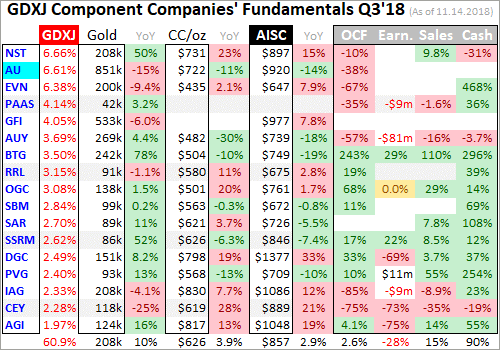
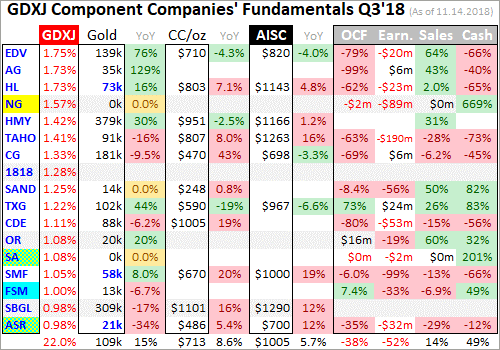
While this new mid-tier GDXJ is generally excellent, some decisions by its managers are utterly baffling. Out of all the world’s gold miners they could’ve added over this past year, they inexplicably decided on the giant largely-African AngloGold Ashanti. It produced an enormous 851k ounces of gold last quarter, the largest in GDXJ by far. It and the rest of the South African majors definitely don’t belong in GDXJ!
Remember that major-gold-miner threshold has long been 1m+ ounces per year. AU’s production is annualizing to well over 3x that, making this company the world’s 3rd-largest gold miner last quarter. Why on earth would managers running a “Junior Gold Miners ETF” even consider AngloGold Ashanti? It is as far from junior-dom as gold miners get. The same is true with the rest of the troubled South African gold miners.
AU, Gold Fields, Harmony Gold, and Sibanye-Stillwater mined 851k, 533k, 379k, and 309k ounces in Q3’18, all are majors. Yet they accounted for 13.1% of GDXJ’s total weighting. They are riddled with all kinds of problems too, from shrinking production to high costs to increasing stealth expropriations from South Africa’s openly-Marxist anti-white-investor government. Their inclusion heavily skews and taints GDXJ.
These South African majors’ Q3 production of 2.1m ounces was a whopping 41% of the GDXJ top 34’s total! And it still fell 7.0% YoY due to South Africa’s tragic death spiral. Excluding them and the amazing Kirkland Lake Gold which has grown so fast it was moved exclusively into GDX over this past year, the rest of the GDXJ top 34 grew production 3.4% YoY in Q3. The South African majors’ cost impact is even worse.
Mining in that country is very expensive thanks to very-old very-deep mines and endless new government interference via stifling regulations. In Q3 the South African majors’ cash and all-in sustaining costs came in really high averaging $925 and $1088 per ounce. The rest of GDXJ’s top 34 averaged $629 and $877, a massive 32.0% and 19.4% lower! The South African majors are really retarding GDXJ’s performance.
As struggling majors far larger than mid-tiers and juniors, they need to get kicked out of GDXJ posthaste. They can be left in GDX where they belong. AU effectively took KL’s place, which makes no sense at all fundamentally. Kirkland Lake produced 180k ounces of gold in Q3 at $351 cash costs and $645 AISCs. So unlike AU, KL remains solidly in the mid-tier realm and has been performing incredibly well operationally.
While GDXJ’s managers really dropped the ball including those South African majors, they deserve big praise for upping the weighting of the outstanding Australian miners. They are Northern Star Resources, Evolution Mining, Regis Resources, St Barbara, and Saracen Mineral. Their collective weighting in GDXJ grew to 21.7% at the end of Q3’s earnings season, nearly 2/3rds higher from their 13.3% a year earlier.
Unlike AU’s dumbfounding inclusion, the Australians’ rise is well-deserved. Their production surged 8.9% YoY to 686k ounces, or 23% of the GDXJ top 34’s total excluding those South African majors. And the Australian miners are masters at developing great gold deposits and controlling costs, as their cash costs and AISCs in Q3 averaged just $586 and $724! It’s fantastic GDXJ offers American investors this Aussie exposure.
GDXJ’s component list and weightings are a work in progress, and are gradually getting better. For years I’ve pointed out things like the South African majors that weren’t right, and GDXJ’s managers eventually seem to come around and change things for the better. Greatly helping that process is investors buying the better individual stocks like KL and shunning laggards like AU, readjusting their relative market capitalizations.
GDXJ and GDX are essentially market-cap weighted, with larger companies rightfully commanding larger weightings. These leading gold-stock ETFs’ managers can override this by deciding which gold miners to include in each ETF. So they can easily purge GDXJ of the deteriorating South African majors and add real mid-tier gold miners. But the true core problem is having so many of the same stocks in GDX and GDXJ.
Such massive overlap between these two ETFs is a huge lost opportunity for VanEck. It owns and manages GDX, GDXJ, and even the MVIS indexing company that decides exactly which gold stocks are included in each. With one company in total control, there’s no need for any overlap in the underlying companies of what should be two very-different gold-stock ETFs. Inclusion ought to be mutually-exclusive.
VanEck could greatly increase the utility of its gold-stock ETFs and thus their ultimate success by starting with one big combined list of the world’s better gold miners. Then it could take the top 20 or 25 in terms of annual gold production and assign them to GDX. Based on Q3’18 production, that would run down near 139k or 93k ounces per quarter. Then the next-largest 40 or 50 gold miners could be assigned to GDXJ.
Getting smaller gold miners back into GDXJ would be a huge boon for the junior-gold-mining industry. Most investors naturally assume this “Junior Gold Miners ETF” owns junior gold miners, which is where they are trying to allocate their capital. But since most of GDXJ’s funds are instead diverted into much-larger mid-tiers and even some majors, the juniors are effectively being starved of capital intended for them.
That’s one of the big reasons smaller gold miners’ stock prices are so darned low. They aren’t getting enough capital inflows from gold-stock-ETF investing. So their share prices aren’t bid higher. They rely on issuing shares to finance their exploration projects and mine builds. But when their stock prices are down in the dumps, that is heavily dilutive. So GDXJ is strangling the very industry its investors want to own!
Back to these mid-tier gold miners’ Q3’18 results, production is the best place to start since that is the lifeblood of the entire gold-mining industry. These top 34 GDXJ gold miners that had specifically reported Q3 production as of mid-November produced 5063k ounces. That surged by a massive 18.8% YoY, implying these miners are thriving. But that is heavily distorted by that huge 851k-ounce boost from AU’s addition.
Without the world’s 3rd-largest gold miner, the rest of the GDXJ top 34 saw their production slip 1.2% YoY to 4212k ounces. That reflected the peak-gold challenges the gold-mining industry is facing, as I discussed a couple weeks ago while reviewing the GDX majors’ Q3’18 results. The GDXJ top 34 are still outperforming the GDX top 34, which saw their gold production retreat 2.9% YoY in Q3 bucking historical trends.
Sequentially quarter-on-quarter from Q2’18 the GDXJ top 34’s production surged a dramatic 13.3%! And AU was already one of GDXJ’s top components then. That partially came from new mines ramping up at the world’s best mid-tier gold miners. It is far easier for them to grow production off lower bases than it is for the majors off high bases. That’s a key reason why the mid-tiers’ upside potential trounces that of the majors.
For all GDXJ’s faults, it does still offer investors exposure to much-smaller gold miners. The average quarterly production of all the top 34 GDXJ miners reporting it in Q3 was 163.3k ounces. That is 43% smaller than the 288.8k averaged by the top 34 GDX miners last quarter. And again AU’s crazy inclusion really skews this. Ex-AU, the GDXJ average falls to 140.4k. Without all the South African majors, it is 110.8k.
These annualize to 562k and 443k, both solidly in the mid-tier realm. Analyzing GDXJ’s production and costs requires breaking out those heavily-distorting South African majors that have no place in a mid-tier gold-miner ETF. Again their production fell 7.0% YoY in Q3, while the rest of the GDXJ top 34’s ex-KL grew 3.4%! Production and costs tend to be proportionally inversely related because of how mining works.
Gold-mining costs are largely fixed quarter after quarter, with actual mining requiring the same levels of infrastructure, equipment, and employees. The tonnage throughputs of the mills that process the gold-bearing ore are also fixed. So gold produced varies with ore grades each quarter. The more gold that is recovered, the more ounces to spread gold mining’s big fixed costs across. That lowers per-ounce costs.
There are two major ways to measure gold-mining costs, classic cash costs per ounce and the superior all-in sustaining costs per ounce. Both are useful metrics. Cash costs are the acid test of gold-miner survivability in lower-gold-price environments, revealing the worst-case gold levels necessary to keep the mines running. All-in sustaining costs show where gold needs to trade to maintain current mining tempos indefinitely.
Cash costs naturally encompass all cash expenses necessary to produce each ounce of gold, including all direct production costs, mine-level administration, smelting, refining, transport, regulatory, royalty, and tax expenses. In Q3’18, the overall cash costs of the GDXJ top 34 surged 8.4% higher YoY to $663 per ounce. That was still largely in line with the past four quarters’ $612, $618, $692, and $631 averaging $638.
But that sharp jump was mostly the result of the South African majors’ deepening troubles. Again their average cash costs last quarter were a whopping $925! Without them, the rest of the GDXJ top 34 averaged $629 per ounce which was only up 2.8% YoY and below the rolling-four-quarter mean. So the mid-tier gold miners of GDXJ are holding the line on cash costs, a sign their operations are fundamentally sound.
Way more important than cash costs are the far-superior all-in sustaining costs. They were introduced by the World Gold Council in June 2013 to give investors a much-better understanding of what it really costs to maintain gold mines as ongoing concerns. AISCs include all direct cash costs, but then add on everything else that is necessary to maintain and replenish operations at current gold-production levels.
These additional expenses include exploration for new gold to mine to replace depleting deposits, mine-development and construction expenses, remediation, and mine reclamation. They also include the corporate-level administration expenses necessary to oversee gold mines. All-in sustaining costs are the most-important gold-mining cost metric by far for investors, revealing gold miners’ true operating profitability.
The GDXJ top 34 reported average AISCs of $911 in Q3, up 3.8% YoY. But like cash costs, this was roughly in line with the $877, $855, $923, and $886 seen in the past four quarters. But again that was skewed quite a bit higher by those wrongly-included South African majors, which reported $1088 average AISCs in Q3. The rest of the top 34 averaged $877, which is actually better than the $885 four-quarter average.
So the South African majors are really tainting GDXJ’s collective operational performance, with lower production and higher costs dragging down this entire ETF. Those giant struggling gold producers are an albatross around the neck of the many great mid-tier gold miners in GDXJ! If you are a GDXJ investor, contact VanEck and urge them to boot the South African majors out of GDXJ to help it thrive going forward.
Gold-mining earnings are simply the difference between prevailing gold prices and all-in sustaining costs. And both sides of this equation moved the wrong way in Q3, squeezing the mid-tier gold miners’ profits. Q3’18’s average gold price of $1211 was 5.3% lower than Q3’17’s. And with overall GDXJ top 34 AISCs 3.8% higher at $911, that really cut into margins. These gold miners were collectively earning $300 per ounce.
That implied solid 25% profit margins absolutely, which aren’t bad. But they still plunged 25.4% YoY from Q3’17’s $402 per ounce, which amplified gold’s decline by 4.8x. But gold-mining profits leverage to gold is exactly why the gold stocks make such compelling investments. Gold stocks were weak in Q3 because gold was pounded to a deep 19.3-month low in mid-August on extreme all-time-record gold-futures short selling.
Left for dead and neglected, the gold miners’ stocks are the last cheap sector in these lofty bubble-valued stock markets. Their fundamental upside as gold mean reverts higher on speculators’ gold-futures buying and new investment demand as stock markets roll over is enormous. This is easy to understand with a simple example. In the last four quarters including Q3’18, the top 34 GDXJ gold miners’ AISCs averaged $894.
During gold’s last major upleg in essentially the first half of 2016, it powered about 30% higher driven by surging investment demand after stock markets suffered back-to-back corrections. That was even small by historical gold-bull-upleg standards. If we merely get another 30% gold advance from its recent mid-August low of $1174, we’re looking at $1525 gold. That would work wonders for gold-mining profits and stock prices.
At $1525 gold and $894 AISCs, the mid-tier gold miners would be earning $631 per ounce. That’s 110% higher than Q3’18’s $300! If gold-mining profits double, gold-stock prices will soar. Indeed during that last 30% gold bull in the first half of 2016, GDXJ rocketed 203% higher! So the gold-stock outlook is wildly bullish with gold itself due to power higher as the stock markets roll over on the Fed’s record tightening.
The rest of the top 34 GDXJ gold miners’ fundamentals were mixed last quarter. Cash flows generated from operations totaled $1.3b in Q3, down 21.2% YoY. That’s reasonable given average gold’s 5.3% YoY retreat and their leverage to it. Cash on hand remained high at $5.4b, down just 5.3% YoY. So these mid-tier gold miners have plenty of capital to build and buy new mines to continue growing their production.
Revenues only slipped 0.4% YoY to $4.1b, which means the softer gold prices were largely offset by higher production. But GAAP profits looked like a disaster, with the GDXJ top 34’s plummeting to a $379m loss in Q3’18 from being $212m in the black in Q3’17! That was far worse than the lower gold prices warranted, but thankfully it was mostly the result of big non-cash charges flushed through income statements.
Tahoe Resources reported a massive $170m impairment charge on its suspended Escobal silver mine that is being held hostage by the corrupt Guatemalan government. Yamana Gold wrote off $89m after selling a mine in Argentina. Explorer NOVAGOLD reported an $81m loss from discontinued operations on the sale of one of its projects. These three unusual items alone wiped out $340m of profits from GDXJ’s ranks.
Without them, the top 34 GDXJ gold miners’ earnings would’ve fallen to -$39m from +$212m. That isn’t great, but it doesn’t reveal any serious issues a rising gold price won’t quickly solve. Interestingly if KL was still included instead of AU, that would’ve added another $56m in Q3’18 profits. The mid-tiers’ overall earnings should dramatically leverage and outpace gold in coming quarters as it inexorably mean reverts higher.
While GDXJ should certainly no longer be advertised as a “Junior Gold Miners ETF”, it offers exposure to some of the best mid-tier gold miners on the planet. It’s really growing on me, I like this new GDXJ way better than GDX. That being said, GDXJ is still burdened by overdiversification and way too many gold miners that shouldn’t be in there. They are either too large, are saddled with inferior fundamentals, or both.
So the best way to play the gold miners’ coming massive mean-reversion bull is in individual stocks with superior fundamentals. Their gains will ultimately trounce the major ETFs like GDXJ and GDX. There’s no doubt carefully-handpicked portfolios of elite gold and silver miners will generate much-greater wealth creation. GDXJ’s component list is a great starting point, but pruning it way down offers far-bigger upside.
The key to riding any gold-stock bull to multiplying your fortune is staying informed, both about broader markets and individual stocks. That’s long been our specialty at Zeal. My decades of experience both intensely studying the markets and actively trading them as a contrarian is priceless and impossible to replicate. I share my vast experience, knowledge, wisdom, and ongoing research through our popular newsletters.
Published weekly and monthly, they explain what’s going on in the markets, why, and how to trade them with specific stocks. They are a great way to stay abreast, easy to read and affordable. Walking the contrarian walk is very profitable. As of Q3, we’ve recommended and realized 1045 newsletter stock trades since 2001. Their average annualized realized gains including all losers is +17.7%! That’s double the long-term stock-market average. Subscribe today and take advantage of our 20%-off holidays sale!
The bottom line is the mid-tier gold miners reported solid fundamentals despite a challenging third quarter for gold prices. Excluding the South African majors, they were able to grow their production nicely while holding the line on costs. That portends dramatic operating-cash-flow and earnings growth in the coming quarters as gold mean reverts higher on big investment buying. The mid-tier gold miners’ stocks will soar on that.
Gold stocks are not only unloved and dirt-cheap today, but they are a rare sector that rallies strongly with gold as general stock markets weaken. While virtually no one was interested in these leveraged plays on gold upside in recent months, that will change fast as these lofty stock markets roll over. And the mid-tier gold miners’ recent Q3 earnings season proved they remain ready to fundamentally amplify gold’s gains.
Adam Hamilton, CPA
Copyright 2000 – 2018 Zeal LLC (www.ZealLLC.com)
December 3, 2018
Recent market and economic developments are positive for Gold and precious metals but conditions are not bullish yet.
Bullish conditions and bullish fundamentals would be highlighted by a shift in Fed policy. They aren’t shifting yet. They are slowing, which precedes a shift.
From a market standpoint, we need to see strength in Gold in real terms (against stocks and foreign currencies) and a steepening of the yield curve. These developments along with shifting Fed policy will tell us a new bull market is soon to begin.
In regards to Gold against equities, the chart below shows both progress but the need for more strength.
Gold remains below its long-term moving average against U.S. stocks (NYSE). The trend has not turned bullish yet.
Gold relative to the rest of the world (U.S. excluded) and Emerging Markets has turned the corner but now must prove it can hold above the long-term moving average.
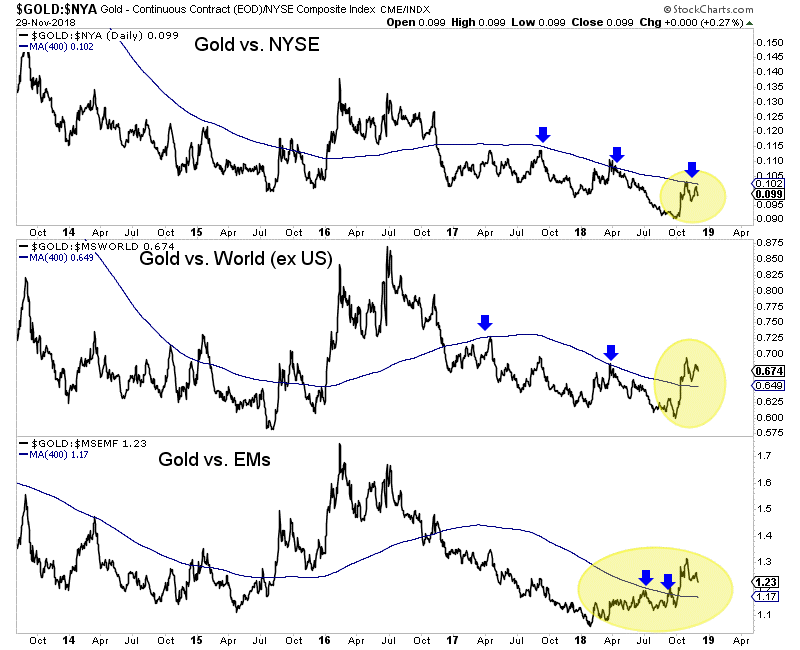
Gold relative to foreign currencies is at an interesting juncture as the chart below shows. Over the past month it has been battling with a confluence of resistance right at its 200 and 400 day moving averages.
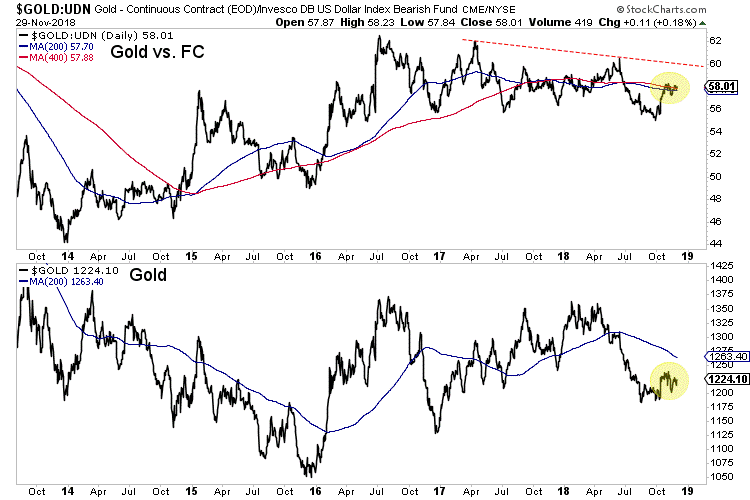
From a market standpoint, the stock market is key as it will front-run Fed policy. It’s a reflection of the economy and health of corporations. A stronger stock market means tighter Fed policy.
That could go out the window if and when the S&P 500 loses its recent lows at the 400-day moving average. But these lows could hold for several months.

The yield curve continues to flatten, which is not bullish for Gold. Steepening is.
Although the Fed said something about rate hikes coming to an end and the market now expects only two more hikes, the conditions are not there for Gold.
On the fundamental side, history argues that conditions turn most bullish after the last hike and when the market begins to discount a new rate cutting cycle. It appears we are still months away from the last hike.
On the technical side, there is improvement in the leading indicators but nothing definite yet.
Gold has not broken out of its downtrend relative to U.S. stocks nor has it broken out against foreign currencies. These things should happen before a bull market begins.
In the meantime, don’t try to catch falling knives or chase weakness as there will be plenty of time to get into cheap juniors that can triple and quadruple once things really get going. Moreover, the start of the next bull looks to be more than a few months away.
Consider our premium service which can help you ride out the remaining downside and profit ahead of a major bottom in the sector. To prepare yourself for an epic buying opportunity in junior gold and silver stocks in 2019, consider learning more about our premium service.
November 30, 2018
GOLD:
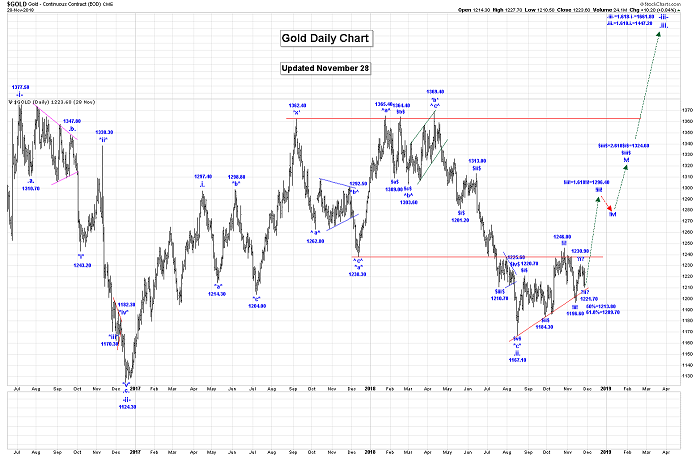
Short Term Update:
What a day! This is incredible! We called it with our wave counts, and now it’s really happening as the Fed may have just blinked!
Within wave .iii. we are now working on our first impulsive sequence, as shown on our “Daily Gold Chart”.
Within that first impulsive sequence we believe that we are working on a subdividing wave $iii$. Within wave $iii$, wave !i! ended at the 1246.00 high and all of wave !ii! at 1196.60.
We are now rallying in wave !iii!, which has an initial target of:
!iii!=1.618!i!=1296.40!
Within wave !iii! it looks like we are subdividing again as shown on the Daily Gold Chart. It looks like wave ?i? ended at 1230.90 and that we are now falling in wave ?ii?.
Our retracement levels for the end of wave ?ii? were:
50% = 1213.80;
61.8% = 1209.70.
Our report card on that call: Bingo!
We expected that gold should drop a little further before all of wave ?ii? ends, and that’s exactly what happened.
Longer term our first projection for the end of wave .iii. is:
.iii. = 1.618.i. = 1447.20.
We do have higher projections. Of course, wave .iii. should subdivide into a 5 wave impulsive sequence in its journey higher.
Trading Recommendation: Long gold. Use puts as stops.
Active Positions: We are long, with puts as stops!
Silver:
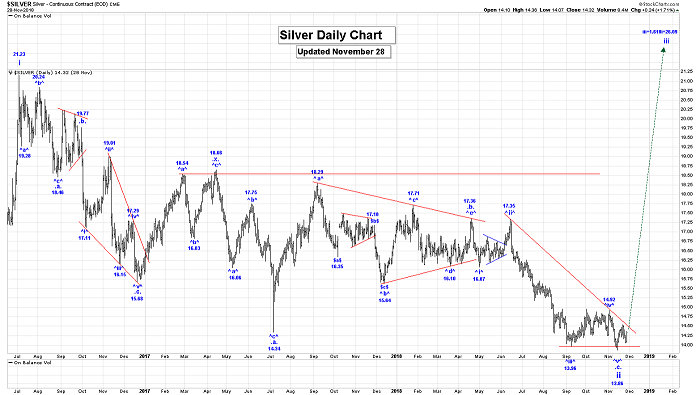
Short Term Update:
In the very short term, silver has been correcting the rally from 13.86 to 14.54. Silver could be ready to move higher again quite soon.
We are working on the assumption that all of wave ii ended at the 13.86 low and that we are now starting to work higher…
In the initial stages of wave .iii.
We have been waiting to see a very big up day to confirm this assumption.
Silver will accelerate higher (and perhaps quite dramatically) with gold once the 95.93 low in the USDX gives way.
We also need to break above our red downtrend line that is shown on the Daily Silver Chart that connects 17.35 and 14.92.
Our first projection for the end of wave iii is:
iii = 1.618i = 26.09.
Trading Recommendation: Long silver. Use a put as a stop.
Active Positions: We are long, with puts as stops!
GDX & Gold Stocks:
GDX 60 Min Chart:
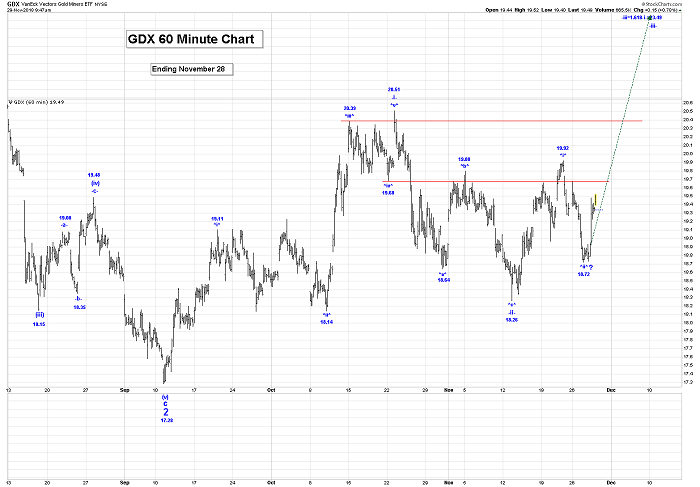
GDX Daily Chart:
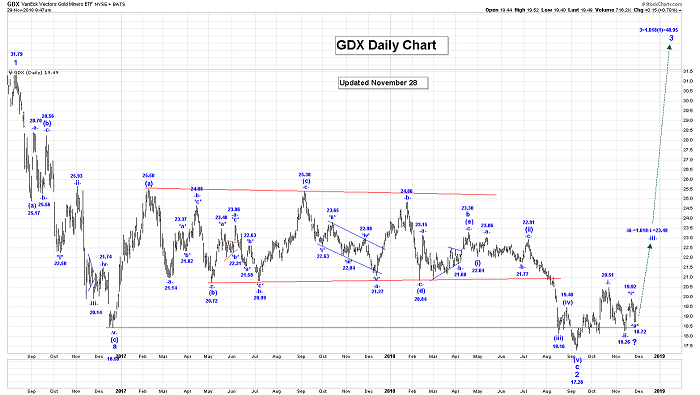
Short Term Update:
We have now updated our count to suggest that all of wave ^i^ ended at the 19.92 high and that all or most of wave ^ii^ at the 18.72 low.
If that is the case then we should now be moving higher in wave ^iii^, as the next big event in this market.
We are now working on the assumption that all of wave -ii- is complete at the 18.26 low and that we are now rallying in wave -iii-.
Our first projection for the end of wave -iii- is:
-iii- = 1.618-i- = 23.49.
Longer term our first projection for the end of wave 3 is:
3 = 1.618(1) = 48.95.
We have updated all of the following counts, for the following:
Kinross: Has now completed its minimum requirements for a completed wave (ii), at the 2.38 low. Wave (iii) rally is now underway.
Barrick: We have completed the minimum requirements for a completed wave (ii) at the 9.53 low. Wave (iii) rally is now underway.
HUI: We have completed the minimum requirements for a completed wave (ii), at the 131.12 low. Wave (iii) rally is now underway.
XAU: We have completed the minimum requirements for a completed wave 2 at the 60.59 low. Wave 3 rally is now underway.
Trading Recommendation: We continue to suggest buying all of the above gold stocks and indices, for a long term hold.
Active Positions: We are long the GDX, ABX, KGC, NEM, SSR, and TSX:XGD with no stops!!
Free Offer For Website Readers: Please send me an Email to admin@captainewave.com and I’ll send you our free “Gold could Hit $1300 By Christmas!” report. We highlight our new weekly wave counts chart for GDX, which suggests that $1300 gold by Christmas can really happen! We discuss tactical approaches to make money on the play!
Thank-you!
Captain Ewave & Crew
Email: admin@captainewave.com
Website: www.captainewave.com
Risk: CAPTAINEWAVE.COM IS AN IMPERSONAL ADVISORY SERVICE. AND THEREFORE, NO CONSIDERATION CAN OR IS MADE TOWARD YOUR FINANCIAL CIRCUMSTANCES. ALL MATERIAL PRESENTED WITHIN CAPTAINEWAVE.COM IS NOT TO BE REGARDED AS INVESTMENT ADVICE, BUT FOR GENERAL INFORMATIONAL PURPOSES ONLY. TRADING STOCKS DOES INVOLVE RISK, SO CAUTION MUST ALWAYS BE UTILIZED. WE CANNOT GUARANTEE PROFITS OR FREEDOM FROM LOSS. YOU ASSUME THE ENTIRE COST AND RISK OF ANY TRADING YOU CHOOSE TO UNDERTAKE. YOU ALSO AGREE TO BEAR COMPLETE RESPONSIBILITY FOR YOUR INVESTMENT RESEARCH AND DECISIONS AND ACKNOWLEDGE THAT CAPTAINEWAVE.COM HAS NOT AND WILL NOT MAKE ANY SPECIFIC RECOMMENDATIONS OR GIVE ADVICE TO YOU OR ANY OF ITS CLIENTS UPON WHICH THEY SHOULD RELY. CAPTAINEWAVE.COM SUGGESTS THAT THE CLIENT/MEMBER TEST ALL INFORMATION AND TRADING METHODOLOGIES PROVIDED AT OUR SITE THROUGH PAPER TRADING OR SOME OTHER FORM OF TESTING. CAPTAINEWAVE.COM, ITS OWNERS, OR ITS REPRESENTATIVES ARE NOT REGISTERED AS SECURITIES BROKER-DEALERS OR INVESTMENT ADVISORS EITHER WITH THE U.S. SECURITIES AND EXCHANGE COMMISSION OR WITH ANY STATE SECURITIES REGULATORY AUTHORITY. WE RECOMMEND CONSULTING WITH A REGISTERED INVESTMENT ADVISOR, BROKER-DEALER, AND/OR FINANCIAL ADVISOR. IF YOU CHOOSE TO INVEST WITH OR WITHOUT SEEKING ADVICE FROM SUCH AN ADVISOR OR ENTITY, THEN ANY CONSEQUENCES RESULTING FROM YOUR INVESTMENTS ARE YOUR SOLE RESPONSIBILITY.
ALL INFORMATION POSTED IS BELIEVED TO COME FROM RELIABLE SOURCES. CAPTAINEWAVE.COM DOES NOT WARRANT THE ACCURACY, CORRECTNESS, OR COMPLETENESS OF INFORMATION AVAILABLE FROM ITS SERVICE AND THEREFORE WILL NOT BE LIABLE FOR ANY LOSS INCURRED. DUE TO THE ELECTRONIC NATURE OF THE INTERNET, THE CAPTAINEWAVE.COM WEBSITE, ITS E-MAIL & DISTRIBUTION SERVICES AND ANY OTHER SUCH “ALERTS” COULD FAIL AT ANY GIVEN TIME. CAPTAINEWAVE.COM WILL NOT BE RESPONSIBLE FOR UNAVAILABILITY OF USE OF ITS WEBSITE, NOR UNDELIVERED E-MAILS, OR “ALERTS” DUE TO INTERNET BANDWIDTH PROBLEMS, EQUIPMENT FAILURE, OR ACTS OF GOD. CAPTAINEWAVE.COM DOES NOT WARRANT THAT THE TRANSMISSION OF E-MAILS, OR ANY “ALERT” WILL BE UNINTERRUPTED OR ERROR-FREE. CAPTAINEWAVE.COM WILL NOT BE LIABLE FOR THE ACTS OR OMISSIONS OF ANY THIRD PARTY WITH REGARDS TO CAPTAINEWAVE.COM DELAY OR NON-DELIVERY OF THE CAPTAINEWAVE.COM NIGHTLY EMAILS OR “ALERTS”. FURTHER, WE DO NOT RECEIVE ANY FORM OF PAYMENT OR OTHER COMPENSATION FOR PUBLISHING INFORMATION, NEWS, RESEARCH OR ANY OTHER MATERIAL CONCERNING ANY SECURITIES ON OUR SITE OR PUBLISH ANY INFORMATION ON OUR SITE THAT IS INTENDED TO AFFECT OR INFLUENCE THE VALUE OF SECURITIES.
THERE IS NO GUARANTEE PAST PERFORMANCE WILL BE INDICATIVE OF FUTURE RESULTS. NO ASSURANCE CAN BE GIVEN THAT THE RECOMMENDATIONS OF CAPTAINEWAVE.COM WILL BE PROFITABLE OR WILL NOT BE SUBJECT TO LOSSES. ALL CLIENTS SHOULD UNDERSTAND THAT THE RESULTS OF A PARTICULAR PERIOD WILL NOT NECESSARILY BE INDICATIVE OF RESULTS IN FUTURE PERIODS. THE RESULTS LISTED AT THIS WEBSITE ARE BASED ON HYPOTHETICAL TRADES. PLAINLY SPEAKING, THESE TRADES WERE NOT ACTUALLY EXECUTED. HYPOTHETICAL OR SIMULATED PERFORMANCE RESULTS HAVE CERTAIN INHERENT LIMITATIONS. UNLIKE AN ACTUAL PERFORMANCE RECORD, SIMULATED TRADES DO NOT REPRESENT ACTUAL TRADING. ALSO, SINCE THE TRADES HAVE NOT ACTUALLY BEEN EXECUTED, THE RESULTS MAY HAVE OVER OR UNDER COMPENSATED FOR THE IMPACT, IF ANY, OF CERTAIN MARKET FACTORS SUCH AS LACK OF LIQUIDITY. YOU MAY HAVE DONE BETTER OR WORSE THAN THE RESULTS PORTRAYED. NO REPRESENTATION IS BEING MADE THAT ANY ACCOUNT WILL OR IS LIKELY TO ACHIEVE PROFITS OR LOSSES SIMILAR TO THOSE SHOWN. NO INDEPENDENT PARTY HAS AUDITED THE HYPOTHETICAL PERFORMANCE CONTAINED AT THIS WEBSITE, NOR HAS ANY INDEPENDENT PARTY UNDERTAKEN TO CONFIRM THAT THEY REFLECT THE TRADING METHOD UNDER THE ASSUMPTIONS OR CONDITIONS SPECIFIED HEREAFTER. WHILE THE RESULTS PRESENTED AT THIS WEBSITE ARE BASED UPON CERTAIN ASSUMPTIONS BELIEVED TO REFLECT ACTUAL TRADING CONDITIONS, THESE ASSUMPTIONS MAY NOT INCLUDE ALL VARIABLES THAT WILL AFFECT, OR HAVE IN THE PAST AFFECTED, THE EXECUTION OF TRADES INDICATED BY CAPTAINEWAVE.COM. THE HYPOTHETICAL RESULTS ON THIS WEBSITE ARE BASED ON THE ASSUMPTION THAT THE CLIENT BUY AND SELLS THE POSITIONS AT THE OPEN PRICE OF THE STOCK. THE SIMULATION ASSUMES PURCHASE AND SALE PRICES BELIEVED TO BE ATTAINABLE. IN ACTUAL TRADING, PRICES RECEIVED MAY OR MAY NOT BE THE SAME AS THE ASSUMED ORDER PRICES.
The following interview of Brett Heath, CEO of Metalla Royalty & Streaming, took place by phone & email over the past 10 days. Brett and his expert team have achieved quite a lot over the past year. In this interview I asked Brett for an update as I am especially interested in Metalla’s latest transaction, (a 2% NSR) on the Santa Gertrudis Royalty.
Please describe the importance of your most recent acquisition, the Santa Gertrudis Royalty (a 2% NSR).
The Santa Gertrudis royalty has the potential to be a Company maker for Metalla. The expansive 42,000-hectare property in Sonora Mexico hosts Carlin-type deposits, similar in nature to what has created some of the largest hydrothermal gold deposits in the world. This, combined with a world-class major gold producer in Agnico Eagle as the operator, that has invested upwards of $100 million into the asset shows the confidence and potential of further upside surprises like the new high-grade discovery of the Centauro Zone. With an overall strike length of 18 km on the Santa Gertrudis property that has already been identified, Metalla is positioned to benefit from additional exploration success from the balance of Agnico’s 2018 drilling campaign and beyond.
Can we get an update on your 2 or 3 most important assets?
The Endeavor mine, operated by CBH Resources where we have a silver stream that contributes the most significant portion of Metalla’s cash flow continues to show signs of further exploration success of the Deep Zinc Lode discovery that was made earlier this year. We hope to have an update in 2019 that outlines a mine plan extension past December 2020.
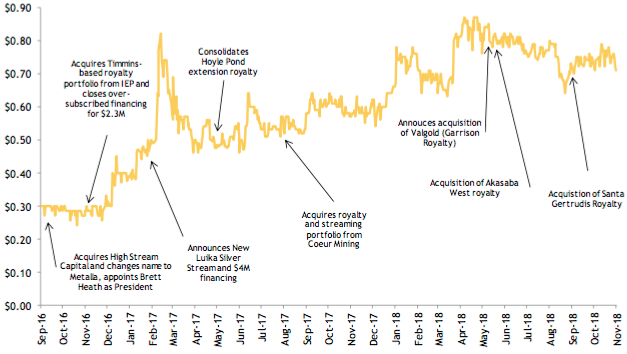
Also, we are expecting a resource update in January 2019 from Osisko Mining on the Garrison gold property where Metalla has a 2% NSR royalty. Osisko has drilled an additional 90,000 m since the latest PEA (the PEA has just under 2 million ounces of gold resources). We are expecting a significant improvement in total ounces, but also an improvement in the categories of Measured & Indicated.
Finally, the Joaquin project which is being developed by Pan American Silver, where Metalla owns a 2% NSR continues to show progress. Pan American has stated that they now expect production in Q1 of 2020.
The Santa Gertrudis deal puts your market cap above C$80 M. At what stage might a mid-tier precious metals Royalty & Streaming company like Sandstorm Gold (~C$1 billion market cap), or Maverix Metals (~C$515 M market cap) show interest in acquiring Metalla?
The bigger royalty companies historically look to take over smaller royalty companies when gold & silver enter into a bull market. This is because mining company equity often becomes over-valued, making it is less costly to acquire a company like Metalla outright rather than take on a royalty or stream. Bigger royalty companies that trade at much higher valuations can provide big premiums to smaller royalty companies while still being accretive.
One of the biggest problems the big royalty companies have in a bull market in precious metals is growth. That’s because providing project capital to mining companies usually gives them a 2-3 year window for those projects to come online. They are forced to look at buying companies like Metalla or price royalties or streams at a much higher cost. Historically that hasn’t worked out so well.
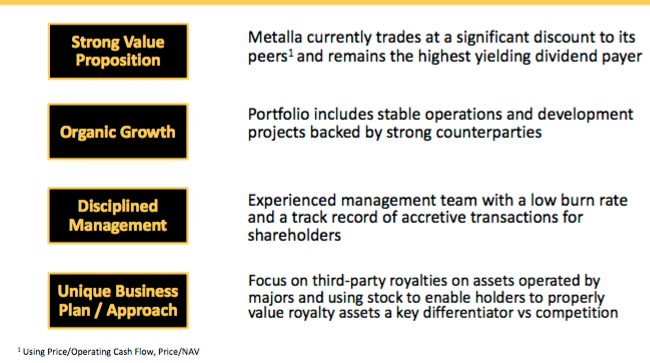
A crucial part of our portfolio is royalties on development projects with major mining companies. We think these assets will command a large premium in the future, potentially even more than our royalties that are already producing.
Silver & Gold prices (in USD) have been weak this year, down 16% & 6%, respectively, how much is that likely to impact your FY 2019 earnings (for the year ending May 2019)?
We take metal price risk along with the mining companies, specifically on silver where 100% of our cash flow comes from currently. What is important to remember is that royalty & streaming contracts offer guaranteed margins. So where a mining company may be break even or losing money at a slightly lower gold or silver price, Metalla will always have cash flow as long as the asset is in production. More importantly, when precious metals prices rise, there is a tremendous amount of leverage built in that translates directly to the shareholders of Metalla.
On the other hand, lower precious metals prices might enable Metalla to strike better deal terms, do you see more attractive transaction opportunities?
We are looking to lock up as much gold and silver in royalty & streaming contracts as we can at current prices. These are the times when incredible deals can be struck, and, as an investor of Metalla, we pay you to wait through our monthly dividend program.
What can you tell readers about new deals that you’re actively working on, deals that could be announced within the next 6 months?
I can tell readers that the hardest part of building a royalty company is getting to a place of critical mass. I believe we have achieved this in the first two years at Metalla and I think it will be easier to scale this company from C$80M to C$500M than it was to go from C$0 – C$80M. Now is the time to position for the next cycle before the institutions take notice of what we have built.
Your current annualized distribution yield is 2.25% (based on C$0.80 stock price), the highest of any precious metals-focused Royalty/Streamer I know of. As the company grows, what are the implications for monthly distributions over the next 6-12 months?
We hope to bring on some royalties that are currently producing over the next 6 months. If we do, the development pipeline could allow us to enhance our dividend program. We have stated a 50% dividend payout goal, but we are prudently working our way towards that goal.
In terms of company valuation, how does Metalla compare to peers? What metrics do you use in your comparisons?
We still trade at a steep discount to peers based on a Net Asset Value (NAV) perspective. As we grow Metalla to C$100M+ in market cap, we expect investment banks to pick up research coverage of us showing the deep value Metalla has to offer. This could be a big potential catalyst for shareholders over the coming year.
Why should readers consider buying shares of Metalla Royalty & Streaming Ltd. instead of other precious metals companies?
We have a strategy, focusing on the pre-existing royalty market that has allowed up to excel in what is a very competitive industry. As a first mover, this should continue to translate into outperformance among our peers.
Thank you again Brett for your time and thoughtful responses to my questions.
Disclosures: The content of this interview is for illustrative and information purposes only. Readers fully understand and agree that nothing contained herein, written by Peter Epstein of Epstein Research, [ER] including but not limited to, commentary, opinions, views, assumptions, reported facts, estimates, calculations, etc. is to be considered implicit or explicit, investment advice. Further, nothing contained herein is a recommendation or solicitation to buy or sell any security. Mr. Epstein and [ER] are not responsible for investment actions taken by the reader. Mr. Epstein and [ER] have never been, and are not currently, a registered or licensed financial advisor or broker/dealer, investment advisor, stockbroker, trader, money manager, compliance or legal officer, and they do not perform market making activities. Mr. Epstein and [ER] are not directly employed by any company, group, organization, party or person. Shares of Metalla Royalty & Streaming are speculative, not suitable for all investors. Readers understand and agree that investments in small cap stocks can result in a 100% loss of invested funds. It is assumed and agreed upon by readers that they consult with their own licensed or registered financial advisors before making investment decisions.
At the time this article was posted, Peter Epstein owned shares in Metalla Royalty & Streaming, and the Company was an advertiser on [ER]. By virtue of ownership of the Company’s shares and it being an advertiser on [ER], Peter Epstein is biased in his views on the Company. Readers understand and agree that they must conduct their own research, above and beyond reading this article. While the author believes he’s diligent in screening out companies that are unattractive investment opportunities, he cannot guarantee that his efforts will (or have been) successful. Mr. Epstein & [ER] are not responsible for any perceived, or actual, errors including, but not limited to, commentary, opinions, views, assumptions, reported facts & financial calculations, or for the completeness of this article. Mr. Epstein & [ER] are not expected or required to subsequently follow or cover events & news, or write about any particular company or topic. Mr. Epstein and [ER] are not experts in any company, industry sector or investment topic.
November 27, 2018
- The next Fed meet (and rate hike) is December 19, and just weeks after that, U.S. president Donald “The Golden Trumpster” Trump may be set to unleash a new round of inflationary and growth-crushing tariffs.
- It’s not easy (to put it mildly) for American business to create new factories to replace the products made by highly productive Chinese factories.
- So, for 2019, most top U.S. bank economists and money managers are slashing their U.S. GDP growth forecasts and raising their inflation forecasts.
- Morgan Stanley’s global stock market weightings are legendary in the institutional world, and they just moved America to a horrifying “underweight” ranking for their global stock market positioning.
- Most big-name economists in America see U.S. GDP growth sliding to sub 2% by mid 2019 while inflation stages an “upside surprise”.
- Please click here now. Goldman’s top economists clearly have the same view I do.
- What’s particularly interesting about this forecast is that their top economist is also forecasting four rate hikes from the Fed in 2019.
- Four hikes would put enormous pressure on the U.S. government’s ability to finance its outrageous debt. It can be argued that these hikes are the Fed’s response to the insane growth of that debt.
- Whether there are two rate hikes as Morgan Stanley predicts, three as I predict, or four as Goldman predicts, the growth of U.S. government debt is clearly going to put vastly more pressure on the US government bond market (and the corporate bond market) in 2019 than it already has in 2018.
- In the matter of “tax loss” season, I realize that many gold market investors are nervous that gold stocks will decline into December like they have in recent years.
- Please click here now. Double-click to enlarge. I don’t see anything to be concerned about on this daily gold chart.
- Please click here now. Double-click to enlarge. I don’t see anything on this GDX chart to be concerned about either.
- GDX and most senior gold stocks are tracking the gold price quite nicely. Gold supply is limited, and top analysts at Goldman and other firms are predicting “Commodities will soar.”
- Also, 2019 is an election year in India. Morgan Stanley just raised India to “overweight” in its global stock market weightings, as it moved America to that somewhat pathetic underweight ranking. While GDP growth nosedives to potentially under 2% in America, it should be at least 7% in India for 2019, and I’m predicting it could hit 8%. GDP growth and upside action in the Indian stock market is good news for gold. The bottom line:
- Gold demand in India is rock solid, as it is in China. As commodities begin to rise, Goldman will lead institutional investors into more commodities investing. Gold, GDX, GDXJ, SIL, and related stocks should have a great year.
- Please click here now. Double-click to enlarge this CDNX venture index chart.
- Whether it’s MACD, moving averages, RSI, or a host of other technical indicators, gold and GDX look solid. Unfortunately, that’s not the case with CDNX.
- Please click here now. That’s a look at the key buy (green) and sell (gold) signals for the high risk venture sector that I cover in my gracelandjuniors.com newsletter.
- The CDNX and related stocks are susceptible to tax loss selling. Penny stocks are high risk (but also high potential reward) and I don’t expect to get a major buy signal for the CDNX index until gold trades at $1420 on a weekly closing basis.
- Please click here now. Double-click to enlarge what just may be the world’s most spectacular price chart!
- Barrick is chaired by former Goldman president John Thornton. Thornton has aggressively bought stock in the open market and has categorically stated that he is not selling a single one of his shares for short term gain.
- Clearly, Thornton is not playing for peanuts. With the majestic bull wedge and inverse head and shoulders bottom in play, it’s obvious that this man is poised to see himself and all Barrick shareholders gain enormous wealth in what I call the “bull era”.
- Thornton was the driving force of the Barrick-Rangold merger. That merger was approved by a stunning 95% of shareholders of both companies. The Chinese government has awarded him the government’s highest award for a non-Chinese person. Of foreigners who have contributed significantly to Chinese growth, the Chinese government views John Thornton as one of the fifteen most important people in the world.
- Barrick shareholders are not just in good hands. They are in spectacular hands! A breakout from the bull wedge with a Friday close over $14 is a rocket launch signal for the entire gold mining sector. Rather than wasting time worrying about a tax loss season that is going the way of the dodo bird, I suggest that gold stock investors should be positioning themselves, as Goldman clearly is, for the rocket ride of a lifetime, in a fabulous gold bull era!
https://gracelandupdates.com/subscribe-pp/
Stewart Thomson is a retired Merrill Lynch broker. Stewart writes the Graceland Updates daily between 4am-7am. They are sent out around 8am-9am. The newsletter is attractively priced and the format is a unique numbered point form. Giving clarity of each point and saving valuable reading time.
Risks, Disclaimers, Legal
Stewart Thomson is no longer an investment advisor. The information provided by Stewart and Graceland Updates is for general information purposes only. Before taking any action on any investment, it is imperative that you consult with multiple properly licensed, experienced and qualified investment advisors and get numerous opinions before taking any action. Your minimum risk on any investment in the world is: 100% loss of all your money. You may be taking or preparing to take leveraged positions in investments and not know it, exposing yourself to unlimited risks. This is highly concerning if you are an investor in any derivatives products. There is an approx $700 trillion OTC Derivatives Iceberg with a tiny portion written off officially. The bottom line: Are You Prepared?
By Daniel Cook
Part 2: It’s Only Natural…
Every mining company has the same problem, they’ve got to replenish their inventory every year. That means if they’re mining 100,000 ounces of gold annually they need to discover at least 100,000 ounces every year to stay afloat. Analysts and investors demand it and watch these inventory levels closely.
- Did you know SSR Mining’s most profitable operation could run out of gold reserves in 7 years or less?
- Did you know they just spent $337 million buying that mine (Seabee) in 2016?
- Did you know Seabee now accounts for approximately 39% of SSR Mining’s total cash flow and arguably one third of their $1.7 billion market cap?
Imagine if SSR Mining (SSRM, TSX) wasn’t able to find more gold before their reserves run out at Seabee, not enough to sustain production of +100,000 ounces per year anyway, and the negative impact it could have on the Company’s long-term growth plans (SSRM would take a negative hit too).
It’s a legitimate concern, but as a shareholder of SSR Mining you shouldn’t have to worry about that scenario because of the option agreement they signed recently with a little known microcap explorer called Taiga Gold (TGC, CSE).
*Editor’s Note: Taiga is the latest of what’s becoming a tradition of successful spinoffs from Eagle Plains (EPL, TSX-V)

Taiga Gold Staff visiting the Seabee Gold Operation
Here’s the deal…
Taiga Gold has granted SSR Mining an opportunity to earn up to an 80% interest in the 34,000 hectare Fisher property by completing $4 million exploration expenditures and making $3.3 million in cash payments to Taiga Gold.
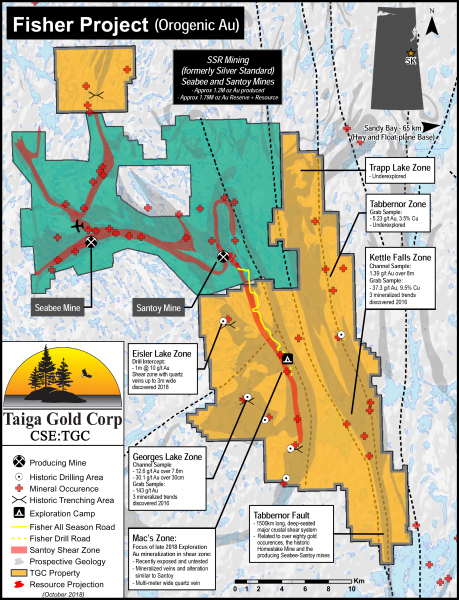
Looking at the map you can see this isn’t what some might call “closeology” in a derogatory way.
Taiga’s Fisher property is close to Seabee in a complimentary way!
In fact, the majority of what SSR Mining has mapped as the “Santoy shear zone” extends onto Fisher.
Think about that…
According to SSR Mining’s own maps the majority, call it 66%, of the Santoy shear zone extends onto Fisher!
That’s pretty major.
The two properties might as well be one.
This is the same belt of rocks, all underexplored and highly prospective geology for hosting gold deposits. More than 80 gold occurrences including the Homestake Mine and SSR Mining’s Seabee-Santoy mines are situated along the Tabbernor fault, a deep-seated crustal shear system that underlies Fisher for a strike length of 40 kilometres.
Fisher increases SSR Mining’s overall land package in the region by 150%!
Can you see how the Fisher property is majorly important for SSR Mining’s future in Saskatchewan?
Knowing Seabee is SSR Mining’s most profitable mine and it only has roughly 7 years of reserves, maybe less, making new discoveries and adding ounces is crucial.
Early stage exploration work to date includes 1,600 soil samples, 600 rock samples, and 5,200 line km of geophysical data. Highlights being 25 rock samples grading +1 g/t Au and grab sample grading nearly 2 ounces Gold.

SSR Mining had a field crew of 8 people and 2 drill rigs working on the ground all summer. As of the most recent update 8,550 metres (14 holes) have been completed of a 15,000 metre drill program on Fisher in 2018. Results will be formally announced as they are received, compiled, and interpreted.
Who knows, we don’t have a crystal ball, but could you imagine a $1.7 billion company like SSR Mining being content with 80% ownership?
Assuming they meet their JV obligation by spending $4 million on exploration and give $3.3 million cash to Taiga I could see SSR Mining buying Taiga outright. That’s just my gut talking, but it’s certainly within the realm of possibilities.
Also within the realm of possibilities is that SSR Mining plays to win right away by acquiring Taiga before making a $3 million cash payment. As per the terms of the JV SSR Mining first spends $4 million on exploration to earn 60%, from there they have a one year, one-time option, to earn an additional 20% (for a total of 80%) by making the $3 million cash payment to Taiga.
Either way, both roads lead toward a takeover of Taiga.
If the Fisher property secures their future at Seabee why wouldn’t they make an offer?
SSR Mining is sitting on $493 million worth of cash.
Taiga Gold, at 9 cents per share, has a market cap of $5.4 million.
It’s only natural.
Geologically speaking the Seabee and Fisher properties are essentially one, so they belong together.
About the author: Starting out, Daniel Cook was a stockbroker during his college years. At the age of 23 he founded his own Registered Investment Advisory (RIA) firm. Daniel is a full-time investor and prospector of the markets, constantly digging for exceptional opportunities. Helping those companies get discovered and gain traction in the marketplace is Mr. Cook’s main objective.
It is very difficult to pick exact bottoms but there are many tools we can use to help us pinpoint potential bottoms.
You don’t hear technical analysts talk about fundamentals but we do for a reason. Major shifts in the primary trend are supported by fundamental shifts, though they can be very hard to spot until after the fact.
Because of our extensive study of history, we are convinced that precious metals will not begin a real bull market until the Fed stops hiking rates. The data shows that many times (though not every time) the gold stocks bottomed soon after the Fed’s final rate hike.
Yes, we’ve beaten this to death but the point is fundamentals matter.
Moving on, we are going to introduce you to a number of tools and indicators which you can use to spot potential bottoms and turning points on a shorter term basis.
The first and foremost focus should be the price action and the various support and resistance lines that are nearby.
In the chart below, we highlight the support and resistance areas.
For example, GDX last week bounced from support at $18. It faces strong resistance above $20. A loss of $18 would likely lead to a test of support in the $16s. GDXJ meanwhile, bounced from its September low at $26. It faces strong resistance near $30 and if it loses the recent low could test support in the $22-$24 range.
1
After considering the price action and important support and resistance levels, we turn to the breadth indicators which provide us information in regards to participation and sector divergences.
We plot GDX below along with its advance decline (A/D) line, the bullish percentage index (BPI) and new highs minus new lows.

The A/D line, which is one of the most trusted leading indicators is flashing a negative divergence. It looks similar to the one in early 2015. Note that it flashed a major positive divergence in early 2016. Smaller positive divergences were seen in March 2018 and September 2018.
The BPI currently is not telling us much. It needs to fall to 10% for the sector to be considered very oversold.
Days ago the new highs minus new lows indicator hit nearly -40%, which is fairly oversold. In my opinion over -50% or even -70% tends to signal a sustained low as it did in late 2014, summer 2015 and late summer 2018.
Another breadth indicator (and one we custom made for GDXJ) is the percentage of stocks that closed above various moving averages. Below we plot GDXJ along with the percentage of a basket of 55 junior stocks (mostly in GDXJ) that closed above the 20-day moving average, 50-day moving average and 200-day moving average.

This data showed a strong positive divergence in early 2016 as well in late 2017 and to a lesser degree in late 2016. Last week it showed an oversold condition in GDXJ but no positive divergences.
In addition to breadth indicators, we can also study how the stocks are performing versus the metals and we can track various momentum oscillators.
My two favorite oscillators to study are the rate of change indicator and the distance from the moving average indicator. We plot these in the GDXJ chart below on a 20-day and 50-day basis.

Note that the most oversold points usually occur on the first leg down or the first break of support. Subsequent tests of the same support will show a less oversold condition. That’s good if that low can hold. If not, it’s worse as the market will break to new lows in a less oversold state.
So what can we conclude from the current price action and these various indicators?
The gold stocks hit an oversold condition last week as evidenced by the very weak breadth in GDXJ and the new highs minus new lows indicator for GDX touching nearly -40%. They also hit some technical support.
However, there are no positive divergences in any of the breadth indicators and the GDX (A/D) line is flashing a serious negative divergence.
Unless December is the final rate hike for the Fed, there is little reason to expect much from the current rally. While risk may not be imminent, a break below recent lows could lead to an accelerated selloff. Consider our premium service which can help you ride out the remaining downside and profit ahead of a major bottom in the sector. To prepare yourself for an epic buying opportunity in junior gold and silver stocks in 2019, consider learning more about our premium service.
Graceland Updates 4am-7am
https://www.gracelandupdates.com
https://gracelandjuniors.com
https://gudividends.com
|https://guswinger.com
https://gublockchain.com
Email:
stewart@gracelandupdates.com
stewart@gracelandjuniors.com
stewart@gudividends.com
stewart@guswinger.com
admin@gublockchain.com
November 20, 2018
- After breaking upside from a double bottom pattern, gold continues its solid price action. More good times lie directly ahead for precious metals investors, because Chinese New Year buy season begins very soon.
- Please click here now. Double-click to enlarge. Note the solid position of my key 14,7,7 Stochastics indicator on this daily gold chart.
- The U.S. stock market’s “traditional end of the year rally” is turning into a veritable turkey shoot for the bears. Gold seems immune to the action, suggesting that unseen inflationary pressures may be larger than most investors realize.
- Please click here now. Double-click to enlarge. Investors need to understand that as the business cycle matures, volatility in the stock market rises.
- Any decline could be the start of a bear market. A “buy the dip” approach to the market becomes a death trap as corporate earnings peak, rates rise, GDP peaks, and inflation gains attention.
- The bottom line: U.S. stock market bears crack the whip, and late cycle price chasers take a horrific trip!
- Please click here now. Morgan Stanley’s top currency analysts believe the dollar has peaked against most of the currencies it recently rallied against. Hedge fund “superman” Ray Dalio is talking about a 30% dollar devaluation. He proposes monetizing the U.S. government’s huge debt as a “final solution.”
- I’ve suggested a “Plaza Accord 2.0” is going to happen. I believe U.S. President Trump will lead preliminary discussions about it from behind closed doors at the upcoming G20 meeting.
- Please click here now. As empires peak and then die, the peak usually comes with the nation enveloped in a state of “war worship.”
- Massive amounts of money are borrowed by the government to fund the madness, but even that isn’t so enough, so more is extorted via “taxes” from struggling citizens.
- In the case of America, more than 25% of the government’s gargantuan debt is easily attributable to war worship.
- The final nail the U.S. government’s debt coffin likely came when instead of cutting the capital gains tax to zero and beginning a Treasury monthly gold buy program, the government decided to impose tariff taxes to “boost growth and make trade fair.”
- Import tariffs are the best form of taxation, but only when used instead of income and capital gains taxation. In this case, tariffs are layered on top of income and capital gains taxes. The bottom line: Instead of becoming a super-sized version of Switzerland, America risks becoming a stagflationary wasteland.
- Ray Dalio speaks of “other currencies” rising to prominence as the dollar fades. He says he doesn’t want to be specific about it though. Is that because gold is one of those currencies?
- The U.S. stock market has begun collapsing, inflation is on the move, and junior miners should be looking good. Are they?
- For the answer to that question, please click here now. Double-click to enlarge. Most of the world’s smallest resource companies are in the Canadian CDNX index.
- It’s the best indication of the overall health of the global junior mining and junior energy sectors. I highlight key buy and sell action points on my www.gracelandjuniors.com website for many of the CDNX component stocks. This is a look at the signals for the index itself.
- There’s no significant buy signal yet, but in early 2019 as inflation likely moves higher and U.S. GDP declines, a “America, it’s time to usher in the new year with a new and not so exciting era of substantial stagflation!” welcome mat will be rolled out.
- I expect to get a major buy signal for the entire junior mining sector as that happens.
- Please click here now. Double-click to enlarge. I’m impressed with the price action of GDX on this daily chart.
- Note how quickly GDX has surged back above the neckline of that pesky H&S top pattern after breaking down. That’s positive action and now there’s a bull wedge in play too!
- Please click here now. Double-click to enlarge this long term GDX “Trigger Time” chart.
- Investors also need to watch the price of Barrick (ABX-NYSE) closely. If it can close above $14.00 on Friday of this week, that will be a major buy signal, and Barrick is my most important lead indicator for GDX and the entire senior gold stocks sector.
- All gold stock investor eyes need to be laser-focused on the $22.50 zone for GDX, because if GDX can stage two consecutive Friday closes above that price, I will have a massive buy signal in play!
Stewart Thomson is a retired Merrill Lynch broker. Stewart writes the Graceland Updates daily between 4am-7am. They are sent out around 8am-9am. The newsletter is attractively priced and the format is a unique numbered point form. Giving clarity of each point and saving valuable reading time.
Risks, Disclaimers, Legal
Stewart Thomson is no longer an investment advisor. The information provided by Stewart and Graceland Updates is for general information purposes only. Before taking any action on any investment, it is imperative that you consult with multiple properly licensed, experienced and qualified investment advisors and get numerous opinions before taking any action. Your minimum risk on any investment in the world is: 100% loss of all your money. You may be taking or preparing to take leveraged positions in investments and not know it, exposing yourself to unlimited risks. This is highly concerning if you are an investor in any derivatives products. There is an approx $700 trillion OTC Derivatives Iceberg with a tiny portion written off officially. The bottom line: Are You Prepared?
The major gold miners’ stocks remain mired in universal bearishness, largely left for dead. They are just wrapping up their third-quarter earnings season, which proved challenging. Lower gold prices cut deeply into cash flows and profits, and production-growth struggles persisted. But these elite companies did hold the line on costs, portending soaring earnings as gold recovers. Their absurdly-cheap stock prices aren’t justified. Four times a year publicly-traded companies release treasure troves of valuable information in the form of quarterly reports. Companies trading in the States are required to file 10-Qs with the U.S. Securities and Exchange Commission by 40 calendar days after quarter-ends. Canadian companies have similar requirements at 45 days. In other countries with half-year reporting, many companies still partially report quarterly.
These quarterlies offer the best fundamental data available for individual major gold miners, showing how their operations are really faring. That helps dispel the thick obscuring fogs of sentiment that billow up the rest of the time. While I always eagerly anticipate perusing these key reports, I worried what this Q3’18 earnings season would reveal. Lower gold prices, flagging production, and weak sentiment are a witches’ brew.
The definitive list of major gold-mining stocks to analyze comes from the world’s most-popular gold-stock investment vehicle, the GDX VanEck Vectors Gold Miners ETF. Its composition and performance are similar to the benchmark HUI gold-stock index. GDX utterly dominates this sector, with no meaningful competition. This week GDX’s net assets are 50.5x larger than the next-biggest 1x-long major-gold-miners ETF!
GDX is effectively the gold-mining industry’s blue-chip index, including the biggest and best publicly-traded gold miners from around the globe. GDX inclusion is not only prestigious, but grants gold miners better access to the vast pools of stock-market capital. As ETF investing continues to rise, capital inflows into leading sector ETFs require their managers to buy more shares in underlying component companies.
My earnings-season trepidation soared on October 25th. The gold stocks were doing fairly well then, with GDX rallying 14.4% out of mid-September’s deep forced-capitulation lows . Sentiment was slowly improving. But that day GDX plunged 4.4% out of the blue, and the flat gold price at upleg highs certainly wasn’t the driver. The most-loved major gold miner had plummeted after reporting shockingly-bad Q3 results. Goldcorp has always been one of GDX’s top components. It reported mining just 503k ounces of gold last quarter, which plunged 11.9% sequentially quarter-on-quarter and 20.5% year-over-year! That forced its all-in sustaining costs a proportional 20.8% higher YoY to $999 per ounce. Investors panicked and fled, hammering GG stock 18.7% lower. That was the worst down day in the 24.6-year history of this company.
That left it at an extreme 16.2-year low! GG hadn’t been lower since August 2002 when gold was still in the low $300s, it was apocalyptic. That really torpedoed still-fragile sentiment in this sector, even though GG’s woes looked short-lived. It was bringing a new expansion online at one of its big mines, which was what caused the shortfall. Now in Q4’18 Goldcorp expects production to rebound to 620k ounces at $750 AISCs.
After GG’s Q3 disaster, I worried frayed investors would dump other gold stocks on any hints of less-than-optimal quarterly results. But GDX has ground sideways on balance since that GG shock, weathering this risky earnings season with sentiment so fragile. Ever since I’ve been anxious to analyze the collective Q3 results of the major gold miners as a whole, to see if GG’s travails were unique to it or more systemic.
GDX’s component list this week ran 48 “Gold Miners” long. While the great majority of GDX stocks do fit that bill, it also contains gold-royalty companies and major silver miners. All the world’s big primary gold miners publicly traded in major markets are included. Every quarter I look into the latest operating and financial results of the top 34 GDX companies, which is just an arbitrary number fitting neatly into these tables.
That’s a commanding sample, as GDX’s 34 largest components now account for a whopping 93.5% of its total weighting! These elite miners that reported Q3’18 results produced 296.4 metric tons of gold, which accounts for fully 33.9% of last quarter’s total global gold production. That ran 875.3t per the recently-released Q3’18 Gold Demand Trends report from the World Gold Council. I’ll discuss production more below.
Most of these top 34 GDX gold miners trade in the U.S. and Canada where comprehensive quarterly reporting is required by regulators. But some trade in Australia and the U.K., where companies just need to report in half-year increments. Fortunately those gold miners do still tend to issue production reports without financial statements each quarter. There are still wide variations in reporting styles and data offered.
Every quarter I wade through a ton of data from these major gold miners’ latest results and dump it into a big spreadsheet for analysis. The highlights make it into these tables. Blank fields mean a company had not reported that data for Q3’18 as of this Wednesday. Looking at the major gold miners’ latest results in aggregate offers valuable insights on this industry’s current fundamental health unrivaled anywhere else.
The first couple columns of these tables show each GDX component’s symbol and weighting within this ETF as of this week. While most of these stocks trade on US exchanges, some symbols are listings from companies’ primary foreign stock exchanges. That’s followed by each gold miner’s Q3’18 production in ounces, which is mostly in pure-gold terms. That excludes byproduct metals often present in gold ore. Those are usually silver and base metals like copper, which are valuable. They are sold to offset some of the considerable costs of gold mining, lowering per- ounce costs and thus raising overall profitability. In cases where companies didn’t separate out gold and lumped all production into gold-equivalent ounces, those GEOs are included instead. Then production’s absolute year-over-year change from Q3’17 is shown.
Next comes gold miners’ most-important fundamental data for investors, cash costs and all-in sustaining costs per ounce mined. The latter directly drives profitability which ultimately determines stock prices. These key costs are also followed by YoY changes. Last but not least the annual changes are shown in operating cash flows generated, hard GAAP earnings, revenues, and cash on hand with a couple exceptions. Percentage changes aren’t relevant or meaningful if data shifted from positive to negative or vice versa, or if derived from two negative numbers. So in those cases I included raw underlying data rather than weird or misleading percentage changes. This whole dataset together offers a fantastic high-level read on how the major gold miners are faring fundamentally as an industry. Was Goldcorp’s disaster systemic?
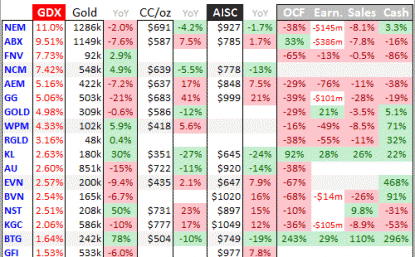
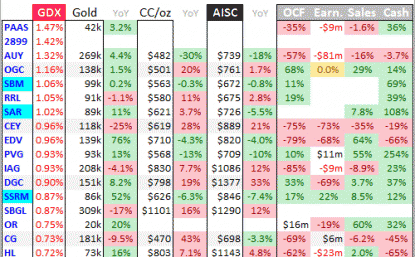
The recent weakness in Gold and gold mining stocks is not over. In fact, we are worried about another leg down getting underway.
If that comes to pass, we are positioned to profit from it. But I digress.
Long-term oriented investors and speculators should be aware of the near term trends but they should also be aware of the conditions that will lead to a shift from a bear market to a bull market.
Here, we focus on five factors that precede major bottoms in precious metals.
Gold Outperforms the Stock Market
Other than in 1985 through 1987 there has never been a real bull market in Gold without it outperforming the stock market. A weak stock market usually coincides with conditions that are favorable for precious metals. That’s either high inflation or economic weakness that induces policy that is usually bullish for precious metals. The 2016-2017 period failed to be a bull market because the equity market continued to outperform Gold. Note that the Gold to Stocks ratio bottomed prior to the 2001 and 2008 bottoms.
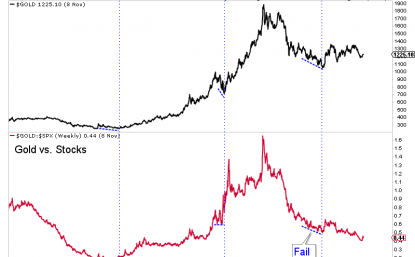
Gold Outperforms Foreign Currencies
Gold outperforming foreign currencies is important because this usually happens while the US Dollar remains in an uptrend. It signals relative strength in Gold and shows that Gold is not being held hostage by the strong dollar. It also can signal a coming peak in the dollar. Gold was outperforming foreign currencies prior to the 2001, 2008 and late 2015 bottoms. There are currently no positive divergences in place.
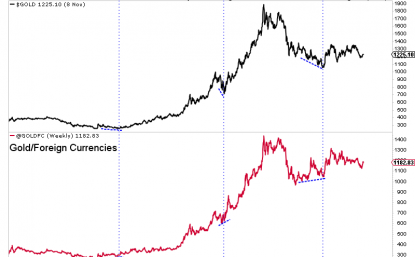
Major Peak in the US Dollar
This does not precede bottoms in Gold as it typically is a lagging indicator. But a list of “4” things does not carry the same weight as five. Anyway, Gold is not going to embark on a major, long-lasting bull market without a corresponding peak in the US Dollar. Sure, they can rise at the same time and for months on end. However, it’s difficult to imagine a multi-year bull market in Gold without a corresponding peak in the dollar. Peaks in 1993 and 2016 led to brief runs in Gold but those were nothing like the 1985 and 2001 peaks.
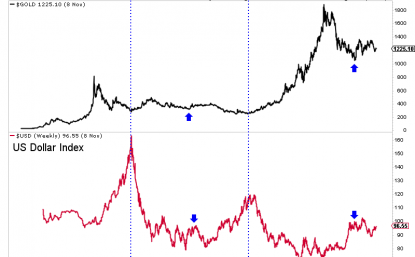
Gold Mining Stocks Crash
This is not a mandatory component of major bottoms but definitely is something that can occur before a major bottom. Below we plot GDM, which is the forerunner to GDX. Note that gold stocks essentially crashed into their late 2000 and late 2008 lows. They also crashed into their summer 2015 low which wasn’t the final low for the sector but was for the senior miners. The main point is that if gold mining stocks fall apart again it could very well be a sign that a bottom is almost imminent.
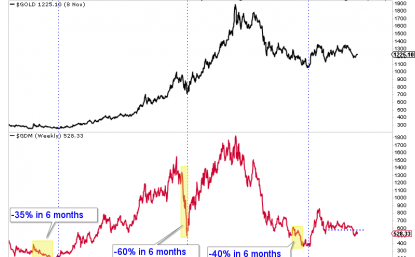
Fed Policy Change
Over the past 60 years, gold stocks have often bottomed almost immediately after the peak in the Fed Funds rate (FFR). In 10 of 12 rate cut cycles, gold stocks bottomed a median of one month and an average of two months after the peak in the FFR. The average gain of gold stocks following that low was 185%. There are also points where the gold stocks declined during a period of rate cuts or no Fed activity. Bottoms then were sometimes followed by the start of Fed hikes. However, given the current conditions, we are quite confident that gold stocks will bottom immediately after the Fed’s final rate hike.
Now you know what to look for to signal that a major bottom is imminent.
Better yet, consider our premium service which can help you ride out the downside and profit ahead of a major bottom in the sector. To prepare yourself for an epic buying opportunity in junior gold and silver stocks in 2019, consider learning more about our premiums service.
- US elections are here!
- Please click here now. Double-click to enlarge this big picture chart for gold.
- From both a technical and fundamental perspective, gold looks solid.
- This chart suggests that whatever happens in the US election, it’s going to be positive for gold.
- One of my biggest predictions for the fall of 2018 was that a US stock market sell-off would see gold and gold stocks begin to function as the ultimate safe haven.
- That happened exactly on cue, and to get an idea of how mainstream media is beginning to open their eyes to this theme, please click here now. Bloomberg Intelligence is highly respected by the global institutional investor community.
- It’s really unknown whether the stock market will rally or decline from here, but the odds are now astronomically high that when the next decline does happen…
- The world gold community will be smiling because their precious metal investments will perform admirably!
- Please click here now. The Fed’s QE and low rate programs incentivized corporations to launch enormous stock buyback programs and incentivized both retail and institutional investors to buy stock with borrowed money.
- Merrill’s chief equity market technician is very concerned about the current divergence between the price of the SP500 index and the total US market margin debt.
- I’ve predicted that as this business cycle ages, inflation would make a surprising appearance that would catch most analysts off guard.
- On that note, please click here now. In America, inflation could stage a shocking move to the upside if the emerging divergence between the interest rate on commercial bank excess reserves and the Fed Funds rate grows.
- Even if that doesn’t happen, global inflation is clearly on the move, and the move is to the upside!
- Please click here now. Western gold bugs may hate the Chinese government for good reasons, but that doesn’t change the fact that it generally acts more like a lean and mean corporation than like a government, in terms of efficiency.
- After accounting for inflation, Chinese real GDP growth is about 3%, and the same is true for India. In the West, most countries have flat or negative real GDP growth.
- The same is true for wage growth.
- The simple reality is that gold is becoming the world’s most stable asset because three billion Chindian citizens are maniacal savers, obsessed with gold, and getting richer.
- The standard of living of these citizens is increasing at a tremendous rate. An immigrant caravan headed towards the US border gets American citizens wildly excited while they buy no gold and try in vain to fix a US stock market price chase that has gone badly wrong.
- What’s missed in all the caravan-oriented excitement is that the entire caravan is composed of perhaps 10,000 people…
- While every single day there are about 50,000 babies born in India, and almost every one of them will become a maniacal gold buyer as they reach maturity.
- The bottom gold bull era line: Are babies golden? Absolutely! Gold-oriented Chindia is a titanic force that just keeps growing.
- Please click here now. Double-click to enlarge this short-term gold chart. Keep my big picture gold chart in mind when viewing this chart. A fabulous double-bottom pattern is in play.
- Please click here now. Double-click to enlarge this key GDX chart.
- There’s solid technical action taking place around a decent inverse H&S bottom pattern. It’s a consolidation of the upside breakout. Please click here now. Gold stock investors should prepare to surf a global inflationary wave, that is already shocking institutional analysts even though it is only in its infancy right now!
Risks, Disclaimers, Legal
Stewart Thomson is no longer an investment advisor. The information provided by Stewart and Graceland Updates is for general information purposes only. Before taking any action on any investment, it is imperative that you consult with multiple properly licensed, experienced and qualified investment advisors and get numerous opinions before taking any action. Your minimum risk on any investment in the world is: 100% loss of all your money. You may be taking or preparing to take leveraged positions in investments and not know it, exposing yourself to unlimited risks. This is highly concerning if you are an investor in any derivatives products. There is an approx $700 trillion OTC Derivatives Iceberg with a tiny portion written off officially. The bottom line: Are you prepared?

Lupaka Gold’s (TSX-V: LPK) Invicta Gold Project is on the brink of production, set to become Peru’s next producing gold mine.
However, everything is not going to plan…for the better.
What has been quietly observed is that (1) the grades are coming in higher than the PEA and (2) the company is already making plans to increase production above the PEA throughout rate of 350 tpd. All this means higher levels of production and cash flow once the actual mining commences later this year.
Recent underground sampling of mineralization is revealing an asset that offers more than originally outlined in the company’s April 2018 Preliminary Economic Assessment (“PEA”) which gives investors additional upside for any increases in mine output, improvement of grade and additional ounces to the overall resource.
The April 2018 PEA for the Invicta Mine outlined a mineral resource of 3 million tonnes of Indicated Mineral Resources at 5.78 grams per tonne (“g/t”) gold equivalent (“AuEq”) ounces using a 3.5-g/t cut-off grade (“COG”), and 600,000 tonnes of Inferred Mineral Resources at 5.49 g/t AuEq.
Within that resource the Company has a PEA that outlines an initial 6-year mine life that will produce produce a total of 669,813 tonnes of mineralized material processing 350 tonnes per day (“tpd”) at an average grade of 8.6 g/t Au-Eq. Lupaka’s grades included estimated metallurgical recoveries, and the true grade will likely be even higher than 8.5 g/t AuEq.
Just to highlight, with an all in sustaining cost (“ASIC”) of $575 per gold ounce equivalent, Lupaka Gold will be one of the lowest cost junior producers.
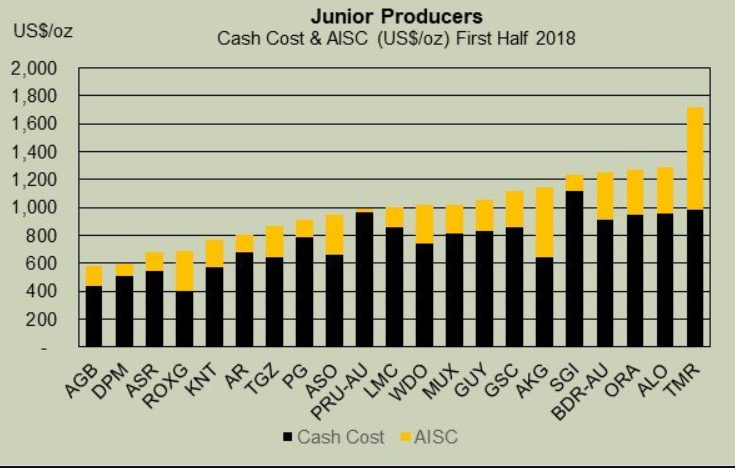
Source: AuCu Consulting, Ron Stewart (@RonStew12139302)
As part of the development work to put Invicta into production, Lupaka has been conducting channel sampling every 5 metres on all workings during development.
The results have demonstrated continuity of the high grade mineralization and additional potential that the Aetnea vein hosts.
In March 2018, the company released preliminary sample results:
- Sample assay values over the footwall vein averaged 9.86 g/t AuEq over 130 metres, with an average width of 6.1 metres (“m”);
- Sample assay values over the hanging wall split averaged 7.00 g/t AuEq over 70 m, with an average width of 6 m.
In June, Lupaka released further results from a underground sampling program on the newly developed 3430 production sublevel.
- 9.22 g/t AuEq over a strike length of 130 m, with an average sample width of 4.2 m.
The company provided additional results in July:
- Channel sample assay values from across the strike of the Atenea vein, within the raise development, returned an average of 23.45 g/t AuEq over a vertical height of approximately 30 m;
- Sampling returned significant grades such as sample number 2606E which returned 227.77 g/t AuEq over a width of 1.2 m.
In addition to the sampling, development and rehabilitation of the Invicta mine has provided ~6,500 tonnes of mineralized material from the 3400 Level and when sampled on surface returned an average grade of 7.21 g/t AuEq.
Grade consistency is always a problem with mining. However, it is appearing that the Invicta PEA outlined a muted gold grade on a smaller area of the known mineralization which does not highlight the potential for higher grade zones and the prospectivity of the area.
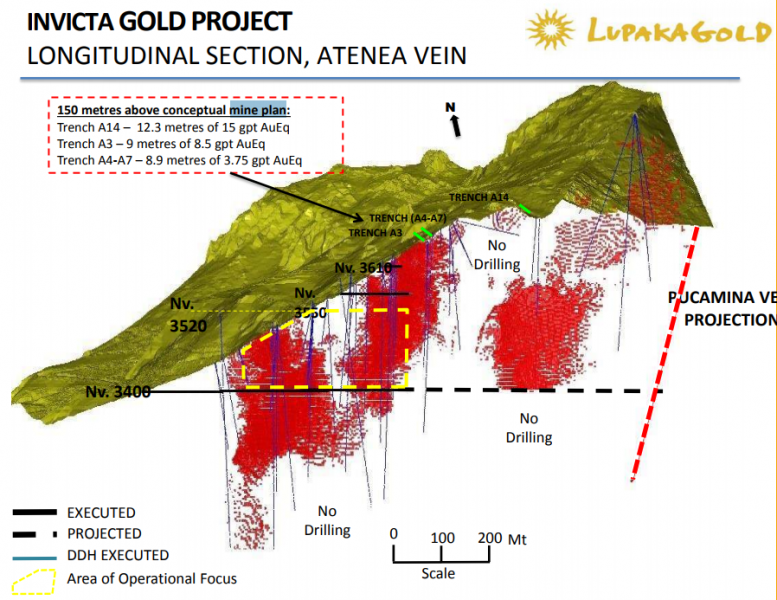
Higher grades could improve the bottom line as mining proceeds through the Aetnea vein and into the other zones around the current area of operational focus.
Past exploration at the Invicta mine property indicates that the property has considerable potential for mineral resource expansion through exploration.
Structural studies, geophysical and geochemical work conducted to date strongly suggest the potential for mineral resource expansion along existing mineralized structures.

Past sampling around Invicta revealed the exploration potential with many areas reporting grades greater than 6 g/t AuEq. mine
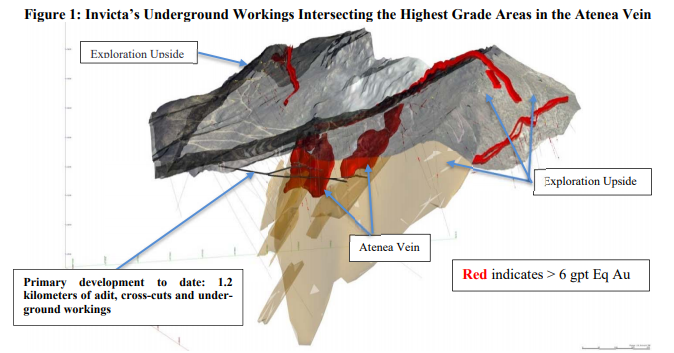
All in all, the focus on a smaller area for the PEA and initial mine plan reveals that the company’s plan has been to bring production online with a well defined resource with the Aetnea vein through underground mining with minimal capital expenditures, rather than trying to finance and build a large scale operation off the back.
With the commencement of limited toll mining in September, and the beginning of full scale production hopefully in October, Lupaka will have the necessary cash flow to conduct exploration and prove up more ounces in the ground and significantly alter the assumptions of the April 2018 PEA to extend the life of mine.
The next milestone is the final mining exploitation licence, which requires an inspection by the Peruvian Ministry of Mines and Energy.
The inspection will be performed before the end of October and upon receipt of the exploitation licence, the company will have the go ahead to produce at a rate of 400 tonnes per day, or 12,000 tonnes per month.
However, with the permit to operate at 400 tpd, the company could see its potential production increase by 14% from the 350 tpd production assumption outlined in the PEA, boosting the project’s cash flow.
Currently, shares in Lupaka gold are trading near year-lows which discounts a years’ worth of work and development that has improved access to the mine, defined a PEA, divestment of non primary assets, cash flow from initial toll mining and on the cusp of full scale mining.
The company laid out a plan to bring into production the Invicta mine with a small area of operational focus and a humble gold grade in comparison to recent sampling.
The plan is working and it is starting to reveal that there is more to the story than initially outlined…a good thing for investors.
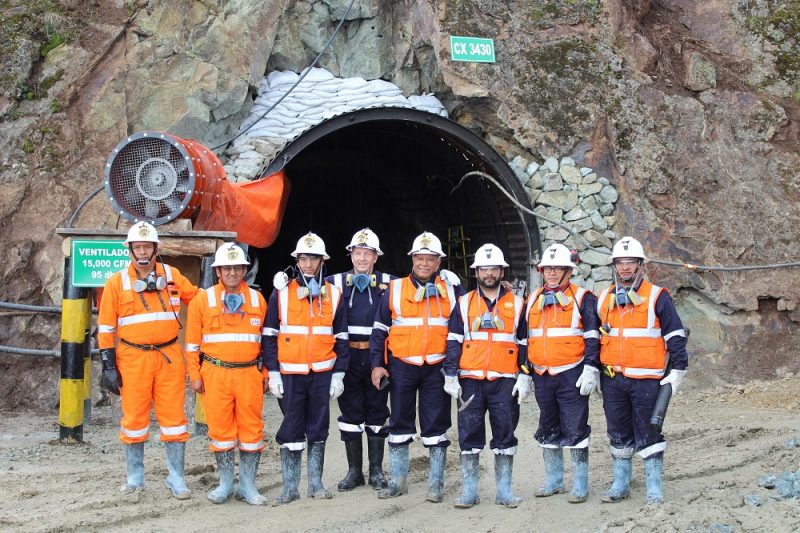
*The author of this article was compensated for the creation of this article in cash. The author picked up shares in the public market, ranging from prices of 14 cents to 20 cents over the past year. This article is meant to serve informational and marketing purposes only and not a technical report and does not constitute a buy recommendation. As always, please do your own diligence.
*The Mineral Resource Statement for the Invicta Project is tabulated to a cut-off grade of 3.0 g/t Au-Eq. Cut-off grades are based on a price of US$1,250 per ounce of gold, US$17.00 per ounce of silver, US$3.00 per pound of copper, US$1.05 per pound of lead and US$1.20 per pound of zinc. The equivalent gold calculation assumes mill recoveries of 85 percent for gold, 80 percent for silver, 82 percent for copper and lead and 77 percent for zinc
- Gold’s impressive rally continues to accelerate. Key fundamental and technical price drivers are playing a bullish song with almost perfect harmony.
- Please click here now. Double-click to enlarge what may be the most beautiful weekly chart continuation pattern in the history of markets.
- Note the awesome stance of the RSI and Stochastics oscillators as gold begins to ascend from the right shoulder low of the pattern.
- If Michelangelo could be brought back to life, he would surely consider the picture being painted by the current technical action on this gold chart to be a “bull era masterpiece”.
- Gold’s fabulous technical posture received a solid fundamental boost from two key central banks on Friday. Please click here now. The PBOC just announced an important change in price discovery for the yuan versus the dollar.
- Please click here now. The “tariffs tantrum” created a decline in the yuan versus the dollar, and that’s what created the decline in gold to the right shoulder low.
- The yuan is now rallying, and the PBOC announcement should give this rally some serious legs.
- If the rupee also begins a rally against the dollar as the strong demand season for gold begins in India, gold’s right shoulder rally could turn into a major barnburner!
- US central bank chair Jay Powell also added more fuel to gold’s rally on Friday, when he hinted that rates could be normalized by mid 2019. This powerful central banker also suggested that US GDP growth of 3% cannot be sustained for much longer.
- Many analysts hoped that the Trump administration could extend the business cycle and corporate tax cuts have certainly helped to do that.
- Unfortunately, Trump has shot most of his economic booster shot bullets, and his administration brings middle of the road republicanism to the table, not libertarianism.
- Given the current demographics of the United States (population age, debt, and a declining “petro-dollar”), it’s going very difficult to “make most of the citizens great” with this approach.
- Trump himself is a highly skilled business builder. Individuals with his incredible skills can thrive in almost any environment. In a socialist country like China, India, or Germany, Trump would likely be just as successful as he’s been in America, and perhaps even more so due to his incredible drive to overcome adversity.
- Unfortunately, the average business owner doesn’t have his skills or energy, and they need vastly more libertarian support than the US government can currently provide.
- The bottom line: US population demographics are horrific. House prices in most areas are unaffordable for almost anyone who isn’t rich or hasn’t inherited money. There is no incentive for industry to produce cheap electric cars. Property taxes are outrageously high and still rising relentlessly.
- To reach and sustain the kind of long term growth rates that Trump has targeted, the income tax and the capital gains tax can’t just be cut. They need to be eliminated completely.
- Back in 2014 I predicted that US GDP would peak in the 4% – 5% range in a single quarter during the 2017 – 2019 time frame. It happened in 2018. I’ve further predicted that GDP begins to fade in 2019 and steadily declines to the 1%-2% range. That prediction looks to be perfectly on track, and I’m sticking with it.
- Please click here now. Commerzbank is a member of both the LBMA and the COMEX. Their analytical work command tremendous respect in the institutional investment community.
- Their top analysts now suggest that gold will reach $1300 by year-end and $1500 by 2019. I don’t use time targets, but my weekly chart bull continuation pattern for gold bullion is perfectly in sync with their scenario.
- Please click here now. Double-click to enlarge this Chinese stock market chart. Events in America are lining up with events in China and India to create a picture-perfect gold price surge to the $1500 area in 2019.
- This Chinese stock market chart shows the FXI-NYSE ETF in a beautiful bull wedge pattern. The upside breakout that I’m forecasting would put Chinese gold buyers in a very good mood just as the strong demand season begins!
- Please click here now. Double-click to enlarge this key GDX chart. A Vanguard gold-oriented mutual fund is transitioning to a more “general commodity” holdings approach. That’s put pressure on gold stocks in a “one off” or “black swan” manner as the fund sells a lot of gold stocks to make the transition. The good news is that this selling seems to be largely complete now.
- I realise that the gold stocks decline may have caught some investors by surprise, but those with put options for insurance easily took it in stride. This is simply a great and unique opportunity to buy GDX and quality gold stocks near the base of my $21 – $18 accumulation zone.
- As the majestic rally from gold bullion’s right shoulder low accelerates, Vanguard’s selling ends, and gold stocks are poised to stage “hypersonic” outperformance against all asset classes. Key fundamental and technical price drivers will soon make all gold stock investors look and feel like they are King Kong, lording over a fabulous bull era!
The junior gold miners’ stocks have been thrashed in August, plummeting to brutal multi-year lows. Such carnage naturally left sentiment far more bearish than usual in this forsaken contrarian sector. But these extremely-battered gold-stock prices certainly aren’t justified fundamentally. Junior gold miners’ collective results from their just-completed Q2’18 earnings season prove their stock prices need to mean revert way higher.
Four times a year publicly-traded companies release treasure troves of valuable information in the form of quarterly reports. Companies trading in the States are required to file 10-Qs with the US Securities and Exchange Commission by 45 calendar days after quarter-ends. Canadian companies have similar requirements. In other countries with half-year reporting, many companies still partially report quarterly.
The definitive list of elite “junior” gold stocks to analyze comes from the world’s most-popular junior-gold-stock investment vehicle. This week the GDXJ VanEck Vectors Junior Gold Miners ETF reported $4.5b in net assets. Among all gold-stock ETFs, that was second only to GDX’s $8.4b. That is GDXJ’s big-brother ETF that includes larger major gold miners. GDXJ’s popularity testifies to the great allure of juniors.
Unfortunately this fame created serious problems for GDXJ a couple years ago, resulting in a stealthy major mission change. This ETF is quite literally the victim of its own success. GDXJ grew so large in the first half of 2016 as gold stocks soared in a massive upleg that it risked running afoul of Canadian securities laws. And most of the world’s smaller gold miners and explorers trade on Canadian stock exchanges.
Since Canada is the center of the junior-gold universe, any ETF seeking to own this sector will have to be heavily invested there. But once any investor including an ETF buys up a 20%+ stake in any Canadian stock, it is legally deemed to be a takeover offer that must be extended to all shareholders! As capital flooded into GDXJ in 2016 to gain junior-gold exposure, its ownership in smaller components soared near 20%.
Obviously hundreds of thousands of investors buying shares in an ETF have no intention of taking over gold-mining companies, no matter how big their collective stakes. That’s a totally-different scenario than a single corporate investor buying 20%+. GDXJ’s managers should’ve lobbied Canadian regulators and lawmakers to exempt ETFs from that 20% takeover rule. But instead they chose an inferior, easier fix.
Since GDXJ’s issuer controls the junior-gold-stock index underlying its ETF, it simply chose to unilaterally redefine what junior gold miners are. It rejiggered its index to fill GDXJ’s ranks with larger mid-tier gold miners, while greatly demoting true smaller junior gold miners in terms of their ETF weightings. This controversial move defying long decades of convention was done quietly behind the scenes to avoid backlash.
There’s no formal definition of a junior gold miner, which gives cover to GDXJ’s managers pushing the limits. Major gold miners are generally those that produce over 1m ounces of gold annually. For decades juniors were considered to be sub-200k-ounce producers. So 300k ounces per year is a very-generous threshold. Anything between 300k to 1m ounces annually is in the mid-tier realm, where GDXJ now traffics.
That high 300k-ounce-per-year junior cutoff translates into 75k ounces per quarter. Following the end of the gold miners’ Q2’18 earnings season in mid-August, I dug into the top 34 GDXJ components’ results. That’s simply an arbitrary number that fits neatly into the tables below. Although GDXJ included a staggering 71 component stocks this week, the top 34 accounted for a commanding 81.1% of its total weighting.
Out of these top 34 GDXJ companies, only 4 primary gold miners met that sub-75k-ounce-per-quarter qualification to be a junior gold miner! Their quarterly production is rendered in blue below, and they collectively accounted for just 8.9% of GDXJ’s total weighting. But even that is really overstated, as 3 of these are long-time traditional major silver miners that are increasingly diversifying into gold in recent years.
GDXJ is inarguably now a pure mid-tier gold-miner ETF, and really ought to be advertised as such. While its holdings include some of the world’s best gold miners with huge upside potential, the great majority definitely aren’t classic junior gold miners. At least this ETF’s big composition changes are stabilizing, as Q2’18 was the first quarter since mid-2016 where GDXJ’s components didn’t radically change year-over-year.
I’ve been doing these deep quarterly dives into GDXJ’s top components for years now. In Q2’18, fully 32 of the top 34 GDXJ components were also GDX components! These are separate and distinct ETFs, a “Gold Miners ETF” and a “Junior Gold Miners ETF”. So they shouldn’t have to own many of the same companies. In the tables below I highlighted the symbols of rare GDXJ components not also in GDX in yellow.
These 32 GDX components accounted for 78.4% of GDXJ’s total weighting, not just its top 34. They also represented 38.0% of GDX’s total weighting. Thus nearly 4/5ths of this “Junior Gold Miners ETF” is made up by over 3/8ths of the major “Gold Miners ETF”! These GDXJ components also in GDX start at the 10th-highest weighting in that latter larger ETF and extend down to 47th. GDXJ is mostly smaller GDX stocks.
In a welcome change from GDXJ’s vast component turmoil of recent years, only 2 of its top 34 stocks are new since Q2’17. Their symbols are highlighted in light blue below. Thus the top GDXJ components’ collective results are finally getting comparable again in year-over-year terms. Analyzing ETFs is much easier if their larger components aren’t constantly in flux. Hopefully changes going forward are relatively minor.
Despite all this, GDXJ remains the leading “junior-gold” benchmark. So every quarter I wade through tons of data from its top components’ latest results, and dump it into a big spreadsheet for analysis. The highlights make it into these tables. Most of these top 34 GDXJ gold miners trade in the US and Canada, where comprehensive quarterly reporting is required by regulators. But others trade in Australia and the UK.
In these countries and most of the rest of the world, regulators only mandate that companies report their results in half-year increments. Some do still issue quarterly production reports, but don’t release financial statements. There are wide variations in reporting styles, data presented, and release timing. So blank fields in these tables mean a company hadn’t reported that particular data for Q2’18 as of this Wednesday.
The first couple columns of these tables show each GDXJ component’s symbol and weighting within this ETF as of this week. While most of these stocks trade on US exchanges, some symbols are listings from companies’ primary foreign stock exchanges. That’s followed by each gold miner’s Q2’18 production in ounces, which is mostly in pure-gold terms. That excludes byproduct metals often present in gold ore.
Those are usually silver and base metals like copper, which are valuable. They are sold to offset some of the considerable costs of gold mining, lowering per-ounce costs and thus raising overall profitability. In cases where companies didn’t separate out gold and lumped all production into gold-equivalent ounces, those GEOs are included instead. Then production’s absolute year-over-year change from Q2’17 is shown.
Next comes gold miners’ most-important fundamental data for investors, cash costs and all-in sustaining costs per ounce mined. The latter directly drives profitability which ultimately determines stock prices. These key costs are also followed by YoY changes. Last but not least the annual changes are shown in operating cash flows generated, hard GAAP earnings, sales, and cash on hand with a couple exceptions.
Percentage changes aren’t relevant or meaningful if data shifted from positive to negative or vice versa, or if derived from two negative numbers. So in those cases I included raw underlying data rather than weird or misleading percentage changes. This whole dataset together offers a fantastic high-level read on how the mid-tier gold miners are faring fundamentally as an industry. August’s plunge wasn’t righteous.
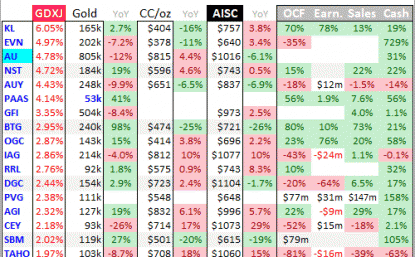
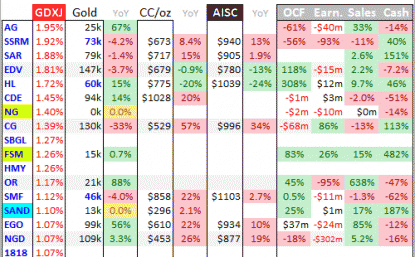
It was great to see GDXJ’s top 34 components almost unchanged from Q2’17, with only two new stocks in those ranks. My previous essays on GDXJ components’ quarterly results had been a sea of light blue since 2016. But one of the new components in Q2’18 is inexplicably the giant largely-African miner AngloGold Ashanti. It produced an enormous 805k ounces of gold last quarter, the largest in GDXJ by far.
Remember that major-gold-miner threshold has long been 1m+ ounces per year. AU’s production is annualizing to over 3x that, making this company the world’s 3rd-largest gold miner last quarter. Why on earth would managers running a “Junior Gold Miners ETF” even consider AngloGold Ashanti? It is as far from junior-dom as gold miners get. Having so many of the same stocks in both GDXJ and GDX is a big problem.
Such massive overlap between these two ETFs is a huge lost opportunity for VanEck. It owns and manages GDX, GDXJ, and even the MVIS indexing company that decides exactly which gold stocks are included in each. With one company in total control, there’s no need for any overlap in the underlying companies of what should be two very-different gold-stock ETFs. Inclusion ought to be mutually-exclusive.
VanEck could greatly increase the utility of its gold-stock ETFs and thus their ultimate success by starting with one big combined list of the world’s better gold miners. Then it could take the top 20 or 25 in terms of annual gold production and assign them to GDX. Based on Q2’18 production, that would run down near 127k or 92k ounces per quarter. Then the next-largest 30 or 40 gold miners could be assigned to GDXJ.
Getting smaller gold miners back into GDXJ would be a huge boon for the junior-gold-mining industry. Most investors naturally assume this “Junior Gold Miners ETF” owns junior gold miners, which is where they are trying to allocate their capital. But since most of GDXJ’s funds are instead diverted into much-larger mid-tiers and even some majors, the juniors are effectively being starved of capital intended for them.
That’s one of the big reasons smaller gold miners’ stock prices are so darned low. They aren’t getting enough capital inflows from gold-stock-ETF investing. So their share prices aren’t bid higher. They rely on issuing shares to finance their exploration projects and mine builds. But when their stock prices are down in the dumps, that is heavily dilutive. So GDXJ is strangling the very industry its investors want to own!
Back to these mid-tier gold miners’ Q2’18 results, production is the best place to start since that is the lifeblood of the entire gold-mining industry. These top 34 GDXJ gold miners that had specifically reported Q2 production as of the middle of this week produced 4467k ounces. That surged a massive 24.7% YoY, implying these miners are thriving. But that’s almost all driven by that huge 805k-ounce boost from AU’s inclusion.
Without AngloGold Ashanti which wasn’t there in Q2’17, the rest of the top 34 GDXJ gold miners saw their total production climb 2.2% YoY to 3662k ounces. That’s a little behind the 3.0% annual growth in overall global mine production in Q2’18 according to the World Gold Council’s latest Gold Demand Trends report. But these mid-tier miners are still faring far better than the majors that dominate that other GDX ETF.
As discussed last week in my essay on the GDX gold miners’ Q2’18 results, their production adjusted for quarterly data availability plunged a sharp 7.7% YoY! With big economically-viable gold deposits getting increasingly hard to discover, the majors are really struggling to replace depleting production. So much of the growth is coming from the mid-tiers and juniors, which will help their stock prices outperform the majors.
Starting from far-lower production bases, most of the smaller gold miners can ramp production by adding single new mines. These are often modest in scale and cost compared to the giant mines the majors need to target. Since growing production greatly boosts profits, investment capital will increasingly flow into mid-tier gold miners in coming years. So GDXJ’s upside should well outpace the major-dominated GDX’s.
For all GDXJ’s faults, it does still offer investors exposure to much-smaller gold miners. The average quarterly production of all the top 34 GDXJ miners reporting it in Q2 was 144.1k ounces. That is 44% smaller than the 258.3k averaged by the top 34 GDX miners last quarter. And again AU’s crazy inclusion really skews this. Ex-AU, the GDXJ average falls to 122.1k. That annualizes to 488k, solidly in the mid-tier realm.
With today’s set of top-34 GDXJ gold miners achieving relatively-good production growth, their costs per ounce should’ve declined proportionally. Higher production yields more gold to spread mining’s big fixed costs across. And lower per-ounce costs naturally lead to higher profits. So production growth is highly sought after by gold-stock investors, with companies able to achieve it commanding premium prices.
There are two major ways to measure gold-mining costs, classic cash costs per ounce and the superior all-in sustaining costs per ounce. Both are useful metrics. Cash costs are the acid test of gold-miner survivability in lower-gold-price environments, revealing the worst-case gold levels necessary to keep the mines running. All-in sustaining costs show where gold needs to trade to maintain current mining tempos indefinitely.
Cash costs naturally encompass all cash expenses necessary to produce each ounce of gold, including all direct production costs, mine-level administration, smelting, refining, transport, regulatory, royalty, and tax expenses. In Q2’18, these top 34 GDXJ-component gold miners that reported cash costs averaged $631 per ounce. That was actually up a slight 0.5% YoY, contrary to what you’d expect with higher production.
The majority of reporting gold miners saw cash costs rise significantly last quarter. There were plenty of challenges at various individual mines, including unexpected downtimes and lower ore grades. Both of those yield fewer ounces to bear the burden of gold mining’s big fixed costs. General price inflation is also mounting thanks to the trillions of dollars of money central banks conjured out of thin air over the past decade.
$631 per ounce is still very healthy, not much worse than the GDX majors’ average of $610 last quarter. That means these elite mid-tier gold miners could temporarily weather gold prices way down into the mid-$600s and still keep their mines running! At worst in mid-August, gold plunged to $1174 on close driven by epic all-time-record gold-futures short selling. Gold had fallen 4.1% month-to-date by that point, a big loss.
But the GDXJ gold miners suffered disproportionally, with this ETF’s price plummeting 15.5% MTD in sympathy with gold! That 3.8x downside leverage was excessive, the result of irrational herd sentiment. GDXJ’s share price was crushed to a brutal 2.4-year low, implying these miners are in fundamental peril. But with gold still trading a whopping 86% above their cash costs even at recent lows, that clearly wasn’t the case.
Way more important than cash costs are the far-superior all-in sustaining costs. They were introduced by the World Gold Council in June 2013 to give investors a much-better understanding of what it really costs to maintain gold mines as ongoing concerns. AISCs include all direct cash costs, but then add on everything else that is necessary to maintain and replenish operations at current gold-production levels.
These additional expenses include exploration for new gold to mine to replace depleting deposits, mine-development and construction expenses, remediation, and mine reclamation. They also include the corporate-level administration expenses necessary to oversee gold mines. All-in sustaining costs are the most-important gold-mining cost metric by far for investors, revealing gold miners’ true operating profitability.
These top 34 GDXJ gold miners reporting AISCs saw them average $886 per ounce in Q2’18. That was also up a modest 0.9% YoY, so costs didn’t decline proportionally with rising production. Still $886 is an excellent level compared to prevailing gold prices, and competitive with the GDX majors which averaged $856 last quarter. $886 is right in line with the past four quarters’ trend of $879, $877, $855, and $923 too.
The fundamental implications of this are very bullish, proving that this month’s gold-stock capitulation was purely an overdone herd-sentiment thing. Gold averaged $1306 in Q2’18, up 3.9% YoY. That means the top GDXJ gold miners were earning average profits just under $420 per ounce. Thanks to AISCs mostly holding the line and modestly-higher gold prices, those earnings rose a solid 10.7% YoY from $379 in Q2’17.
With gold mining considerably more profitable last quarter than a year earlier, you’d think the gold-stock prices would’ve been proportionally higher. Yet GDXJ’s average price in Q2 still slipped 1.1% lower YoY, which makes no sense fundamentally. And even if August’s capitulation-grade $1175 gold was able to magically persist as if those crazy-record gold-futures shorts were never covered, gold mining is still very profitable.
At Q2’18’s average AISCs which are again right in line with recent years’ levels, $1175 gold would still yield hefty $289-per-ounce profits for the mid-tier gold miners. Those don’t justify deep multi-year lows in gold-stock prices. And these profits will balloon dramatically as gold inevitably mean reverts much higher. Extreme gold-futures short-covering buying is imminent, and will be proportional to August’s record shorting.
The impact of higher gold prices on mid-tier-gold-miner profitability is easy to model. Assuming flat all-in sustaining costs at Q2’s $886 per ounce, 10%, 20%, and 30% gold rallies from mid-August’s lows would lead to collective gold-mining profits surging 40%, 81%, and 122%! And another 30% gold upleg isn’t a stretch at all. In the first half of 2016 alone after the first stock-market corrections in years, gold soared 29.9%.
GDXJ skyrocketed 202.5% higher in 7.0 months in largely that same span! Gold-mining profits and thus gold-stock prices surge dramatically when gold is powering higher. Years of neglect from investors have forced the gold miners to get lean and efficient, which will really amplify their fundamental upside during the next major gold upleg. The investors and speculators who buy in early and cheap could earn fortunes.
As long as the gold miners can produce gold at all-in sustaining costs way below prevailing gold prices, they will generate big profits for investors. Eventually their stock-price levels have to reflect their true underlying profitability. With $1175+ gold and $886 AISCs, the mid-tier gold miners’ stocks must mean revert way higher. Their extreme low levels today are fundamentally absurd, they can’t and won’t last for long.
With GDXJ’s radical composition changes finally settling down, the rest of its top 34 components’ core fundamentals are finally comparable year-over-year again. It’s nice to have that massive rejiggering in GDXJ’s underlying index past us. These elite mid-tier miners’ total revenues climbed 9.3% YoY to $5558m, well outpacing gold’s 3.9% YoY gain. That 2.2% higher production excluding AngloGold Ashanti also helped.
Those sales helped generate cash flows from operations of $1384m. While 5.1% lower YoY, that is still massively positive for this small contrarian sector. As long as gold mines are yielding far more cash than they cost to run, the mid-tier gold miners remain fundamentally healthy. Positive cash flows build capital necessary to expand operations, and helped drive these miners’ cash war chests up 9.3% YoY to $6784m in Q2.
But their hard GAAP profits as reported to regulators collectively looked terrible, collapsing from a strong $751m in Q2’17 to a big $146m loss in Q2’18! Is that the fundamental monkey wrench justifying these wretched stock-price levels? Not at all, as big unusual items flushed through bottom lines can make profits comparisons very misleading. There were two huge non-recurring items that mostly drove this big swing.
A year ago in Q2’17, elite mid-tier miner IAMGOLD reported a colossal $524m one-time non-cash gain from the reversal of mine-impairment charges. That accounted for nearly 70% of the top 34 GDXJ gold miners’ overall profits that quarter! Without that unusual item, their total Q2’17 profits were just $227m. Another unusual item heavily skewed last quarter’s latest profits, coming from mid-tier gold miner New Gold.
Gold mining is very challenging and risky, with many problems not evident until mining is well underway. New Gold’s serious troubles illustrate why diversifying capital across multiple gold miners is essential for all contrarian investors. NGD’s young Rainy River gold mine isn’t living up to potential due to variability in ore grades and processing. So in late July NGD slashed Rainy River’s 2018 production outlook by a huge 30%!
Not only did NGD’s stock crater, but this Rainy River situation is so bad New Gold recorded a $282m impairment charge on that mine! Such unusual non-recurring items flow directly into profits. Without that New Gold disaster, the top 34 GDJX gold miners’ total GAAP earnings in Q2’18 were $136m. While still down a major 40.2% YoY, that $91m drop is a fraction the size of the $897m including those unusual items.
The mid-tier gold miners’ recently-reported solid-to-strong Q2’18 results prove that their brutal plunge in August wasn’t fundamentally righteous. Like all capitulations fueled by cascading stop-loss selling, it was merely a sentimental and technical thing. As gold surges on the record futures short-covering buying that is imminent, the battered gold stocks will mean revert dramatically higher. And the mid-tiers will lead the way.
While GDXJ should certainly no longer be advertised as a “Junior Gold Miners ETF”, it offers exposure to some of the best mid-tier gold miners on the planet. It’s really growing on me, I like this new GDXJ way better than GDX. That being said, GDXJ is still burdened by overdiversification and way too many gold miners that shouldn’t be in there. They are either too large, are saddled with inferior fundamentals, or both.
So the best way to play the gold miners’ coming massive mean-reversion bull is in individual stocks with superior fundamentals. Their gains will ultimately trounce the major ETFs like GDXJ and GDX. There’s no doubt carefully-handpicked portfolios of elite gold and silver miners will generate much-greater wealth creation. GDXJ’s component list is a great starting point, but pruning it way down offers far-bigger upside.
At Zeal we’ve literally spent tens of thousands of hours researching individual gold stocks and markets, so we can better decide what to trade and when. As of the end of Q2, this has resulted in 1012 stock trades recommended in real-time to our newsletter subscribers since 2001. Fighting the crowd to buy low and sell high is very profitable, as all these trades averaged stellar annualized realized gains of +19.3%!
The key to this success is staying informed and being contrarian. That means buying low when others are scared, before undervalued gold stocks soar much higher. An easy way to keep abreast is through our acclaimed weekly and monthly newsletters. They draw on my vast experience, knowledge, wisdom, and ongoing research to explain what’s going on in the markets, why, and how to trade them with specific stocks. Subscribe today and take advantage of our 20%-off summer-doldrums sale! We’re redeploying stopped capital in new gold-stock trades at extreme fire-sale prices.
The bottom line is the mid-tier gold miners reported solid-to-strong fundamentals in their recent Q2’18 results. They were able to modestly grow their production despite the majors’ falling rather sharply. More gold mined combined with essentially-flat costs and higher average gold prices fueled solid profits growth. The mid-tiers’ production costs were far below prevailing gold prices even at mid-August’s deep capitulation lows.
That gold plunge that dragged gold stocks sharply lower was driven by crazy-all-time-record gold-futures short selling. Those extreme positions must soon be closed with proportional buying, which will catapult gold sharply higher. With gold-stock prices trading at such fundamentally-absurd levels today, they ought to soar and really leverage gold’s coming mean-reversion gains. Their post-capitulation upside is huge.
Last week GDX and GDXJ were down almost 12% at their lows on Thursday. Since then, they’ve recovered but only a tiny fraction of recent losses.
The crash did result in the miners reaching an extreme oversold condition while trading around long-term support at their December 2016 lows. It was the perfect setup for shorts to cover. That combination often results in at least a relief rally.
While a rally is underway, where it goes from here remains to be seen.
One thing to keep in mind, the recent decline was the result of a technical breakdown that followed months and months of consolidation. It’s extremely unlikely to immediately reverse course.
With that said, let’s keep in mind the measured downside targets.
For GDX, the downside target is $16.50-$17.00. For GDXJ, it’s $23-$24 and for Silver it is $12.70-$13.10.
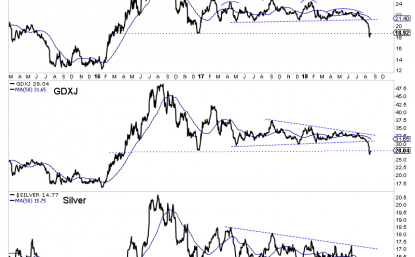
On the sentiment front we should note that Gold’s net speculative position reached 1.5% of open interest. That is the second lowest reading in the past 17 years. Does that mean this is December 2015 or 2001 for Gold?
Do note that sentiment was at a similar level twice in 2013 and Gold trended lower after a rebound. Moreover, look at what happened in the 1980s and 1990s.
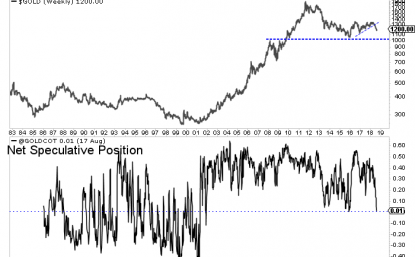
With the net speculative position already down to 1.5%, it figures to go negative if Gold is going to test its low at $1040/oz or even $1000/oz. If you think sentiment cannot get worse, think again.
Ultimately, its not sentiment or technicals that will decide a major bottom but fundamentals. After studying decades of history as well as the current market environment, we became convinced that precious metals will not begin a bull market until the Federal Reserve is done hiking rates.
Consider the following.
Over the past 60 years, in 10 of the last 12 rate hike cycles gold stocks boast an average gain of 185% with a minimum gain of 54%. The advance began on average one month and a median of two months after the Fed Funds rate peaked.
The precious metals sector is currently extremely oversold and a relief rally is underway. It should last at least a few more weeks and maybe a few months. However, the primary trend is down and there are downside targets that are even lower. Our plan is to let the rally run its course and when the time is right, go short again.
If you would like to receive our free newsletter via email, simply enter your email address below & click subscribe.
CONNECT WITH US
Tweets
Tweet with hash tag #miningfeeds or @miningfeeds and your tweets will be displayed across this site.
MOST ACTIVE MINING STOCKS
Daily Gainers
 |
CMB.V | +900.00% |
         |
CCD.V | +100.00% |
         |
CASA.V | +30.00% |
         |
AAZ.V | +25.00% |
   |
RMI.AX | +25.00% |
   |
POS.AX | +25.00% |
         |
KGC.V | +20.00% |
         |
GDX.V | +20.00% |
         |
LPK.V | +16.67% |
         |
CCE.V | +16.67% |

 Follow us on Twitter
Follow us on Twitter Become our facebook fan
Become our facebook fan







